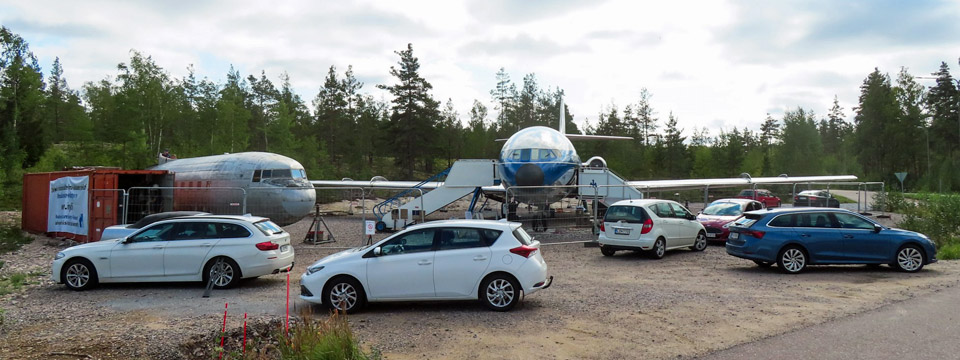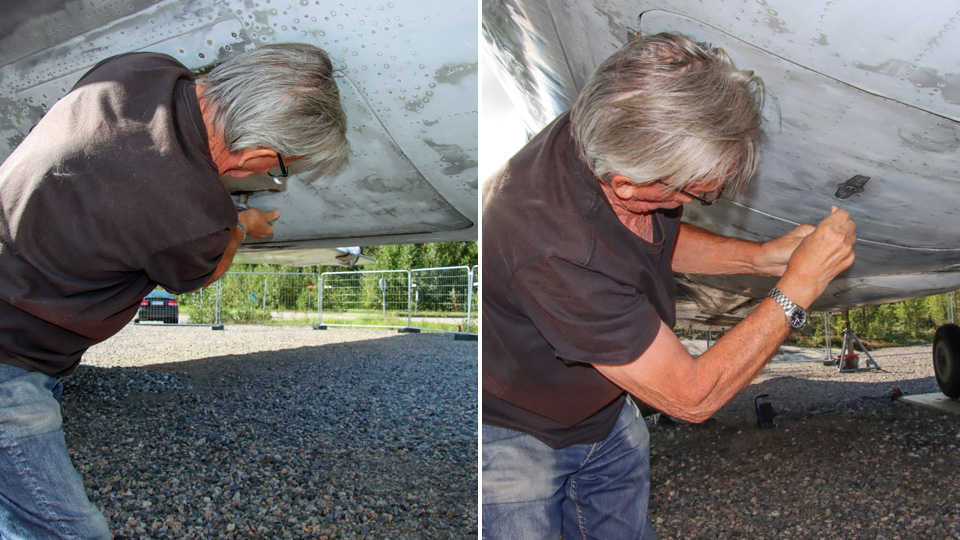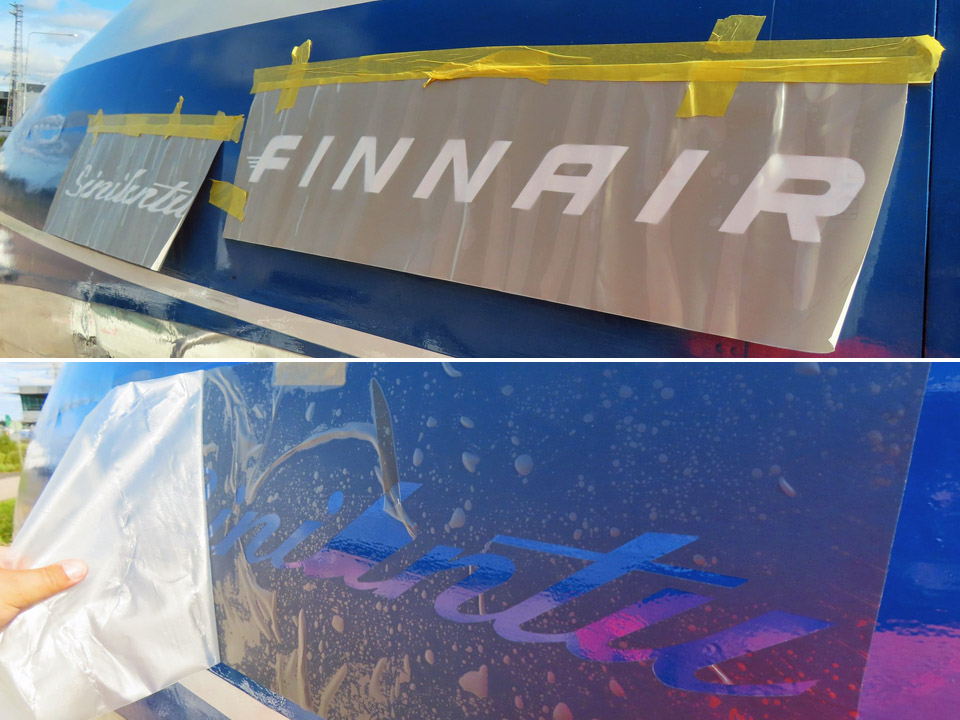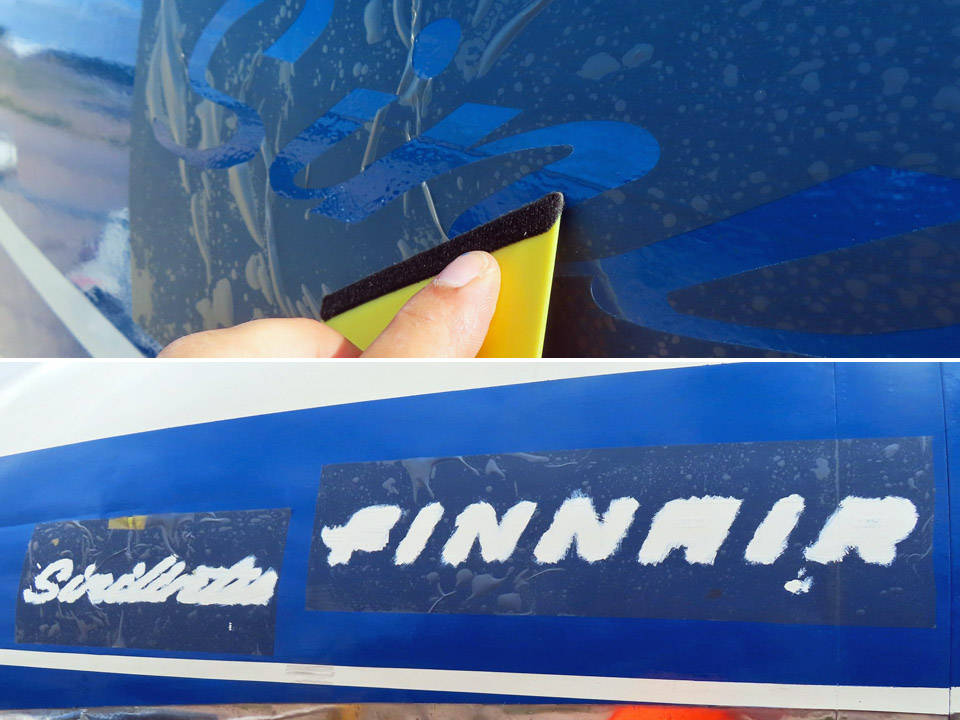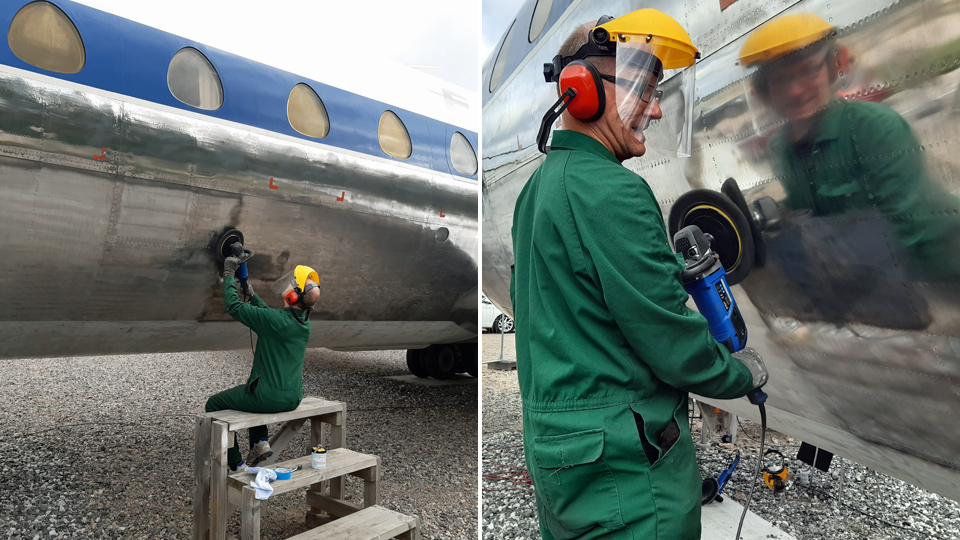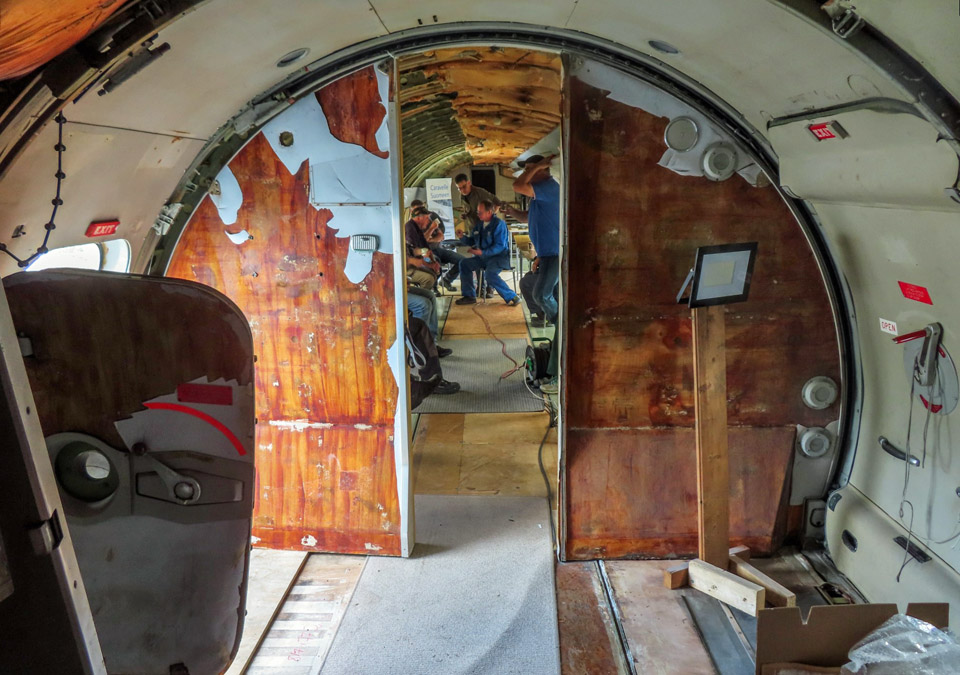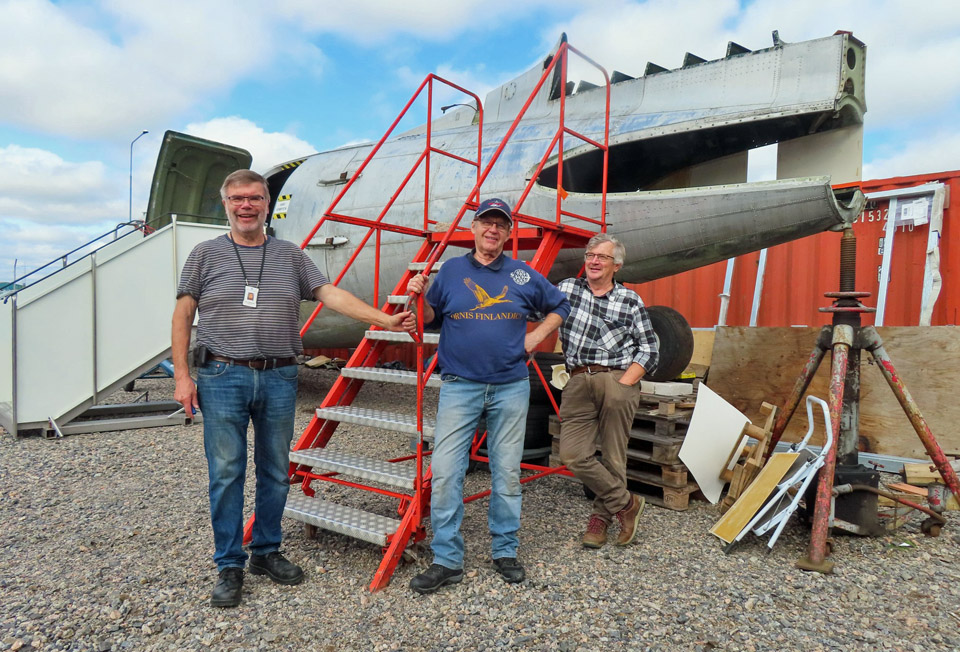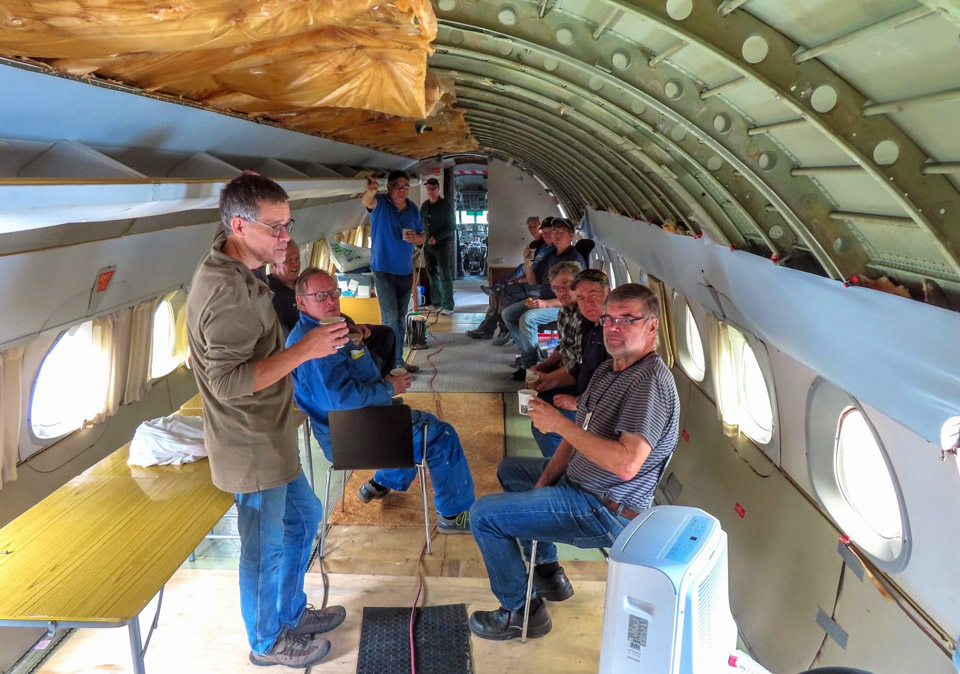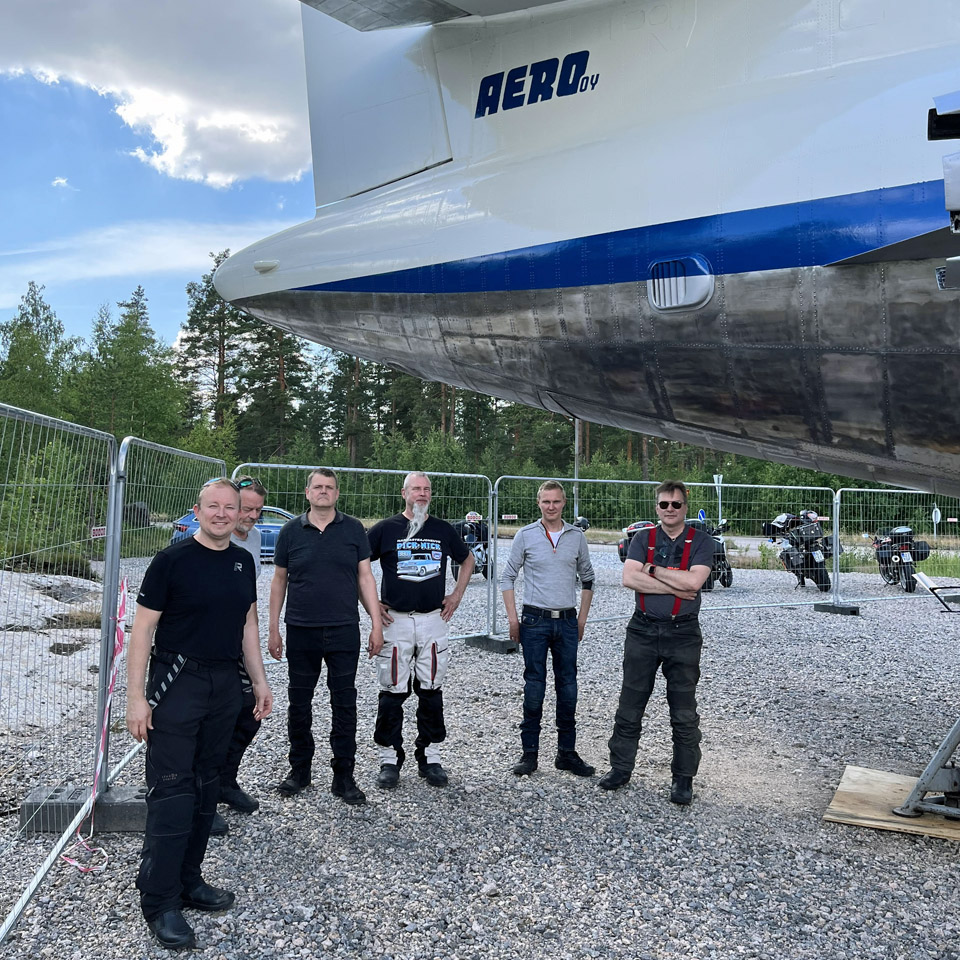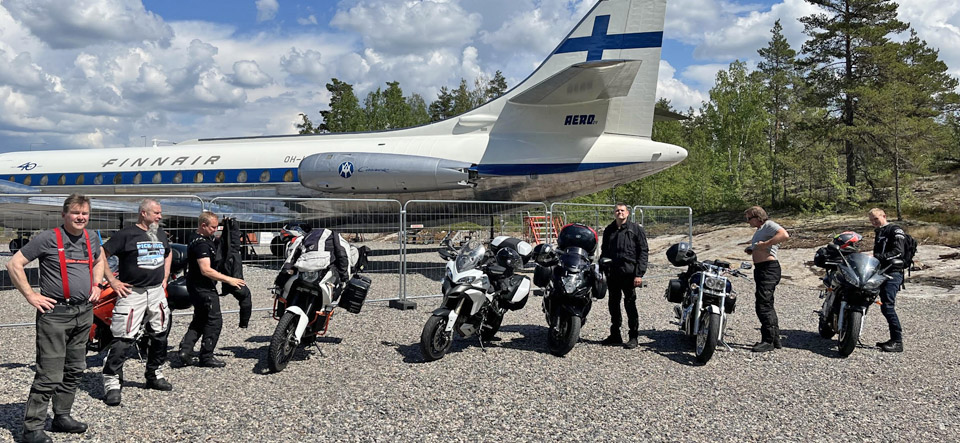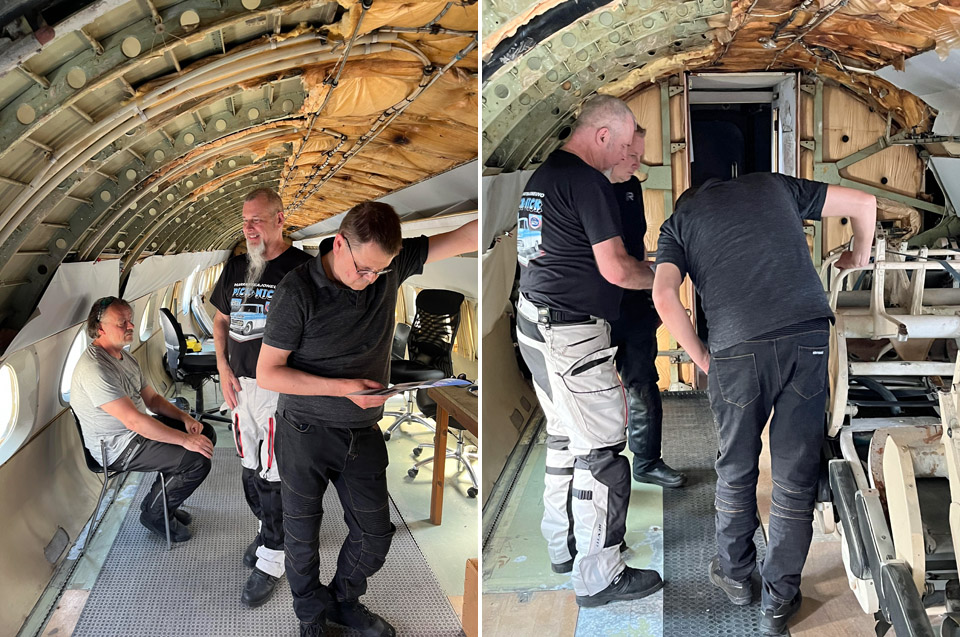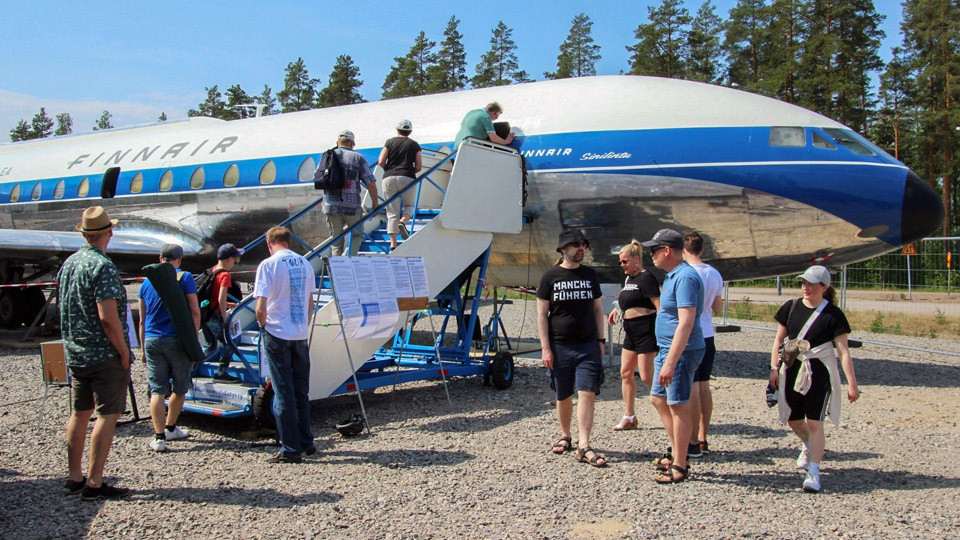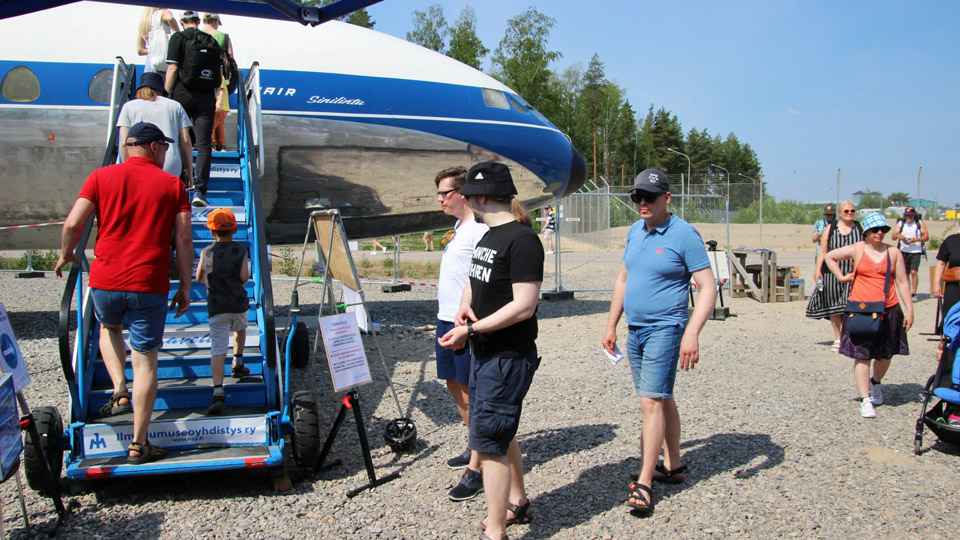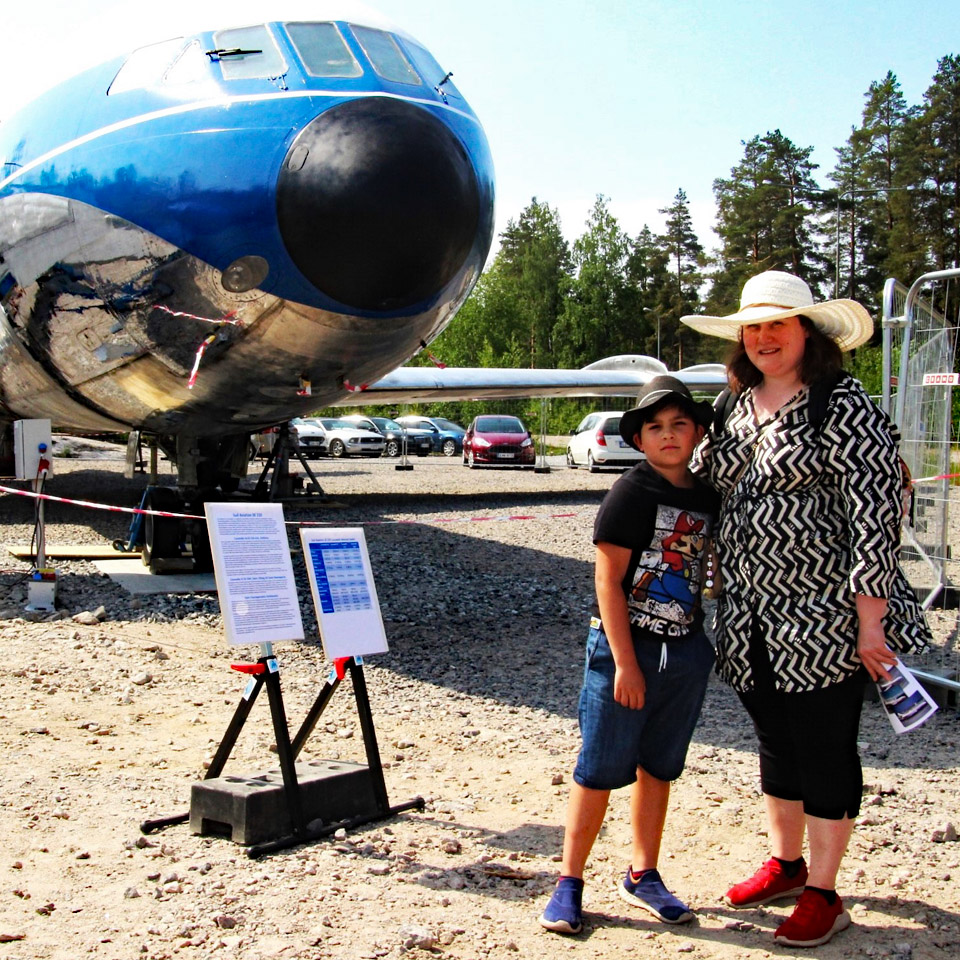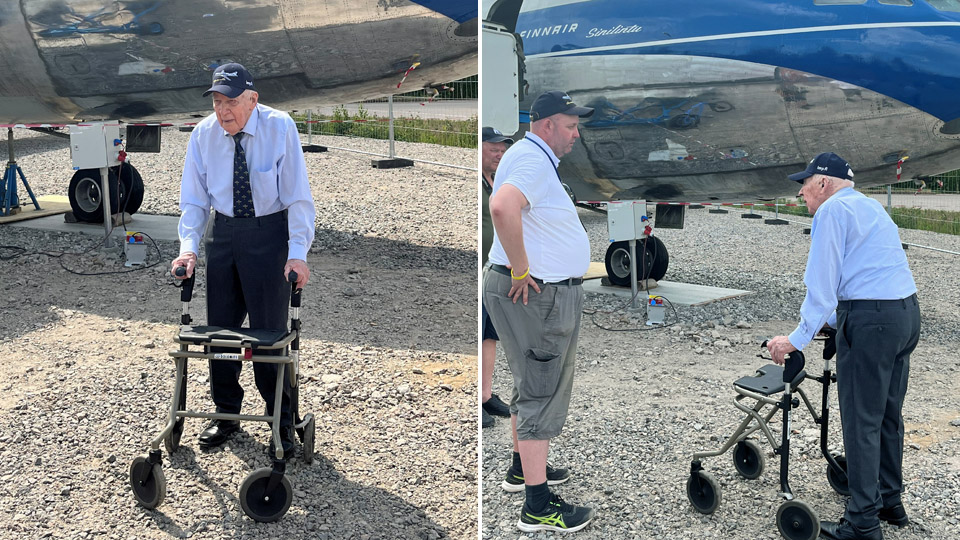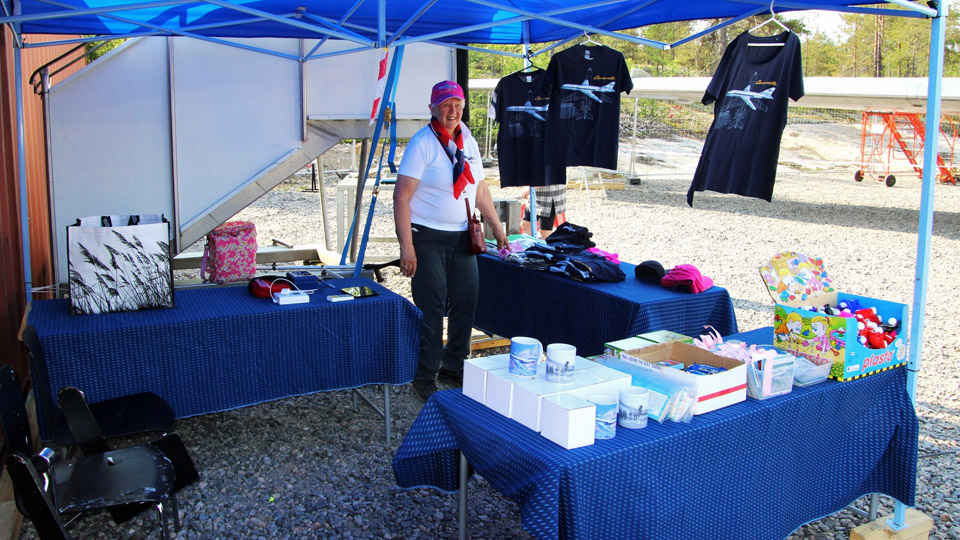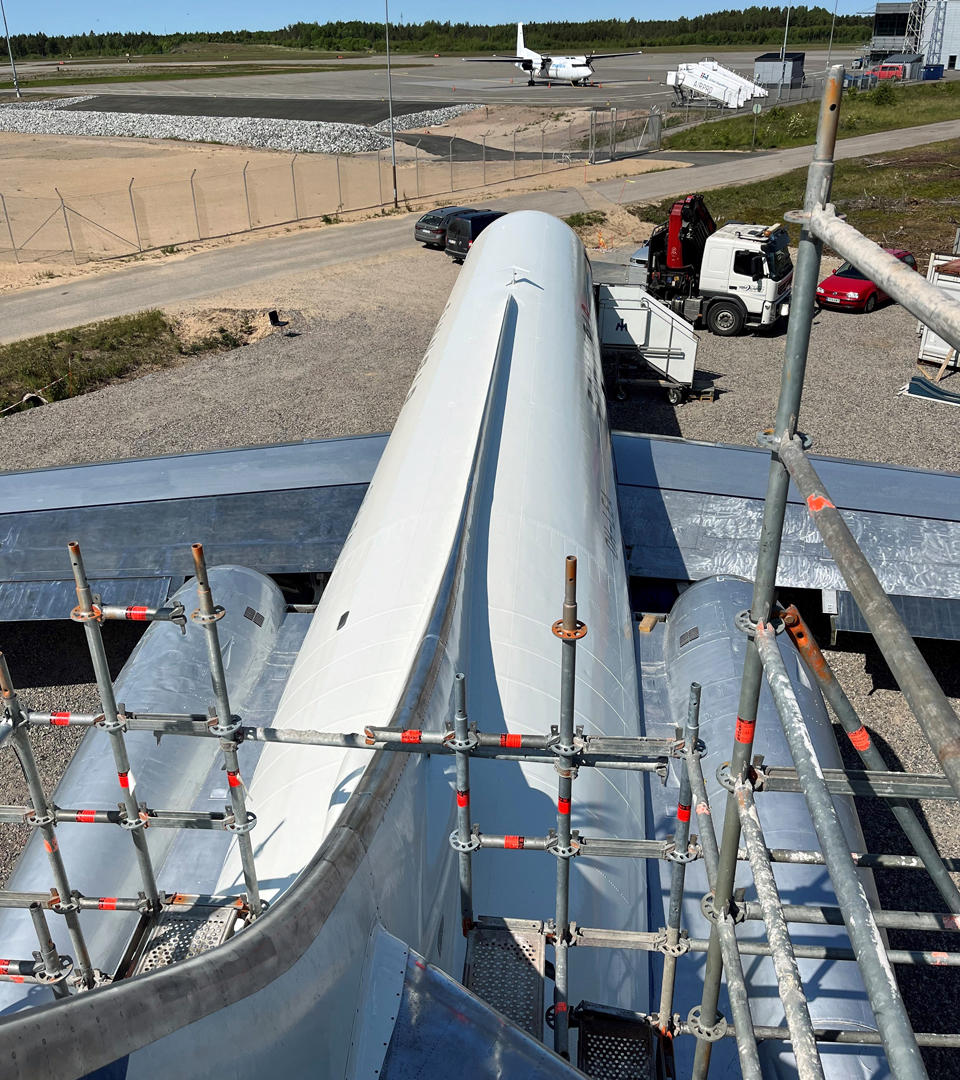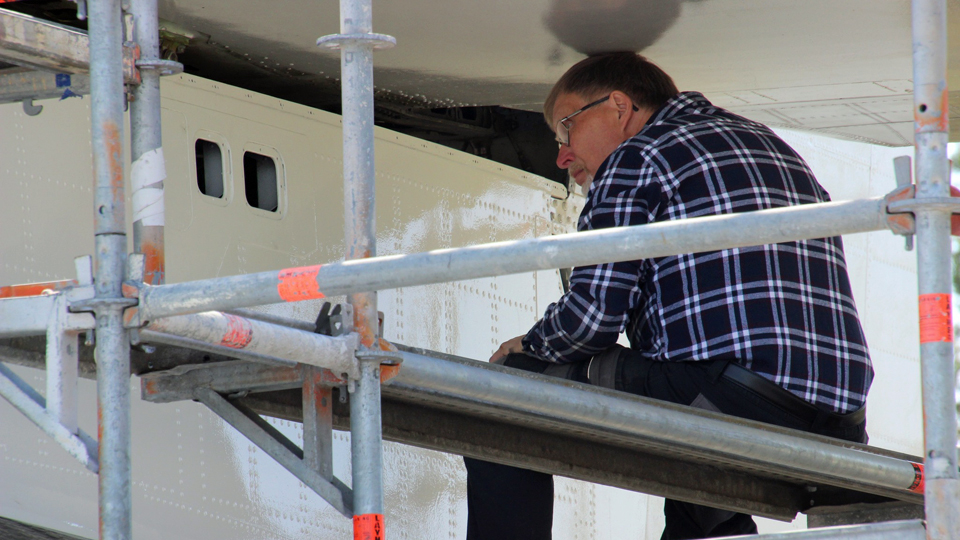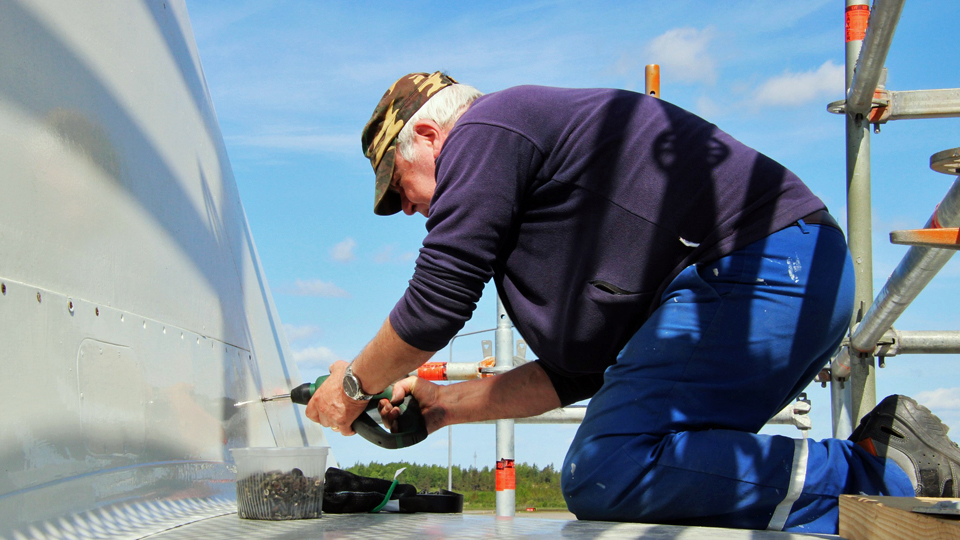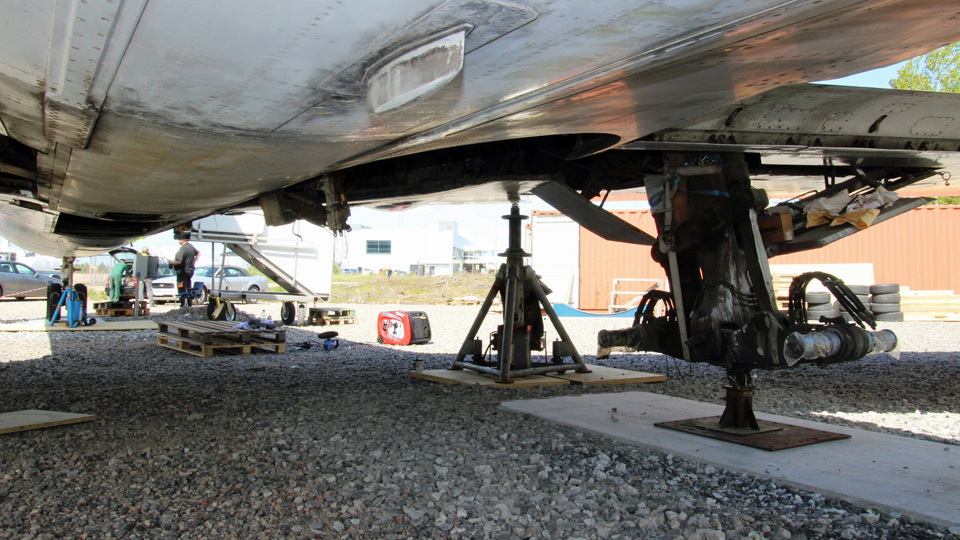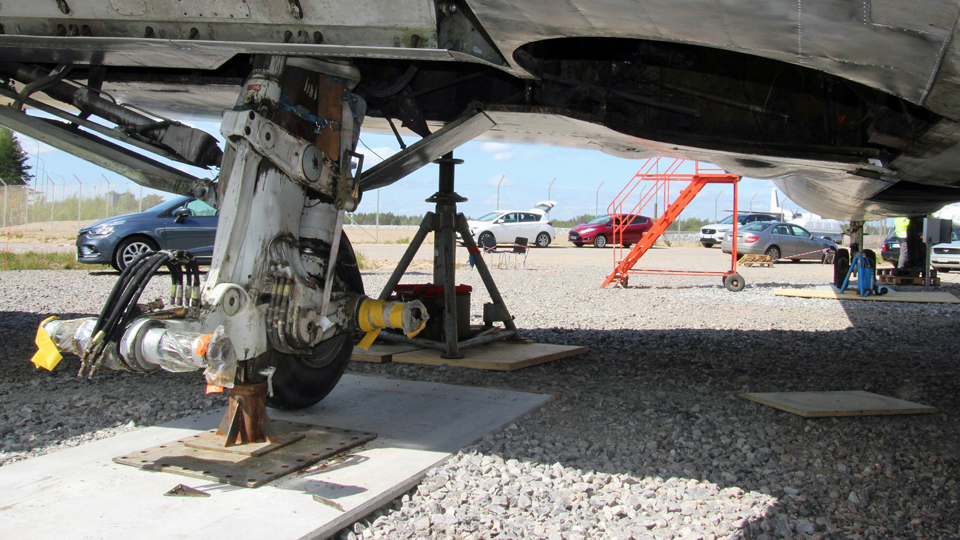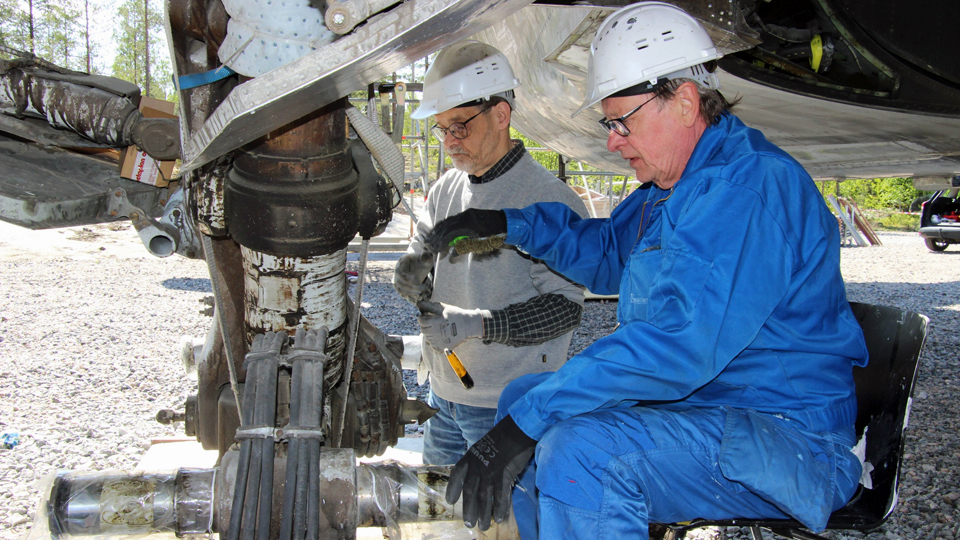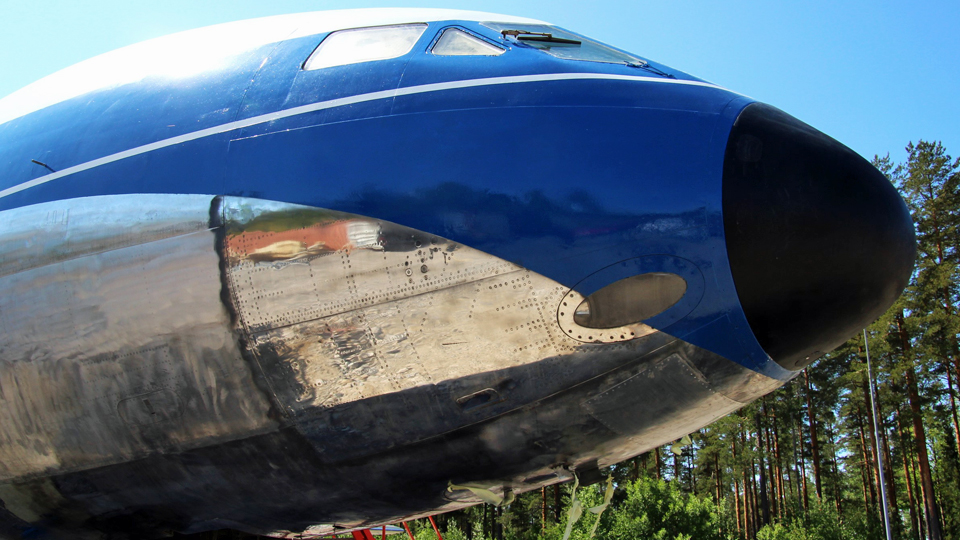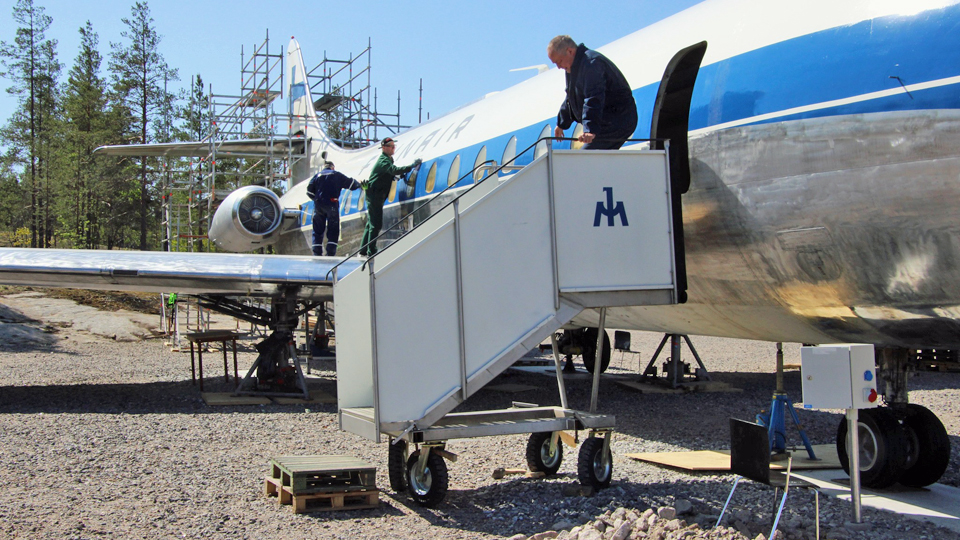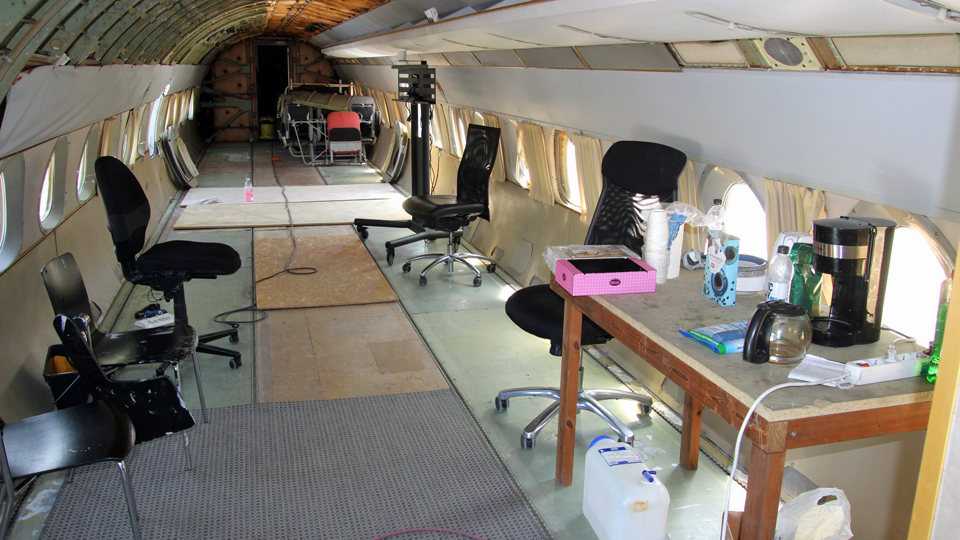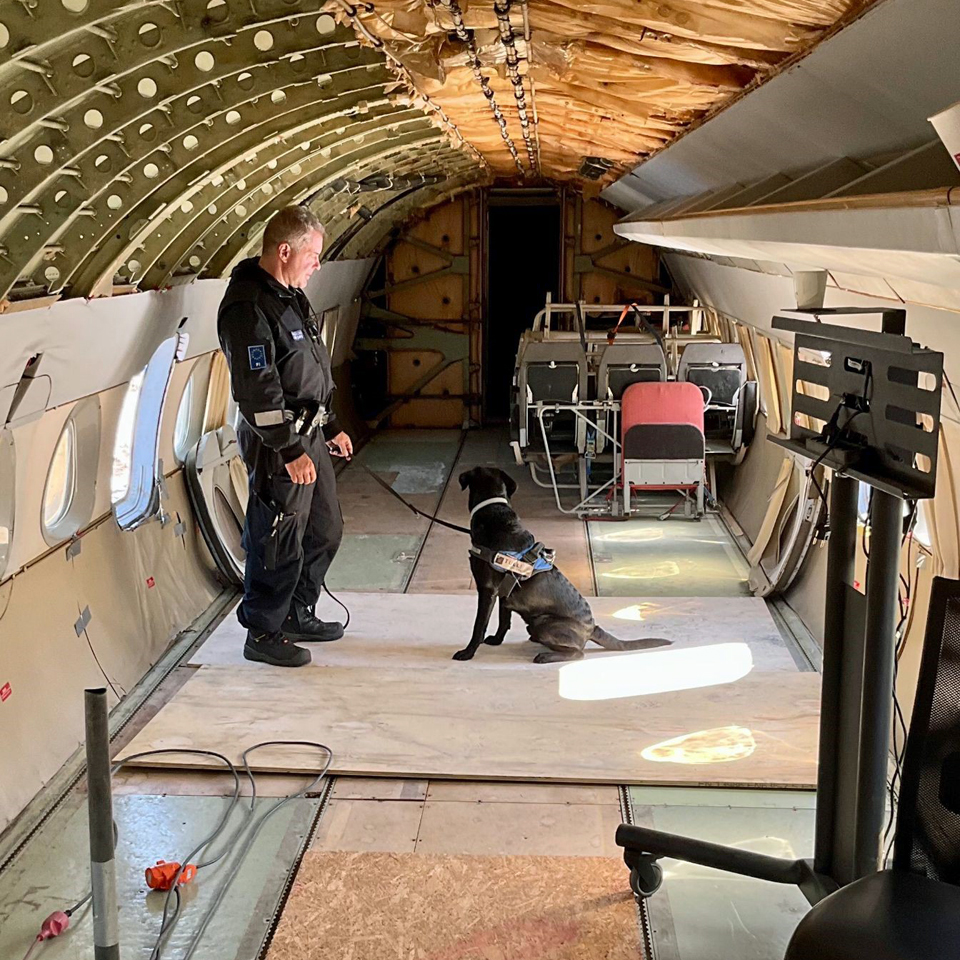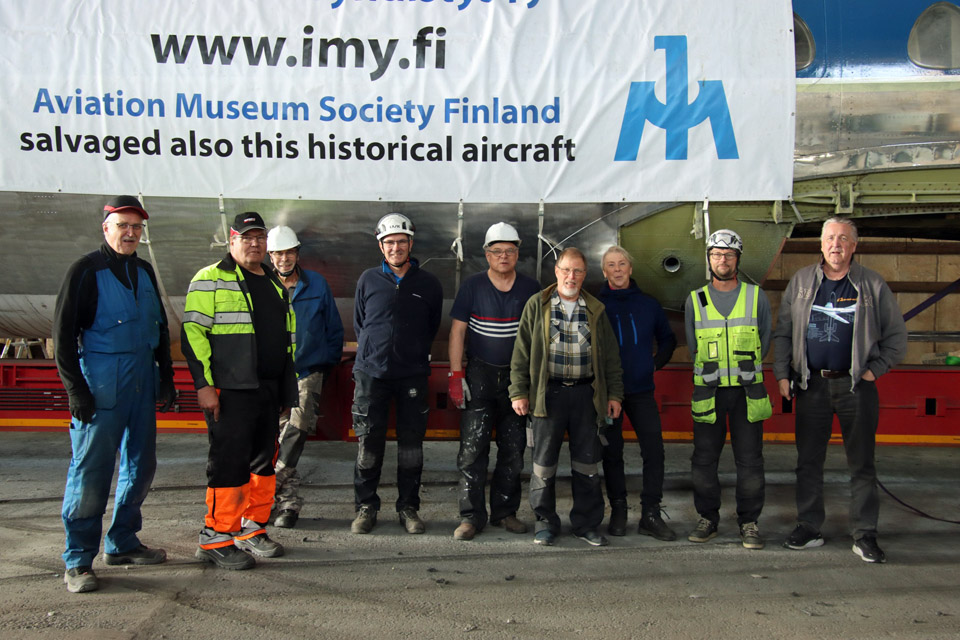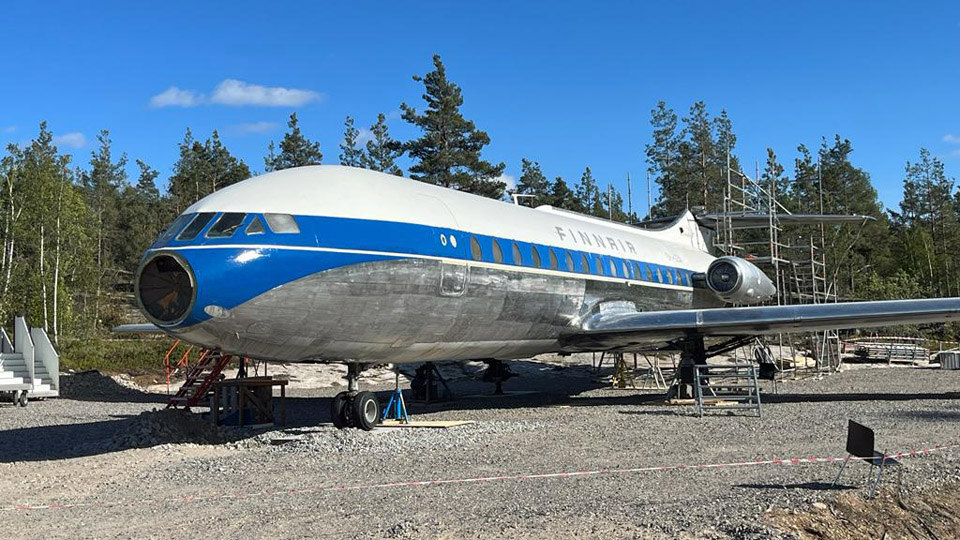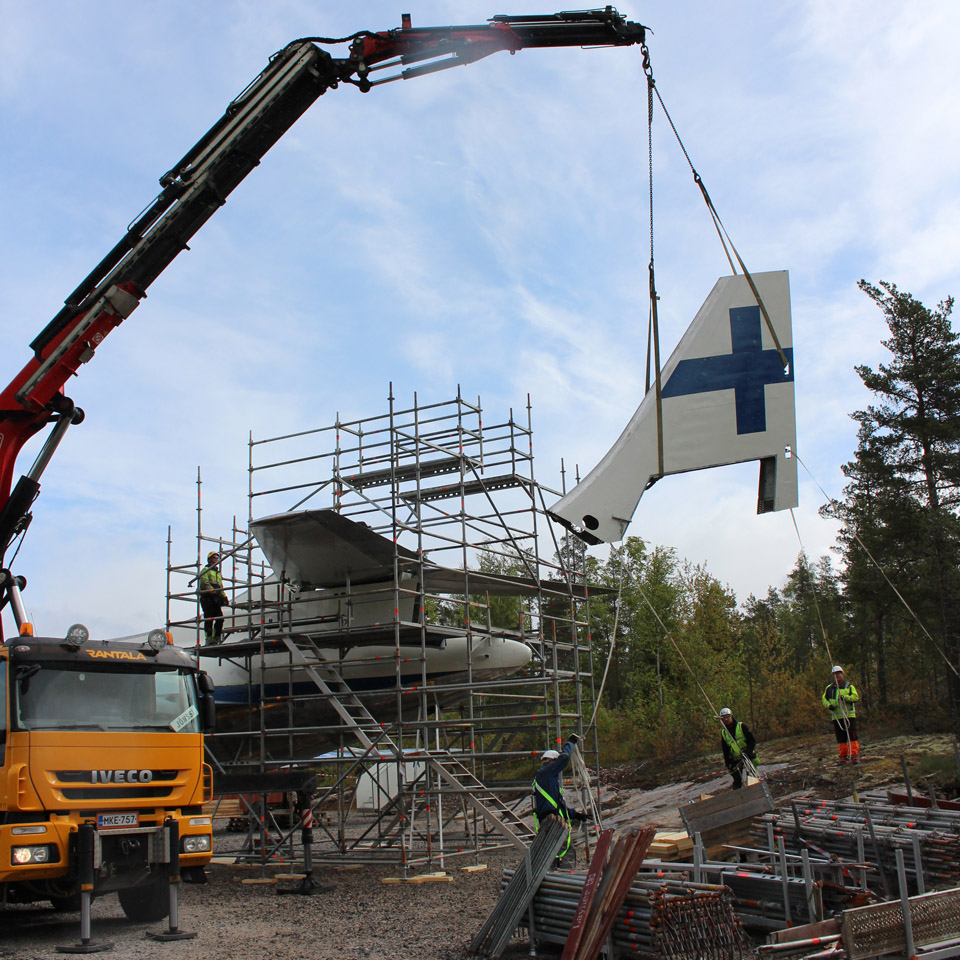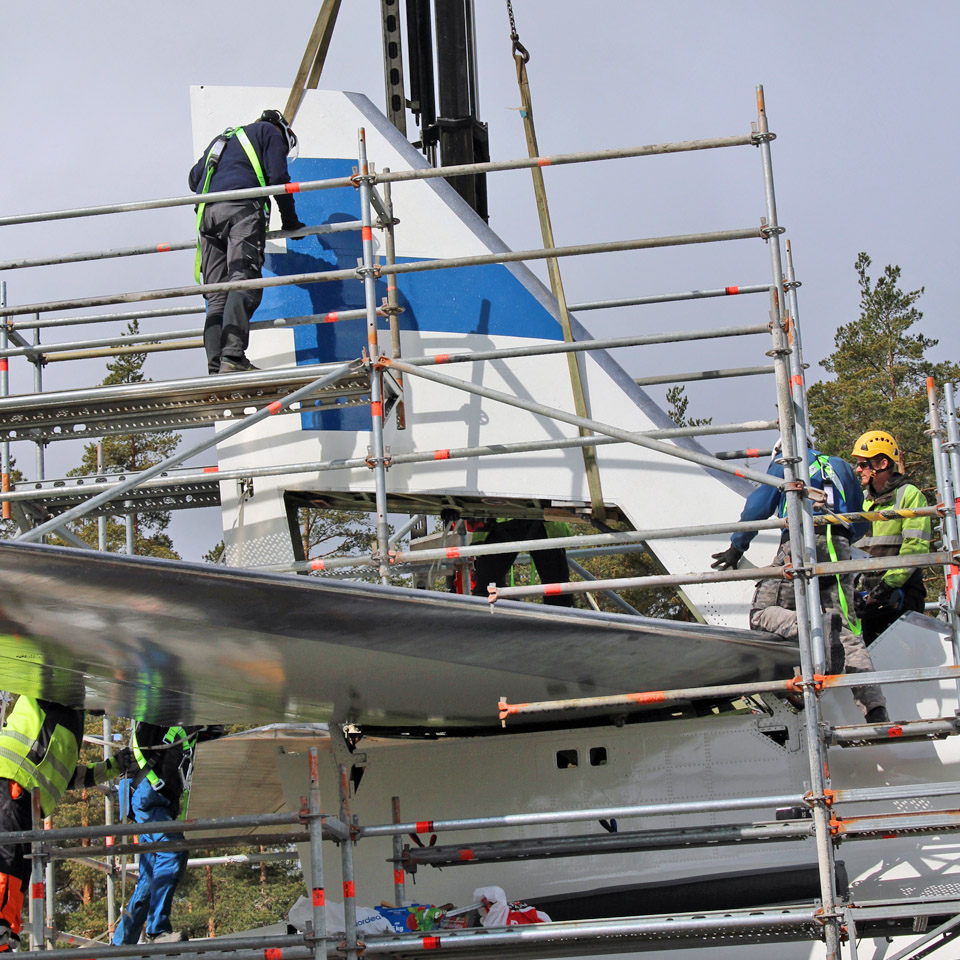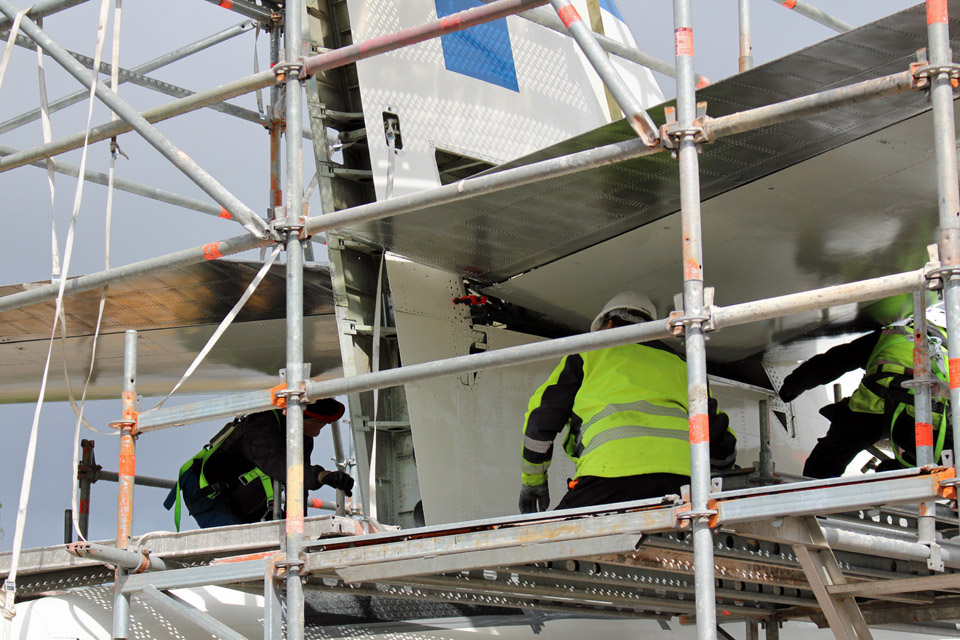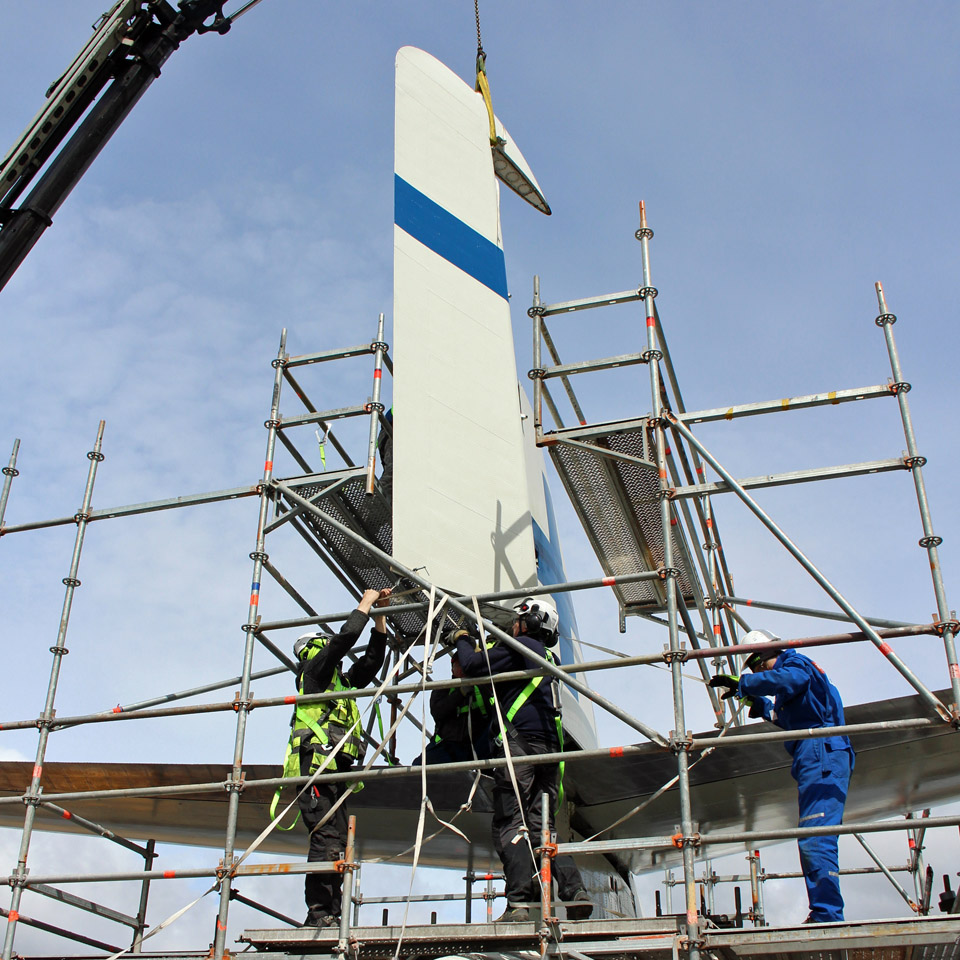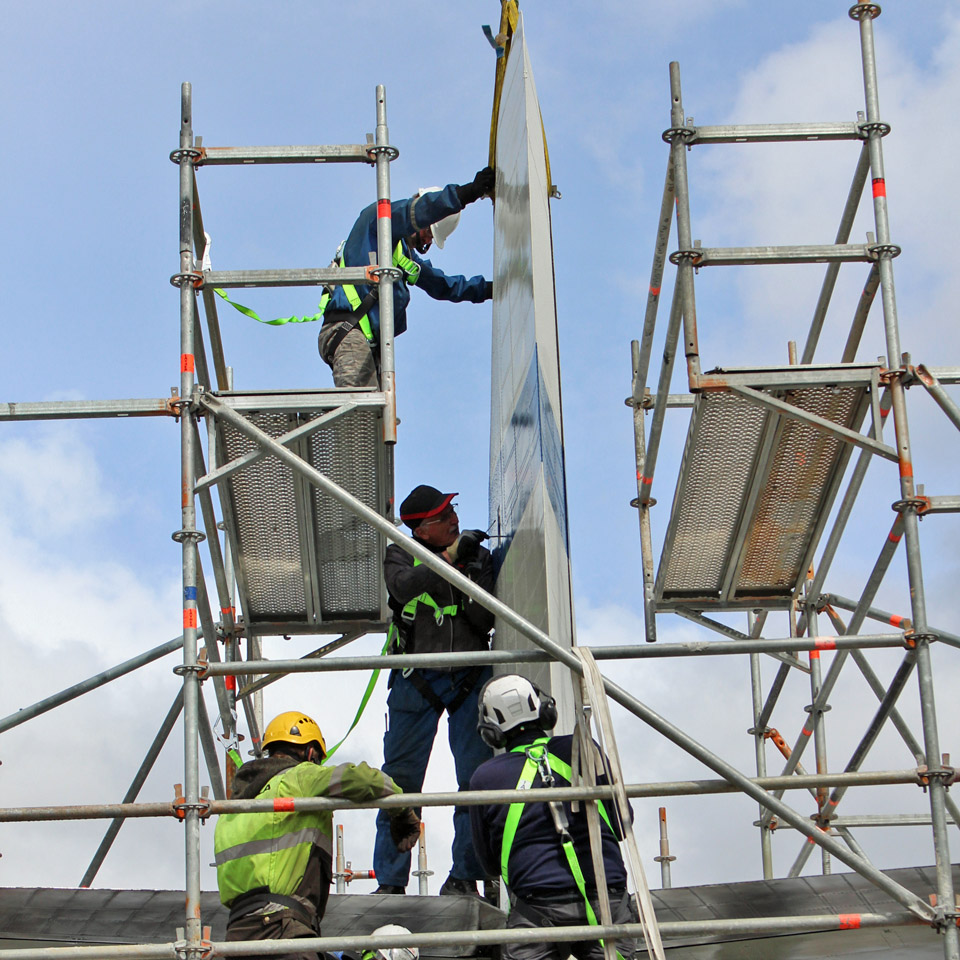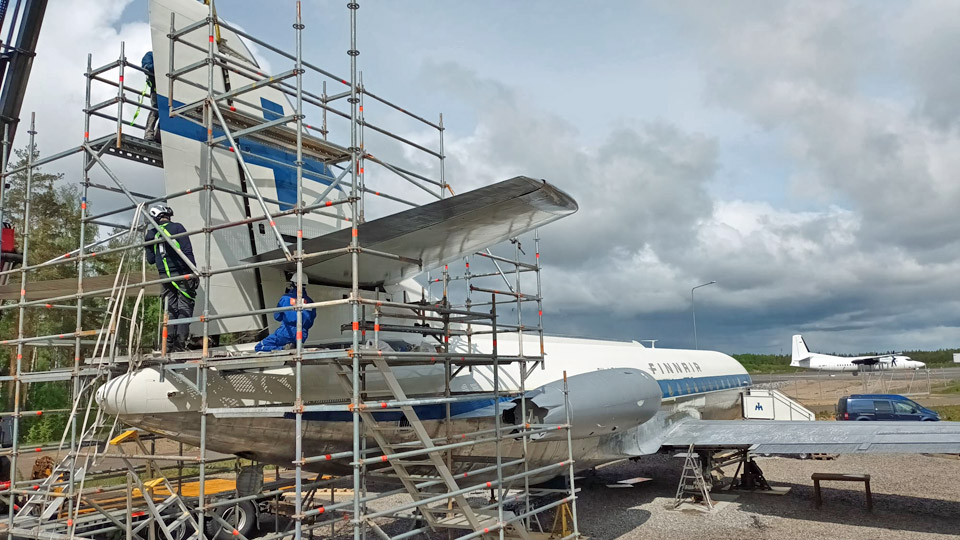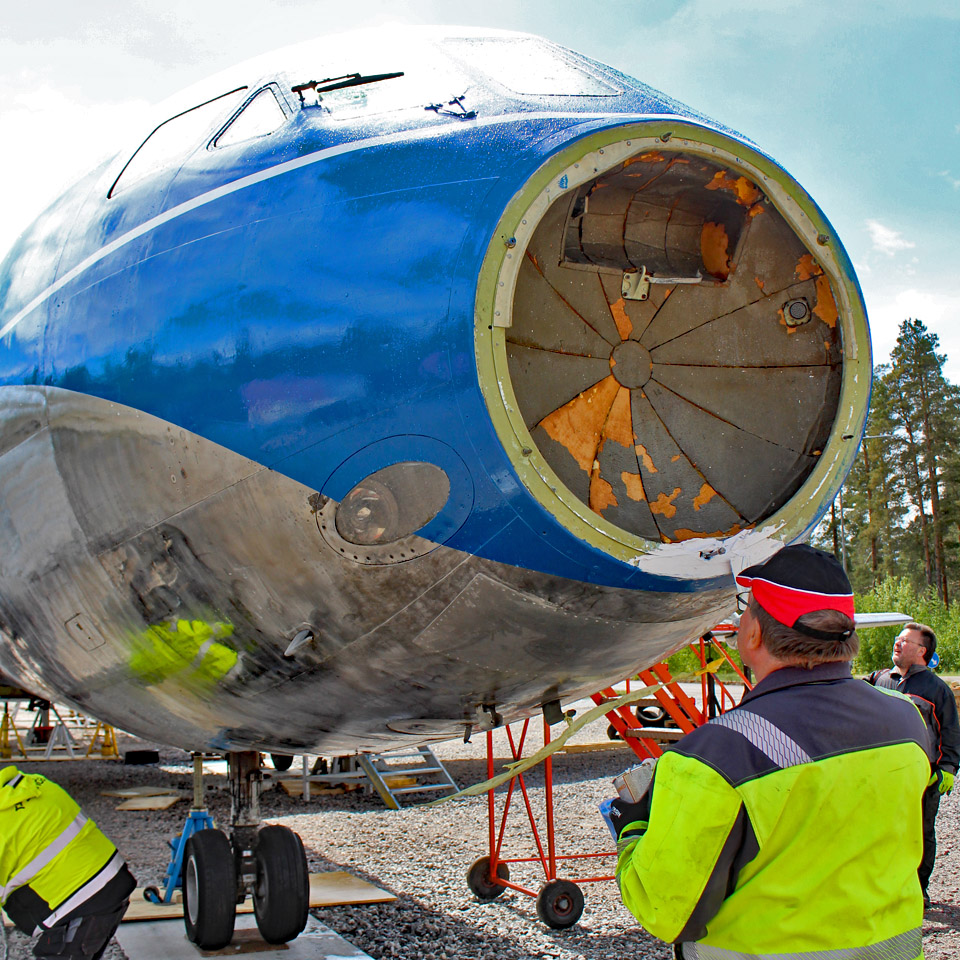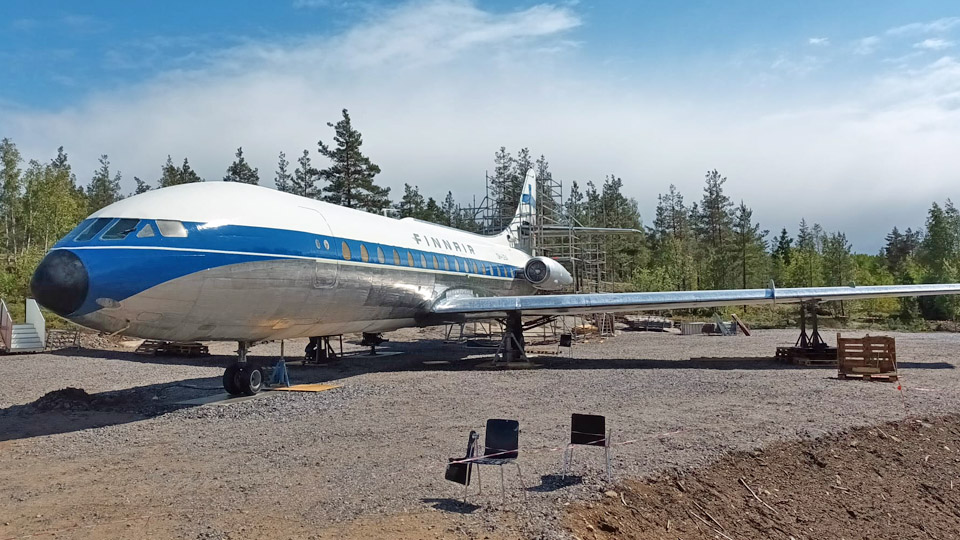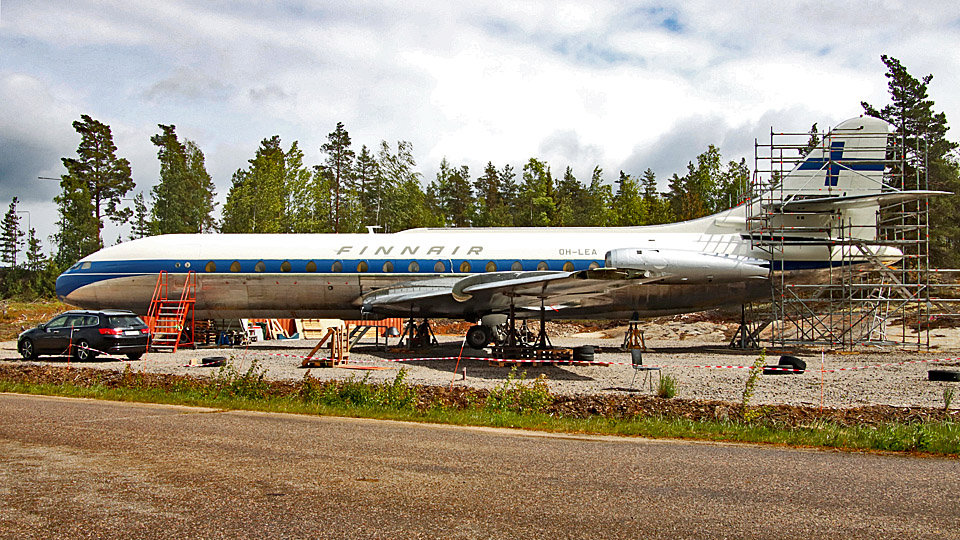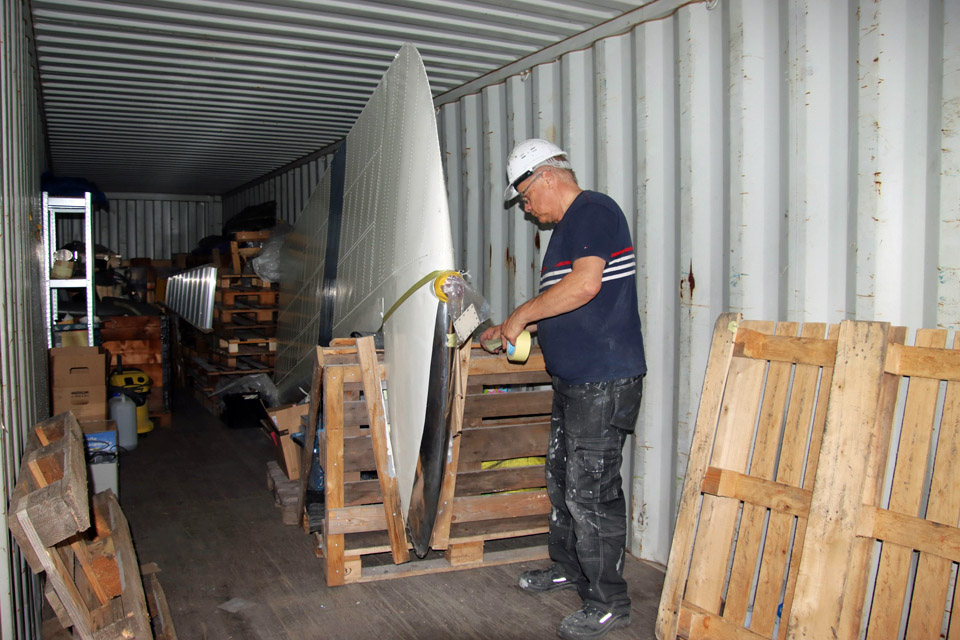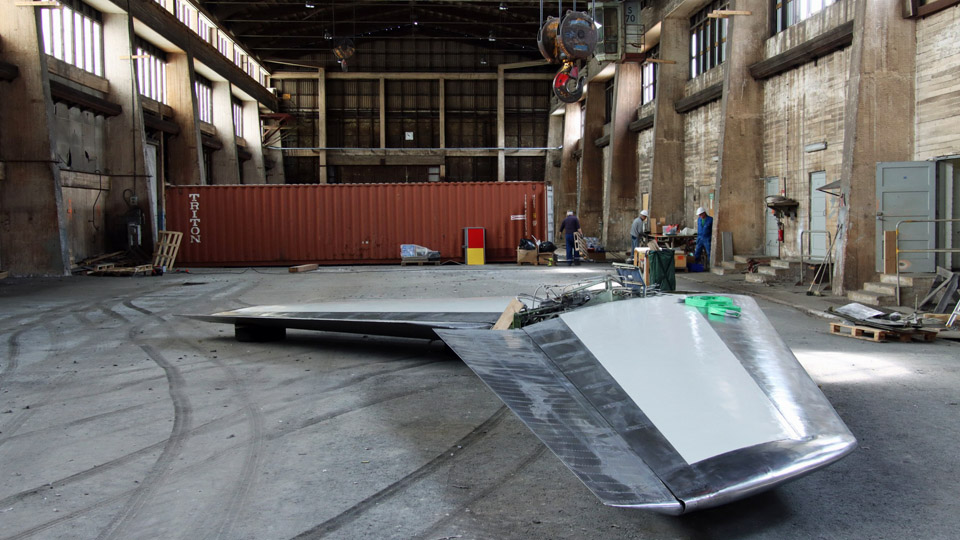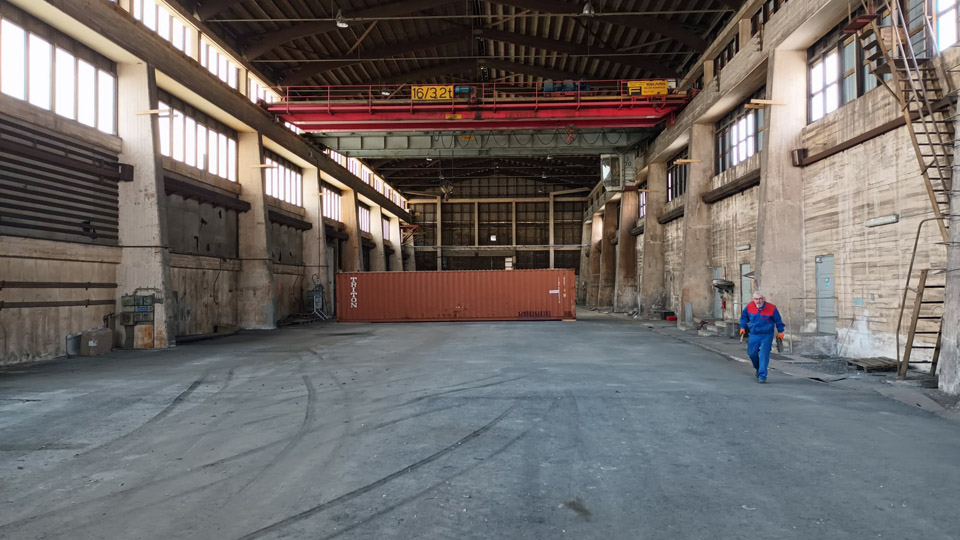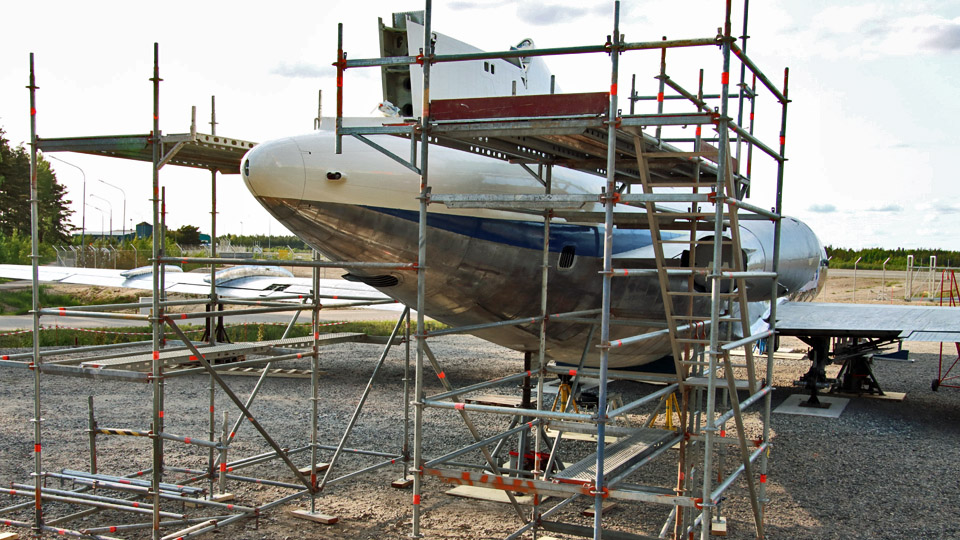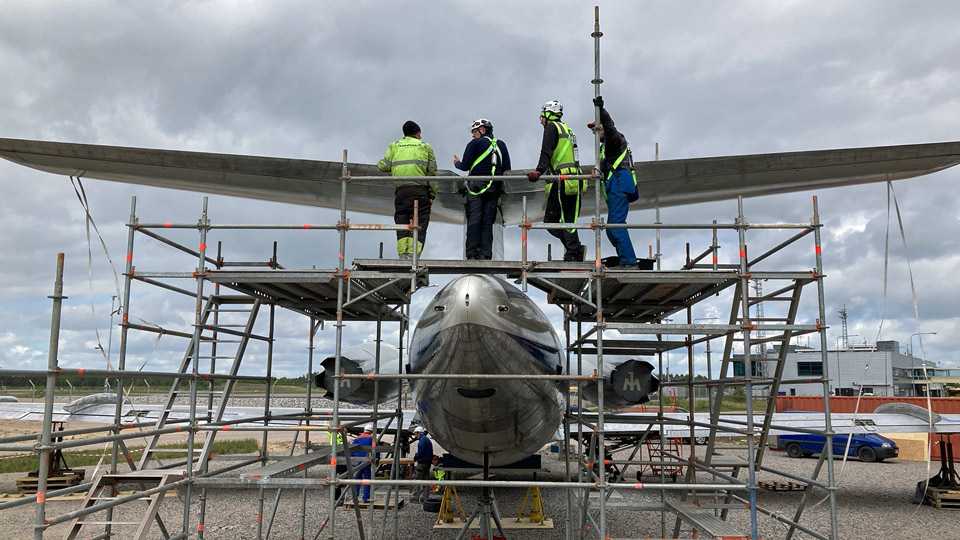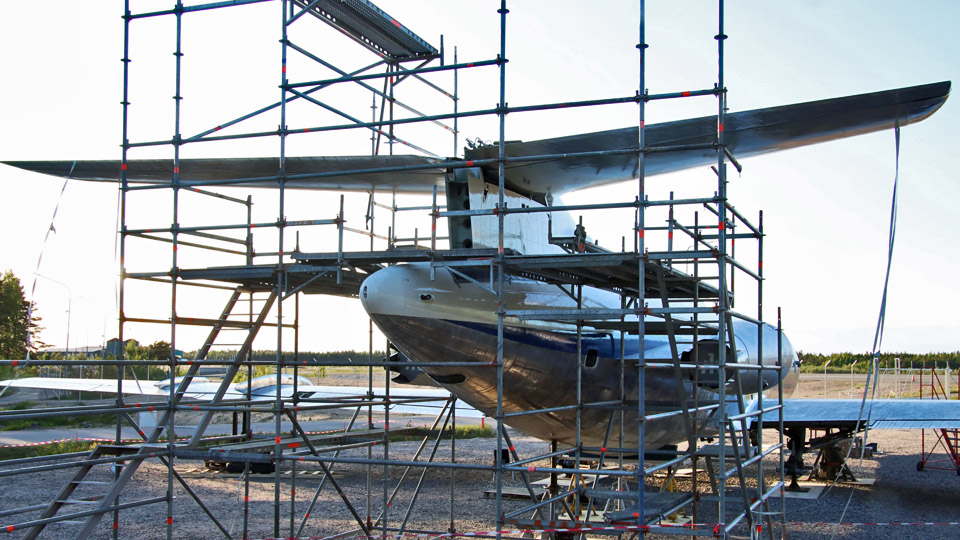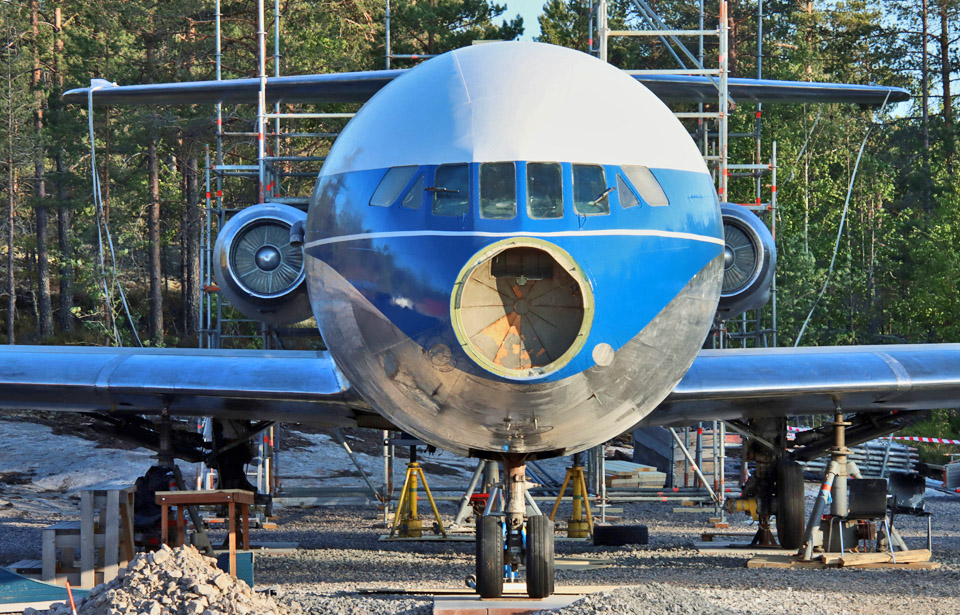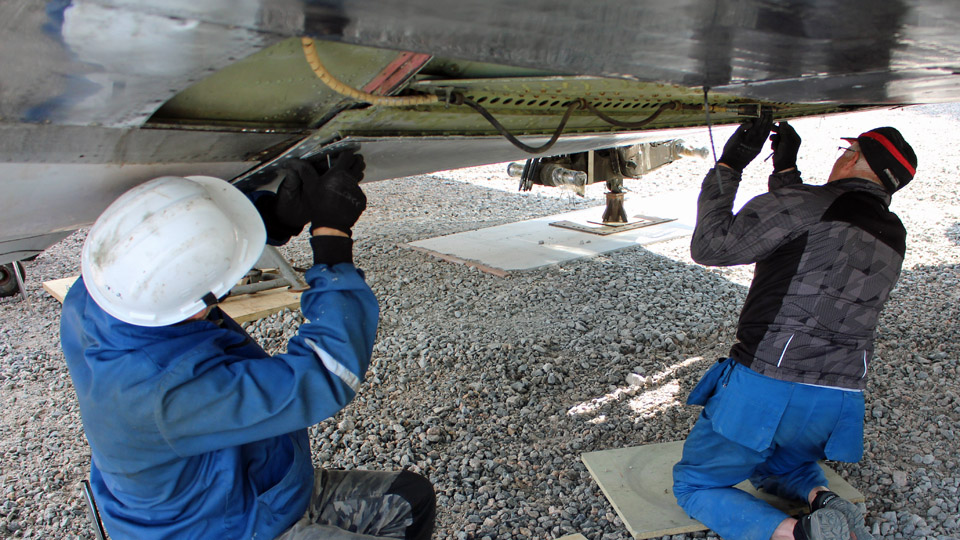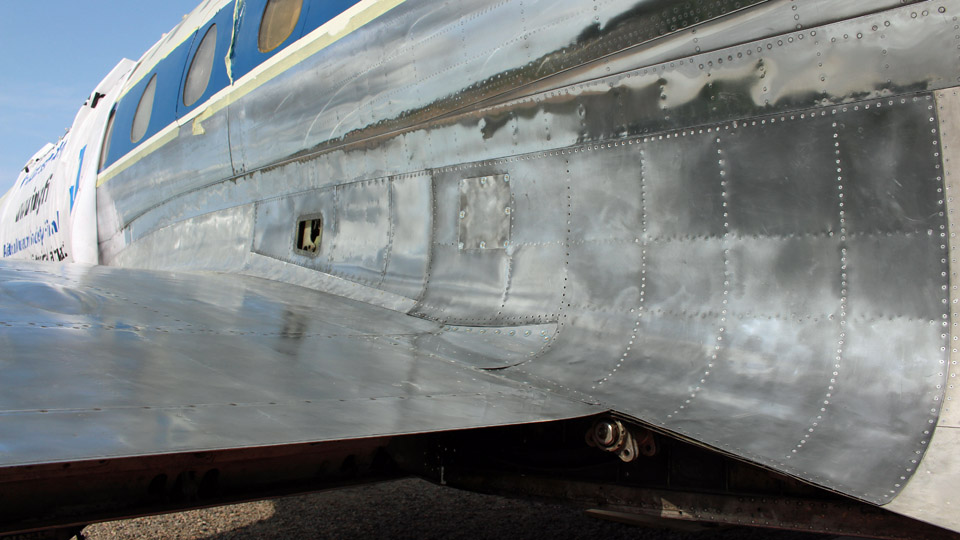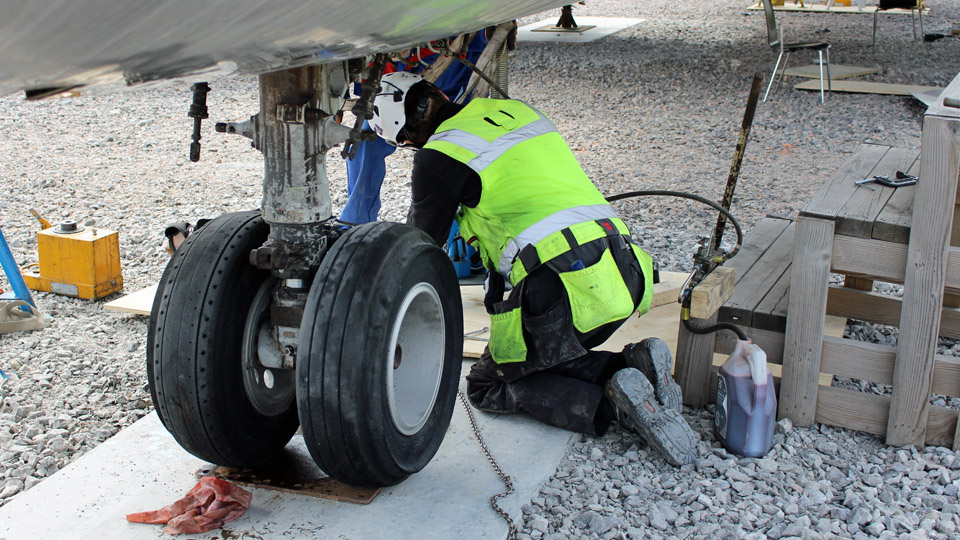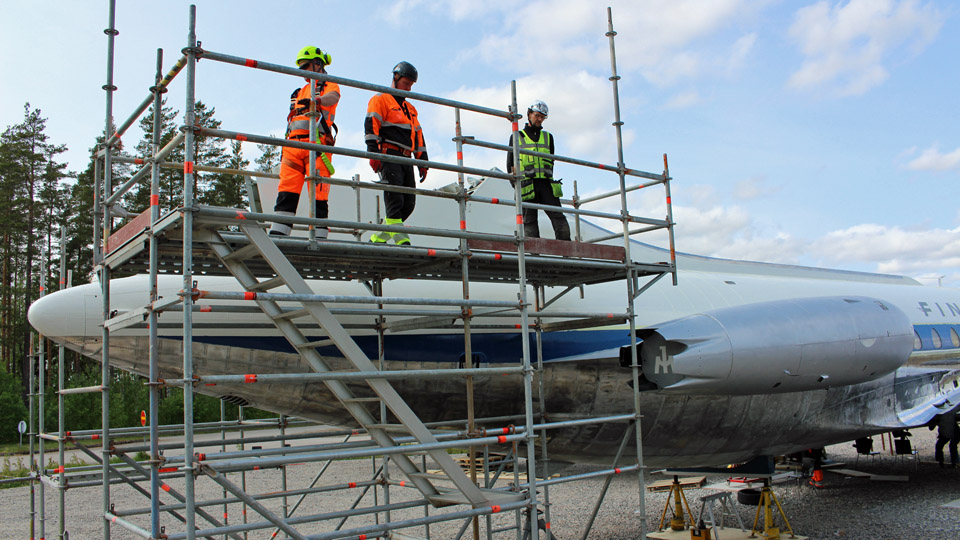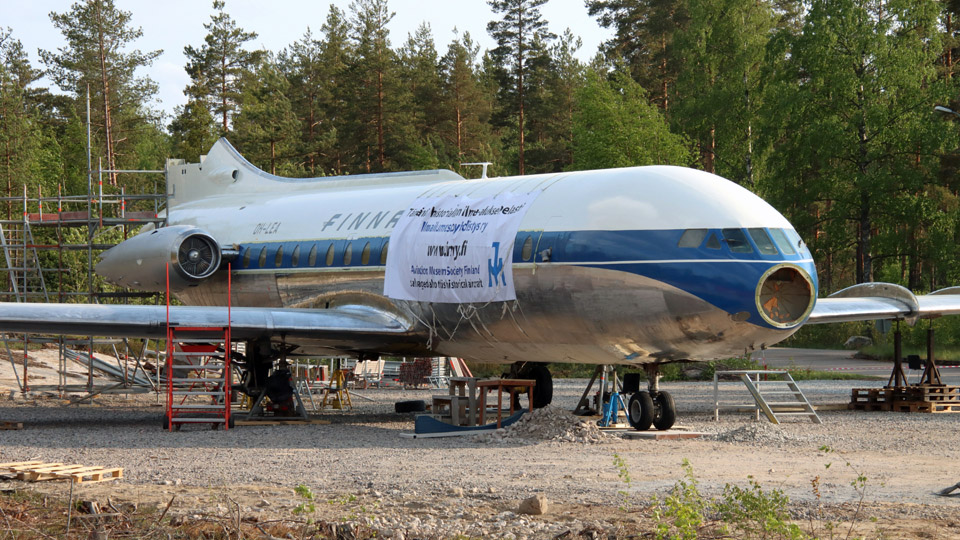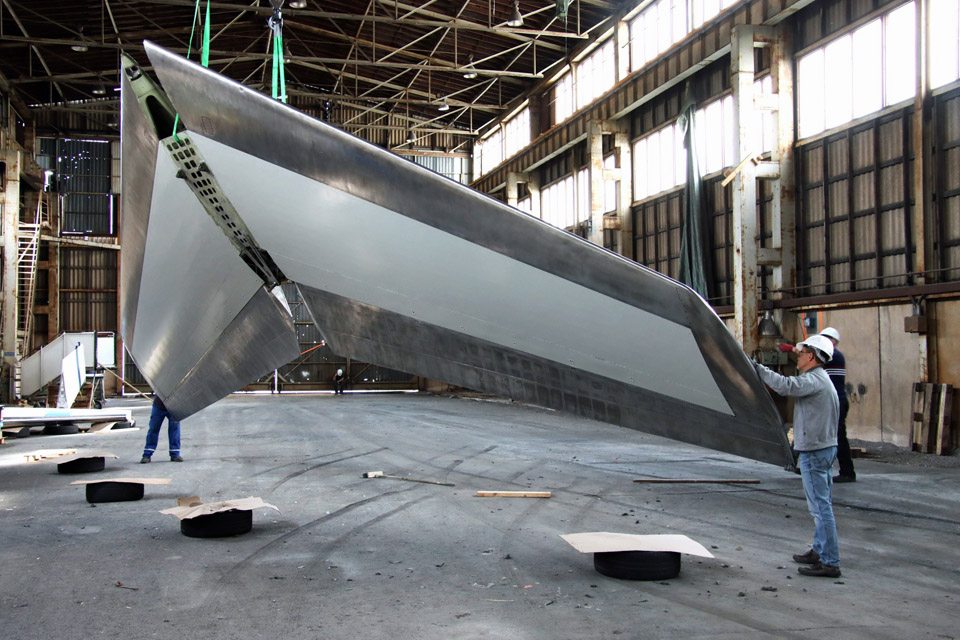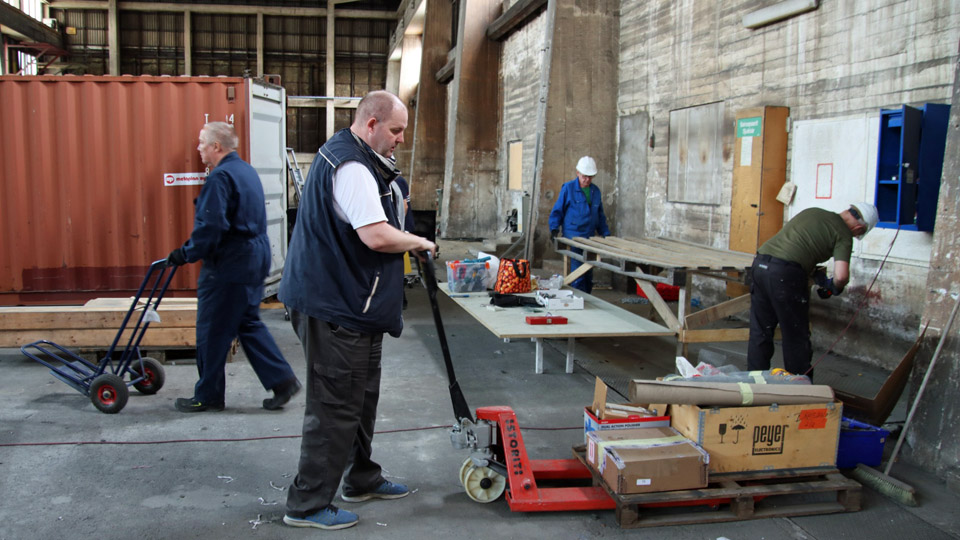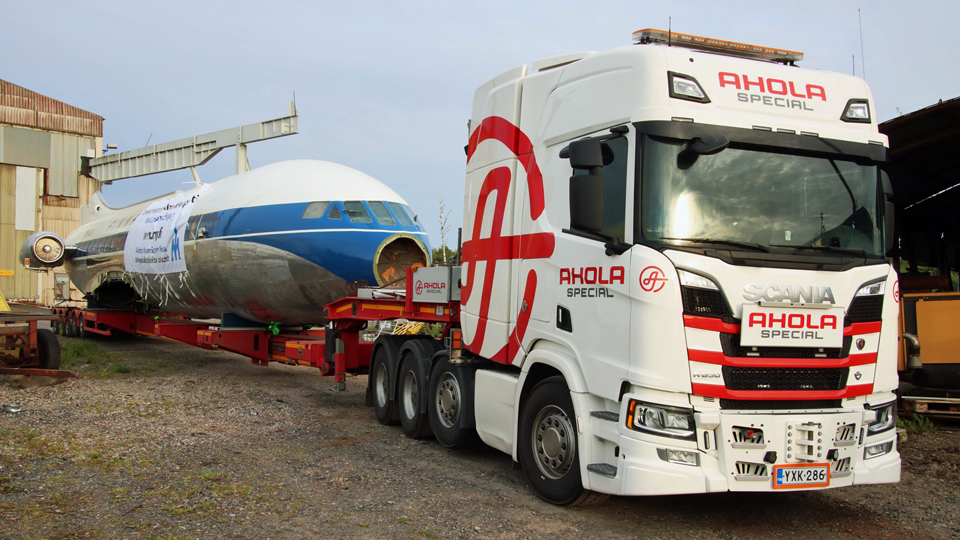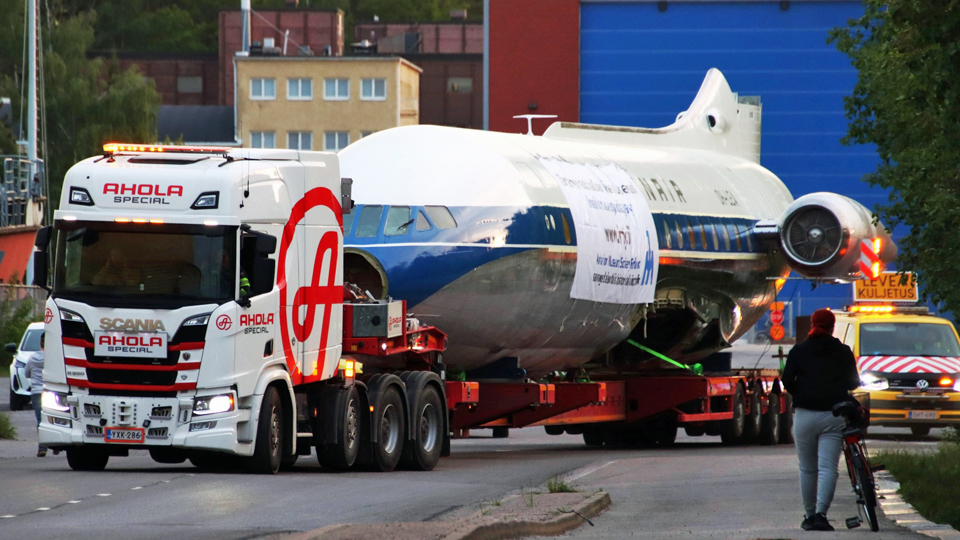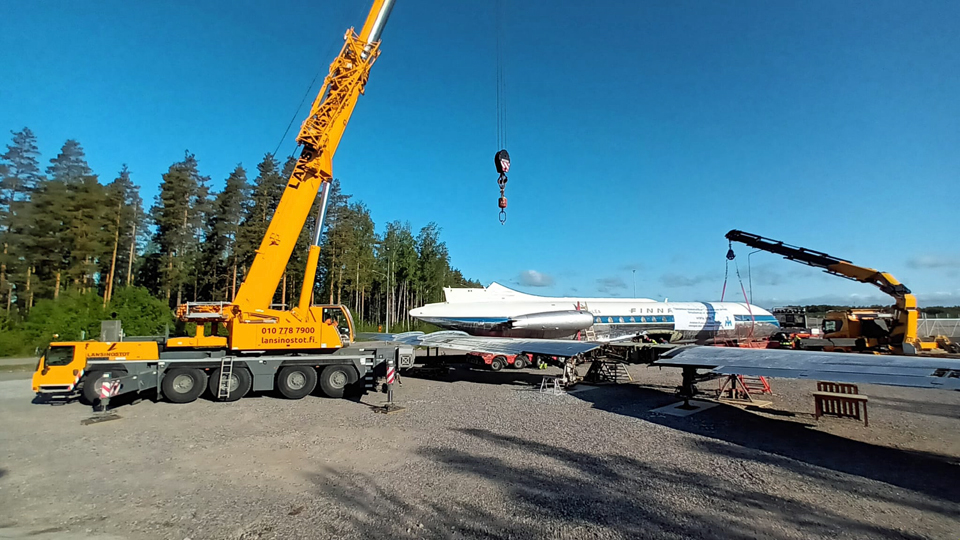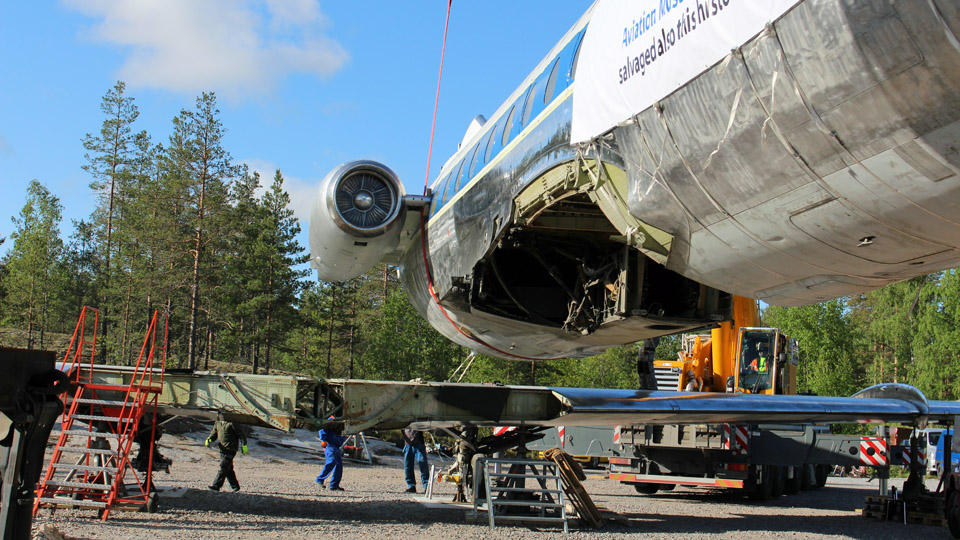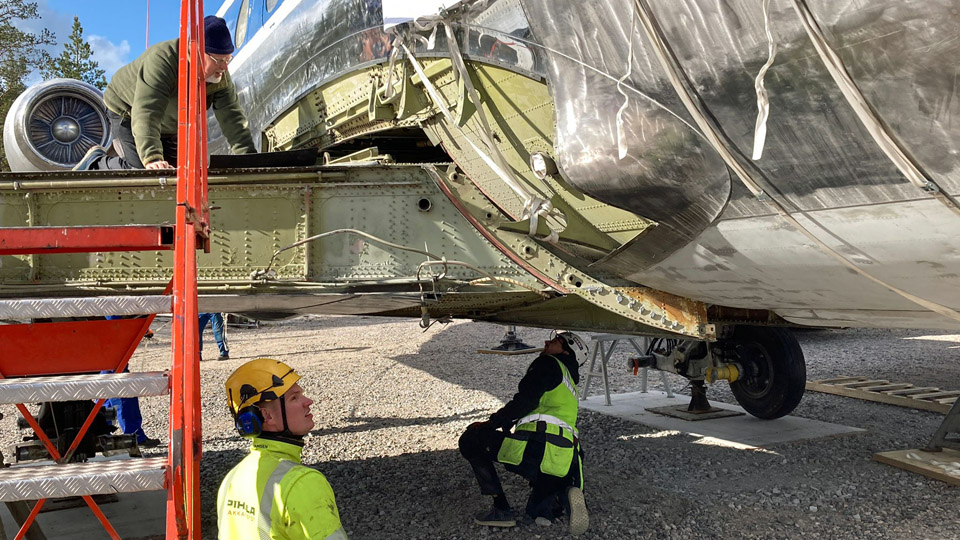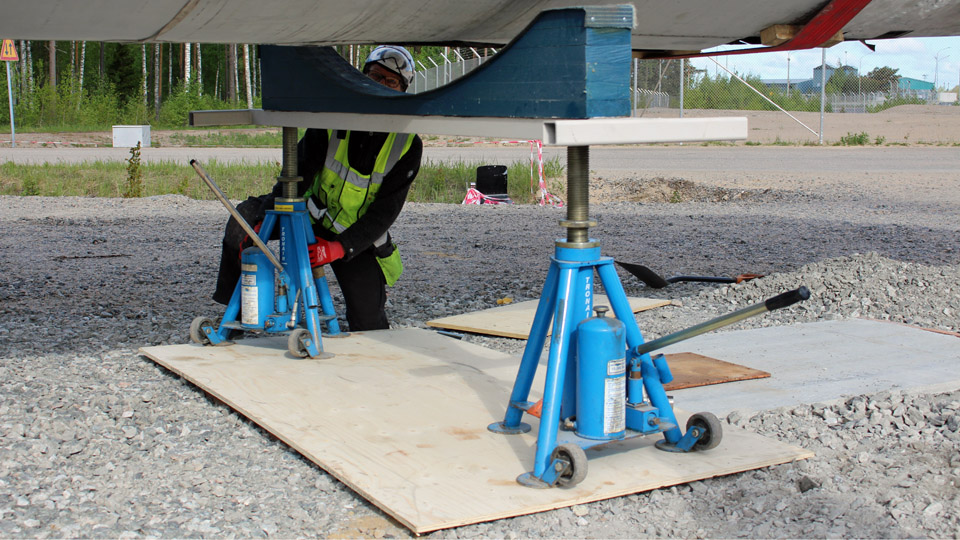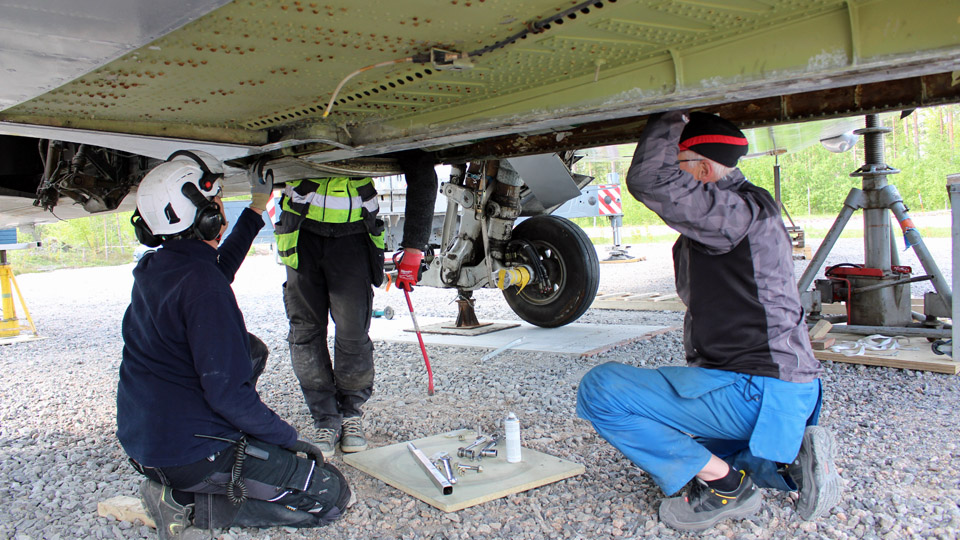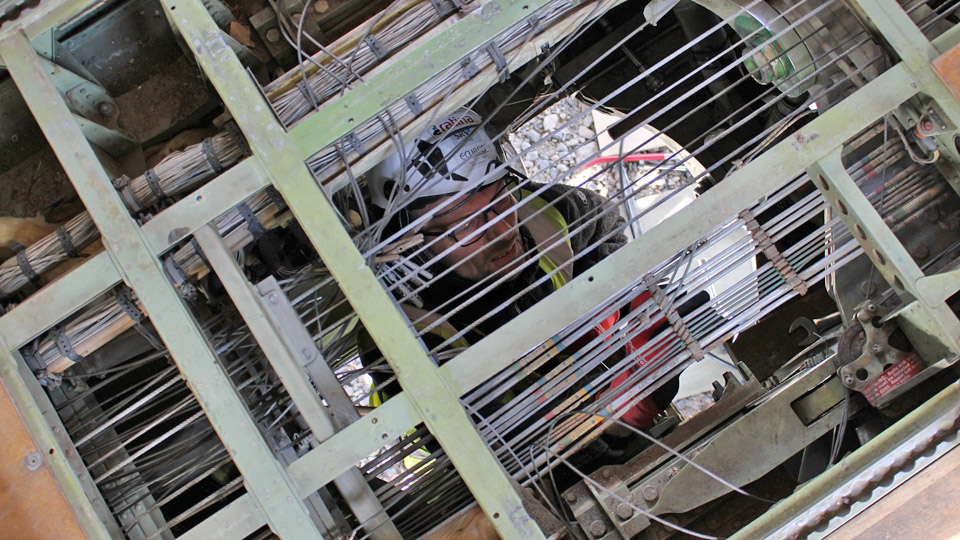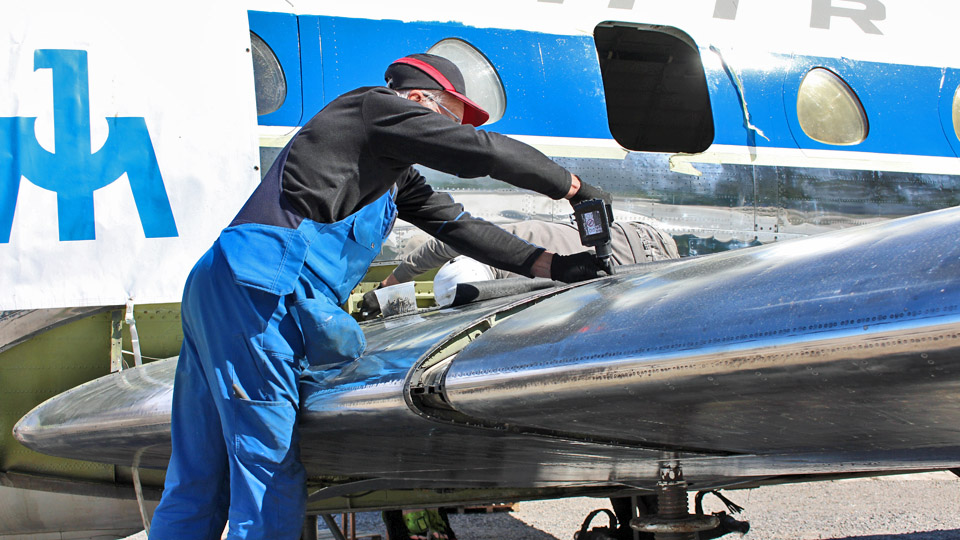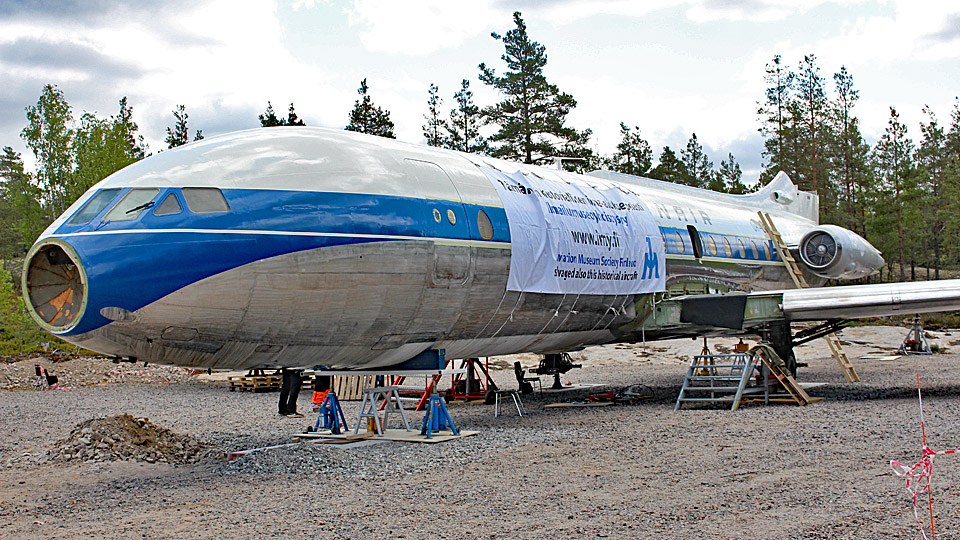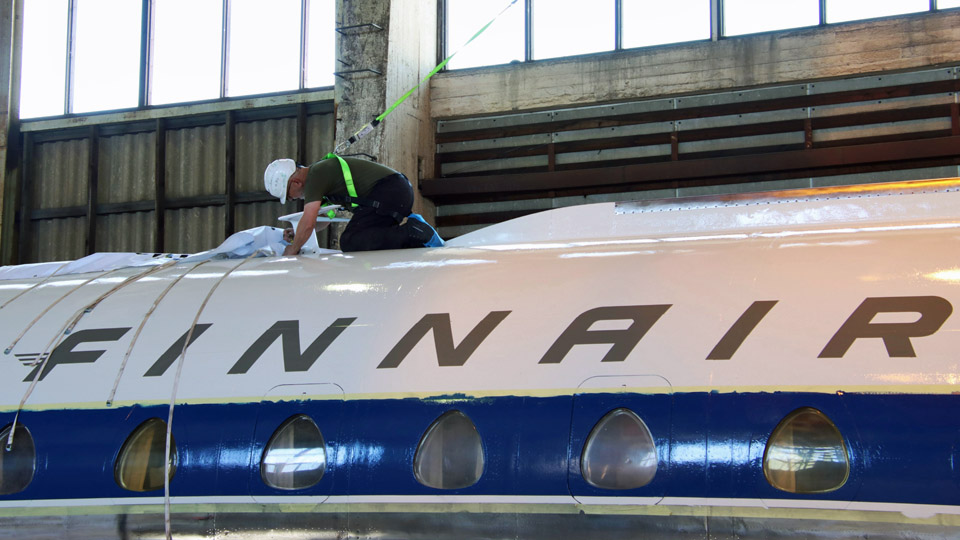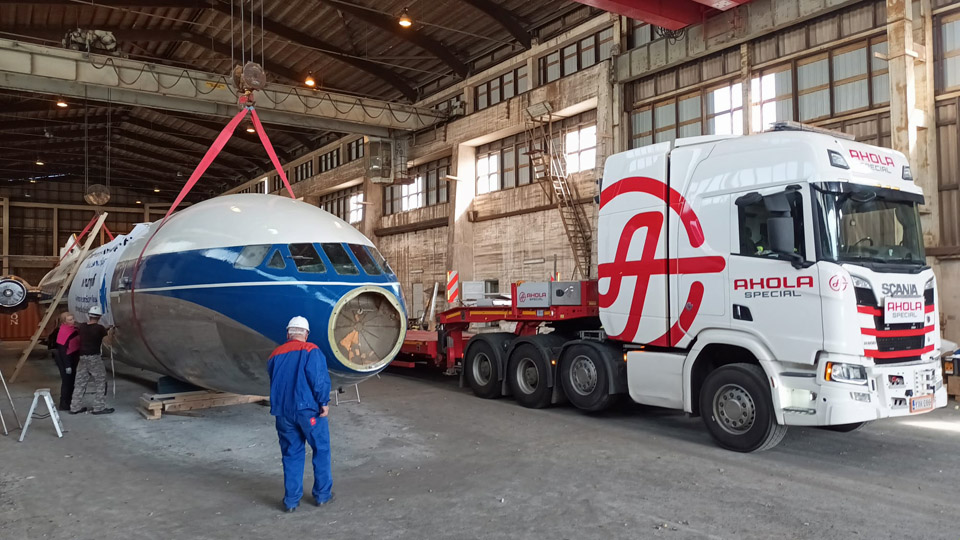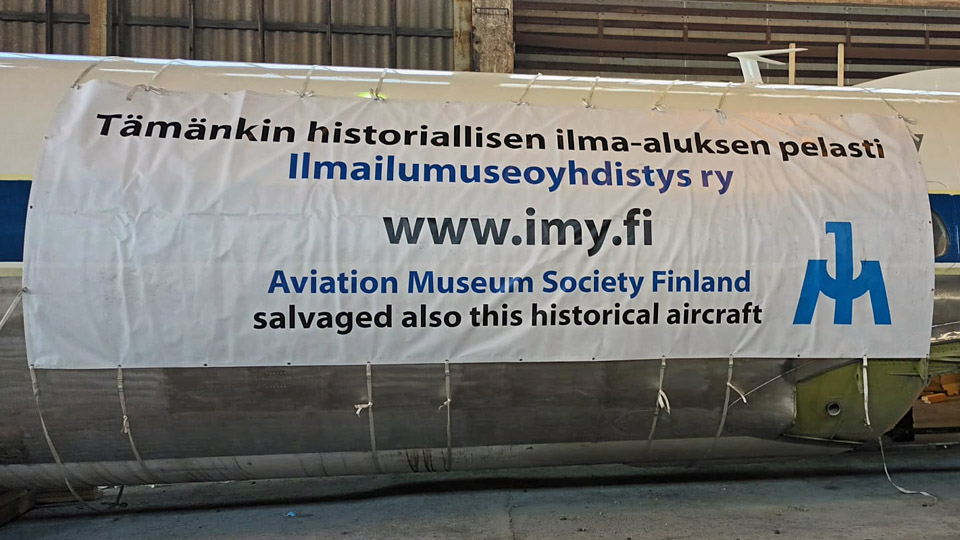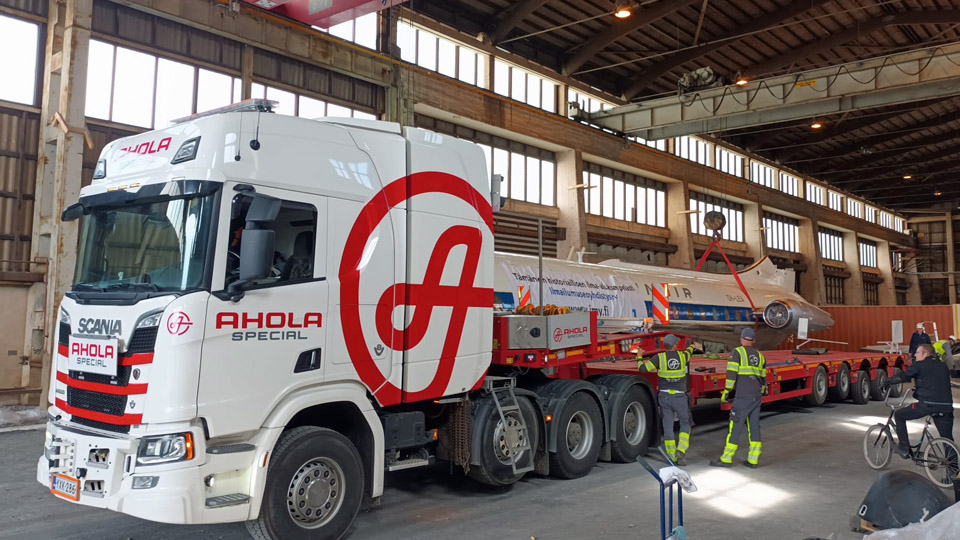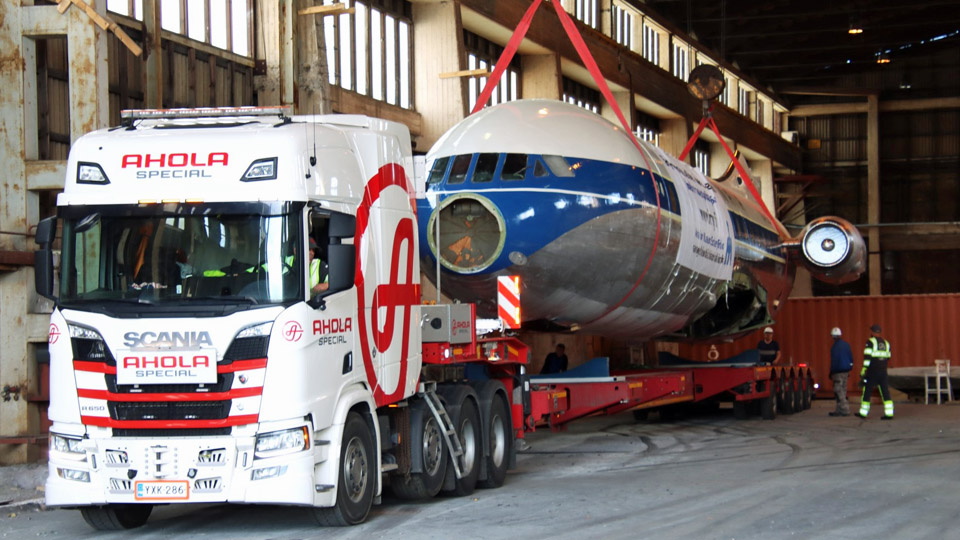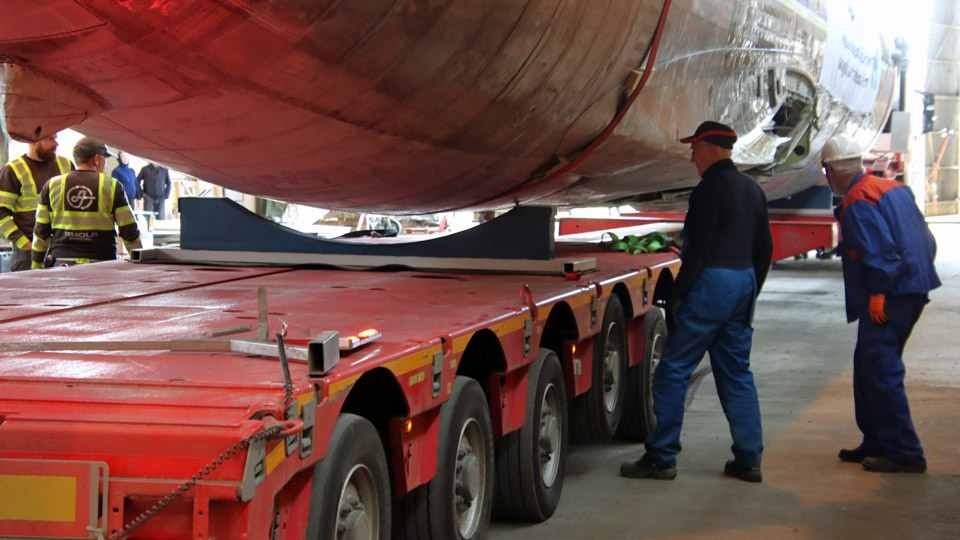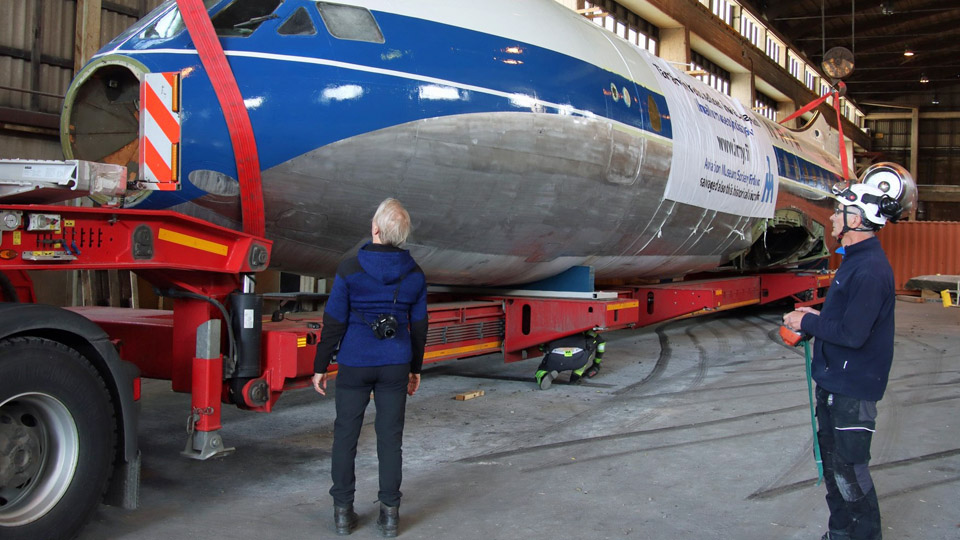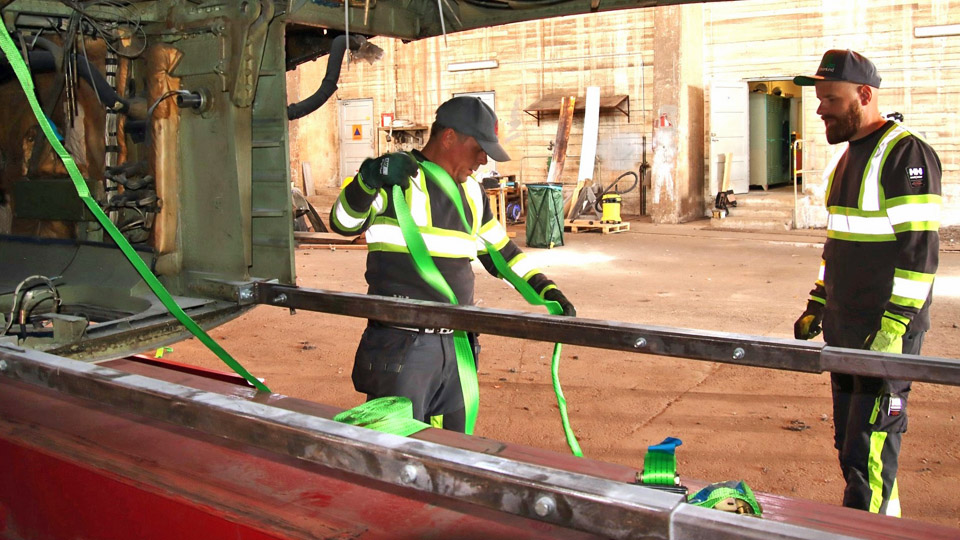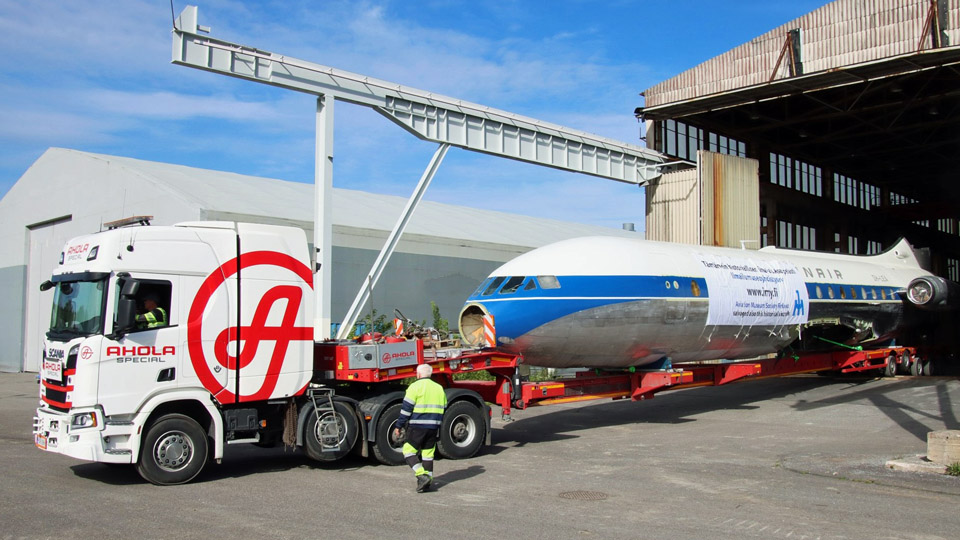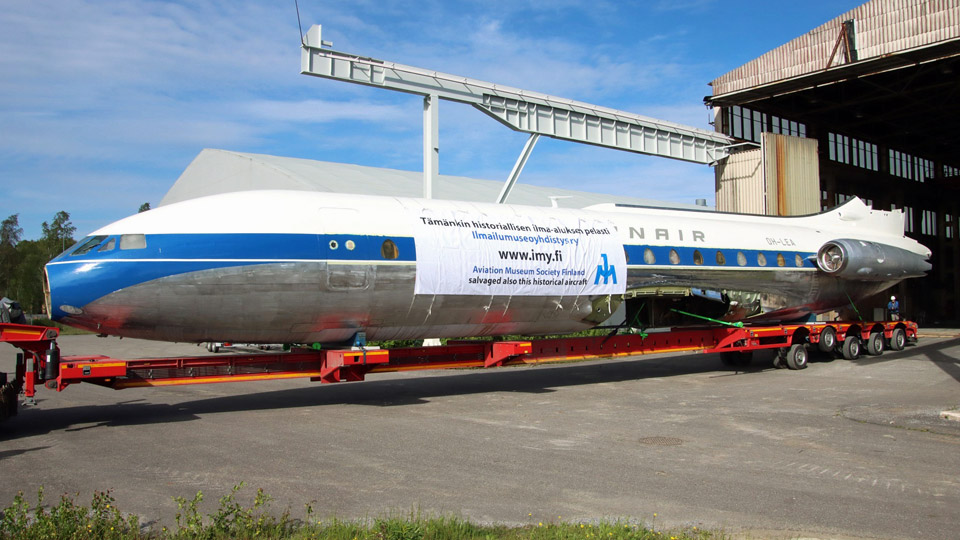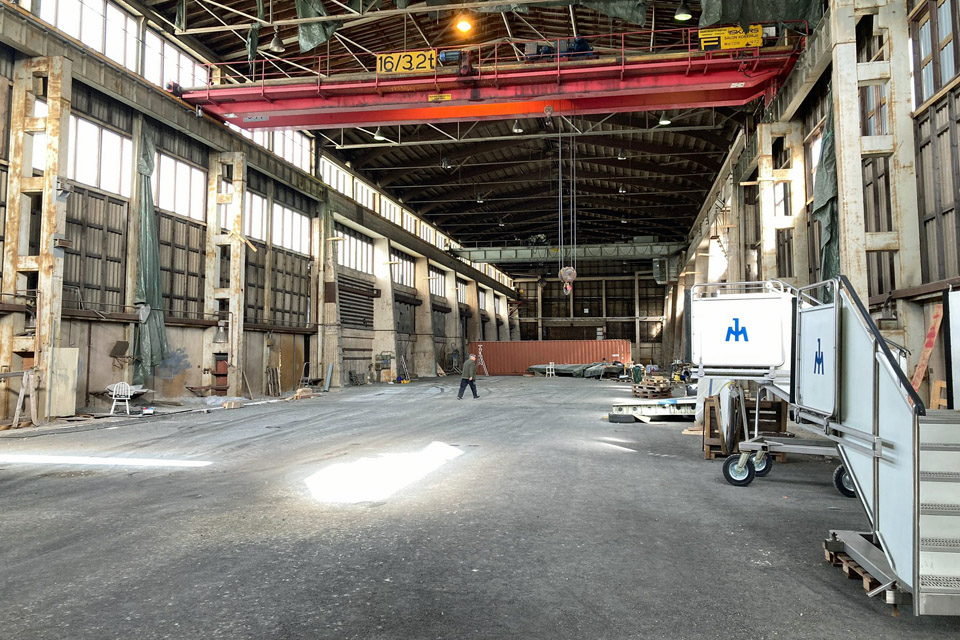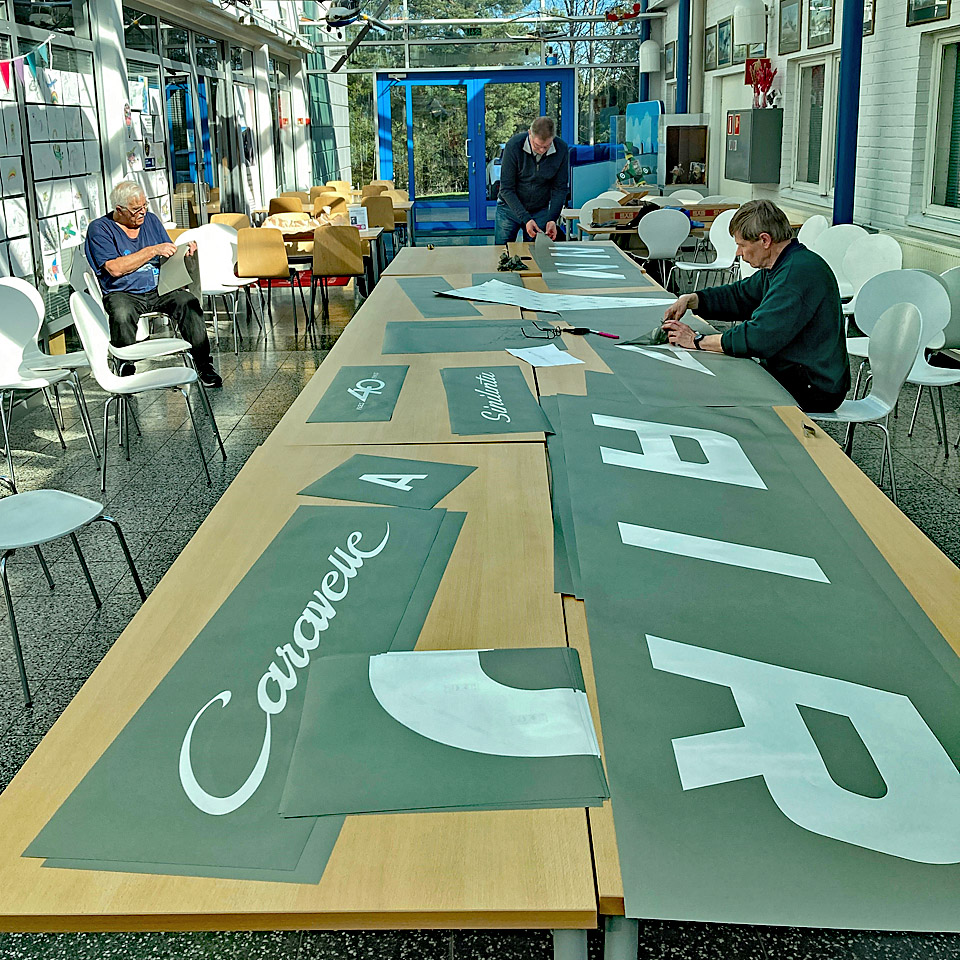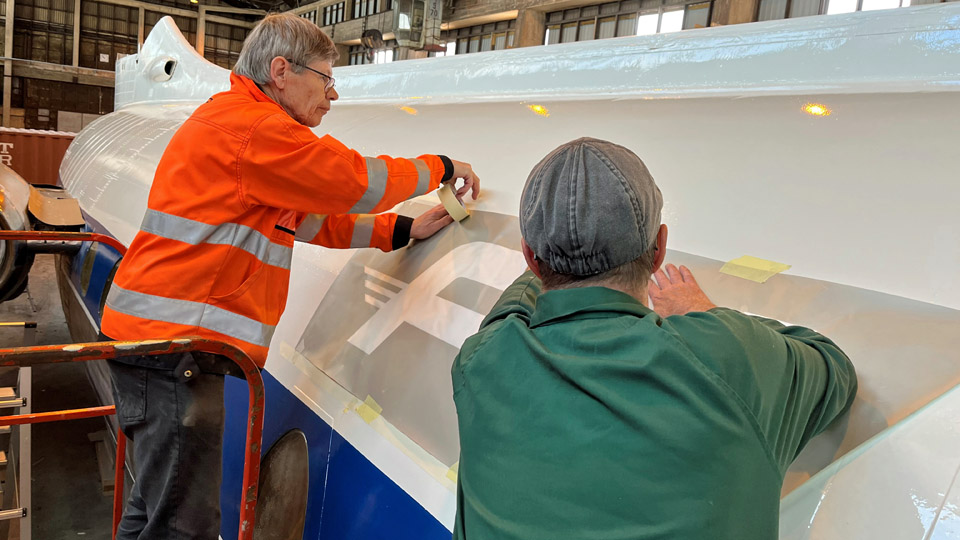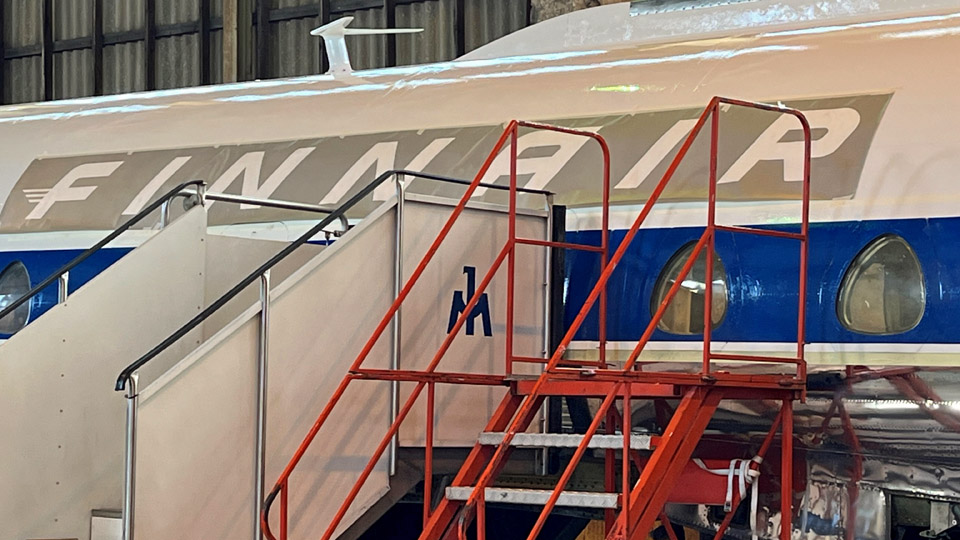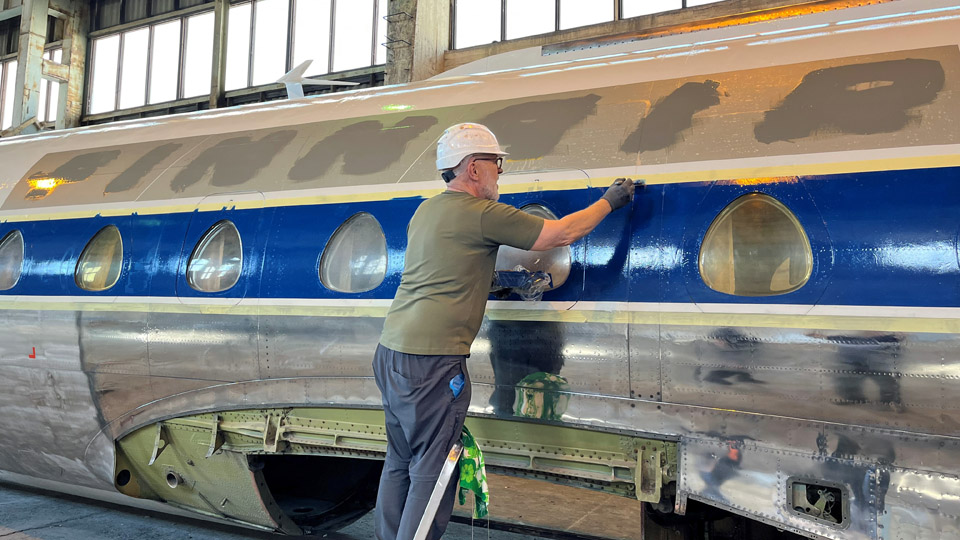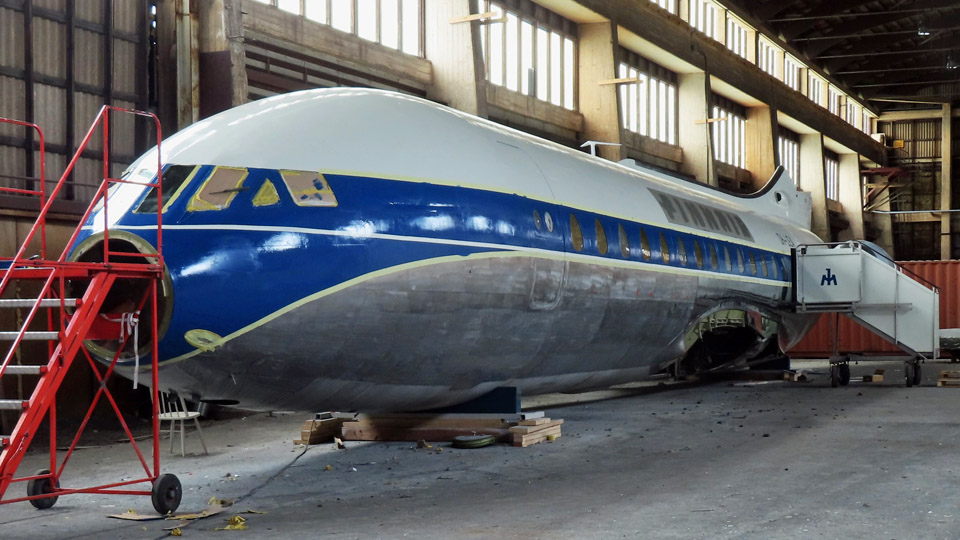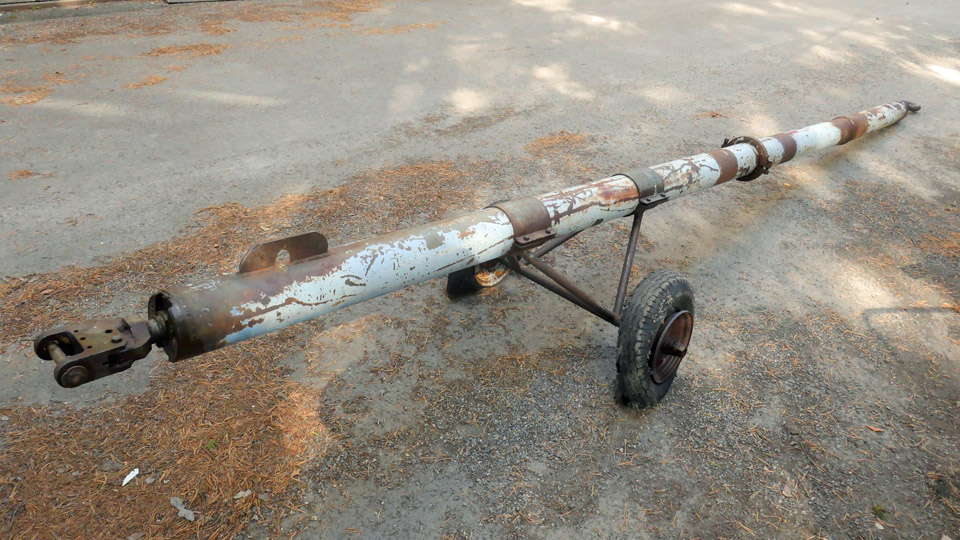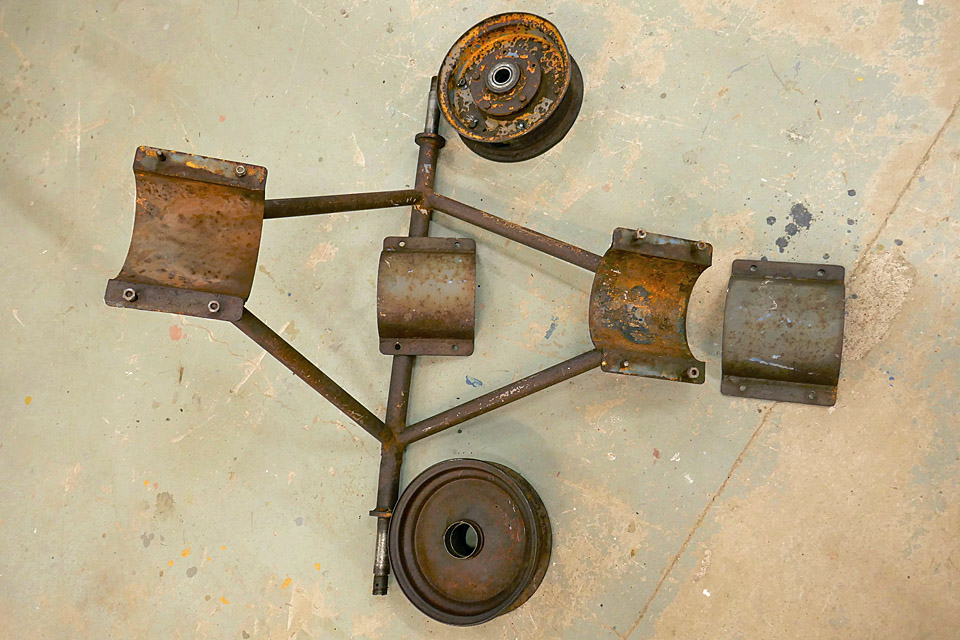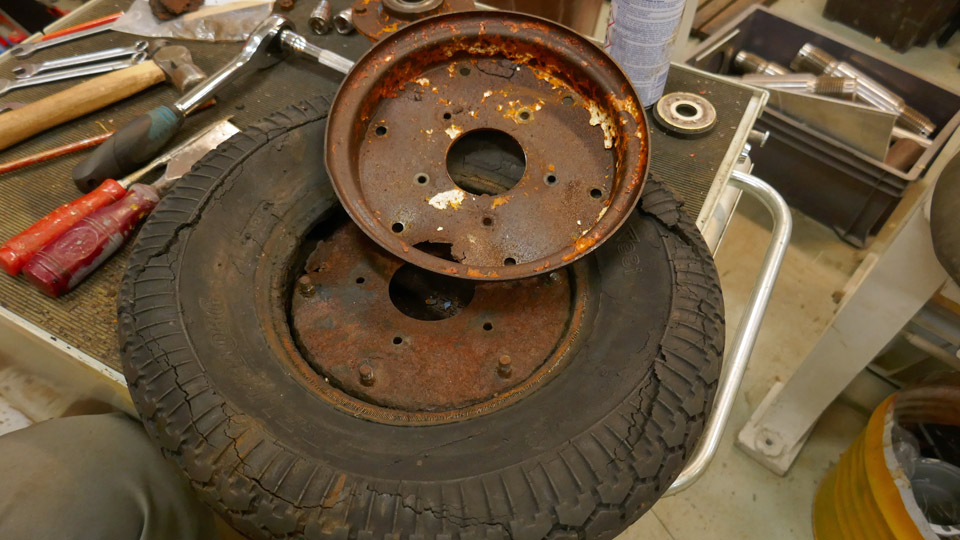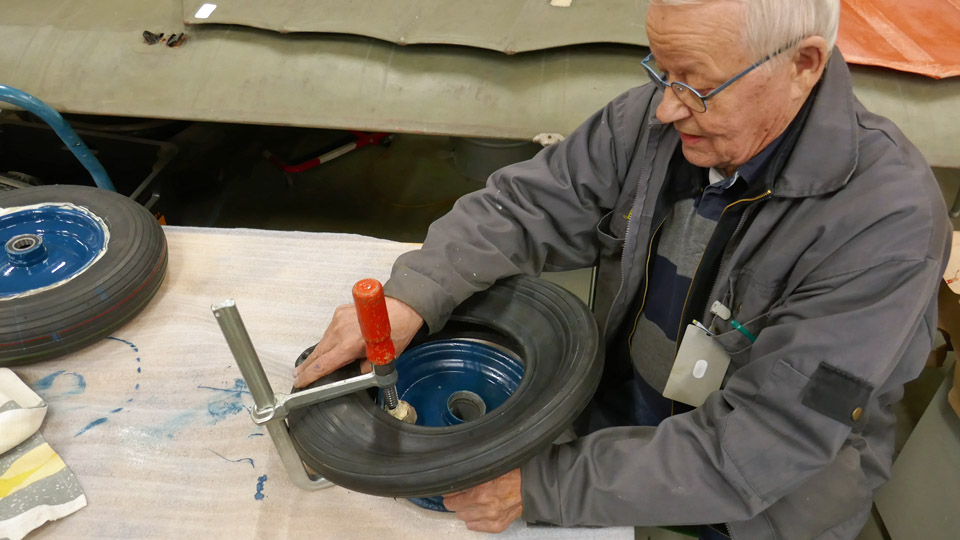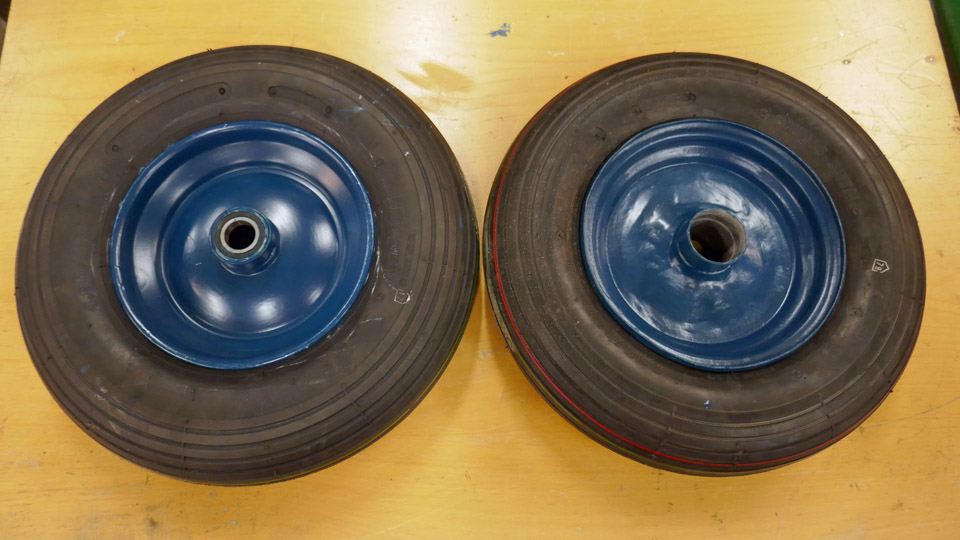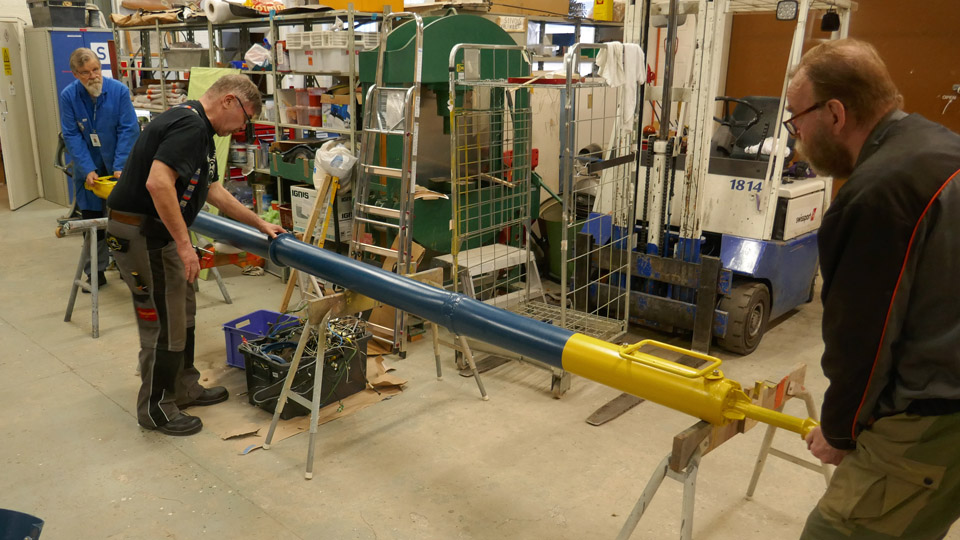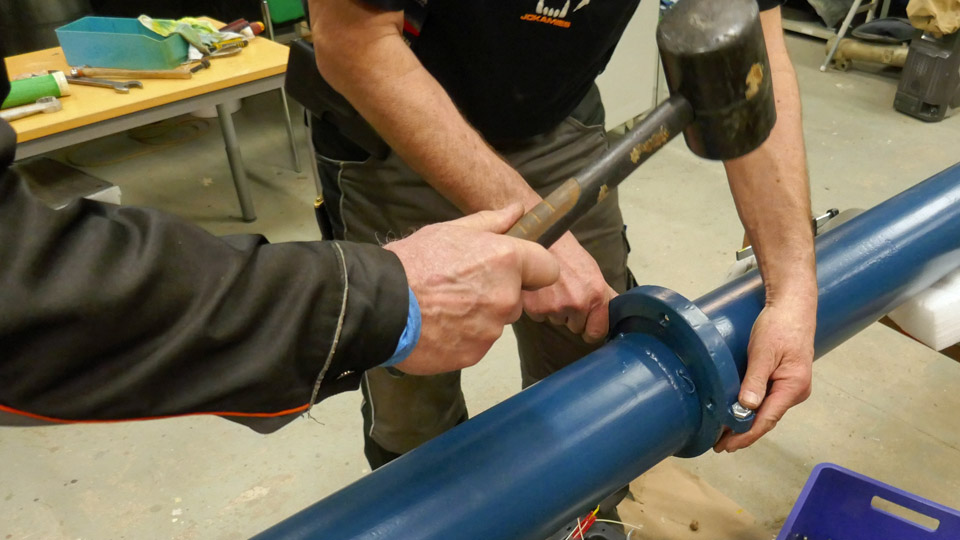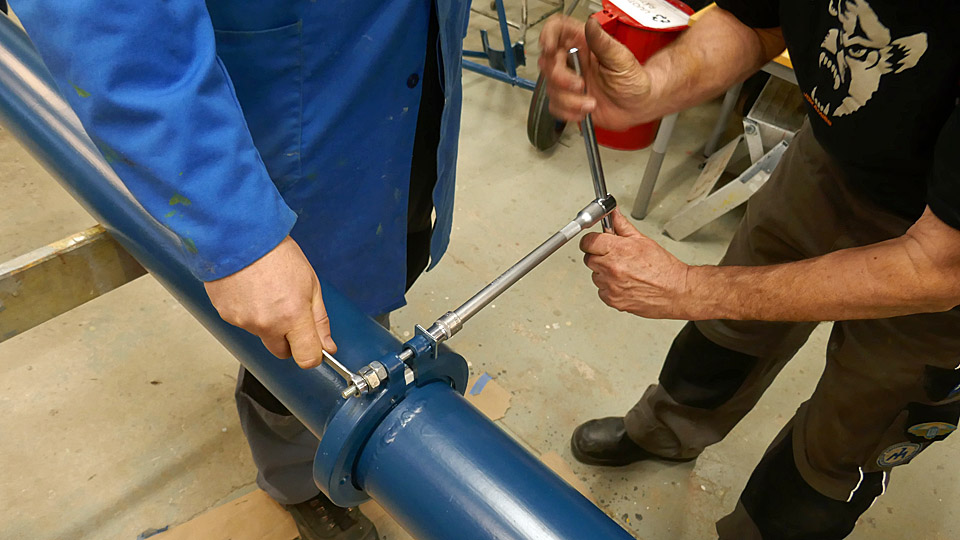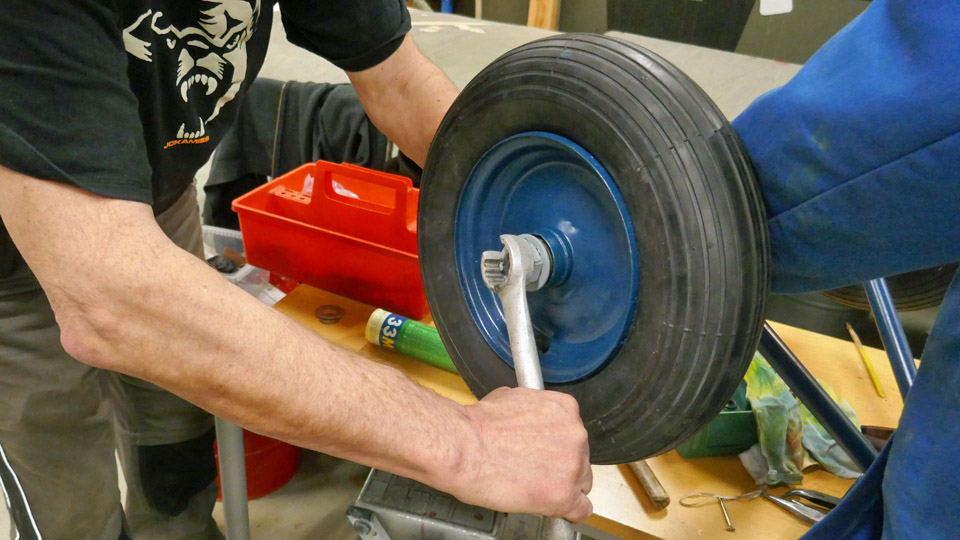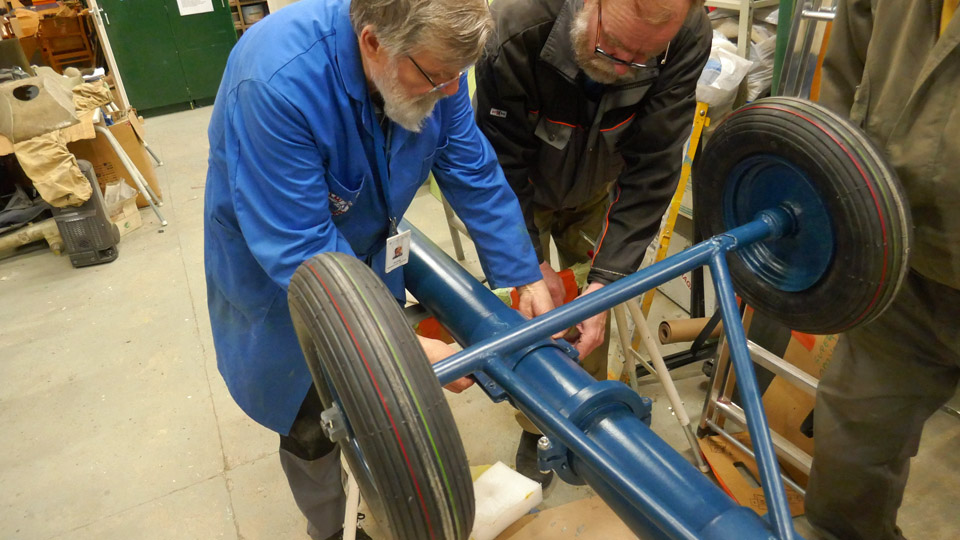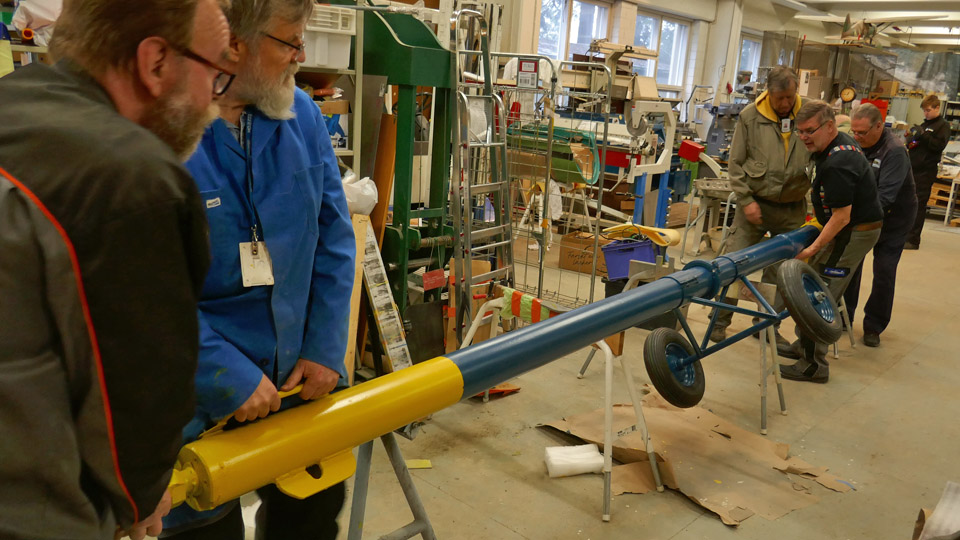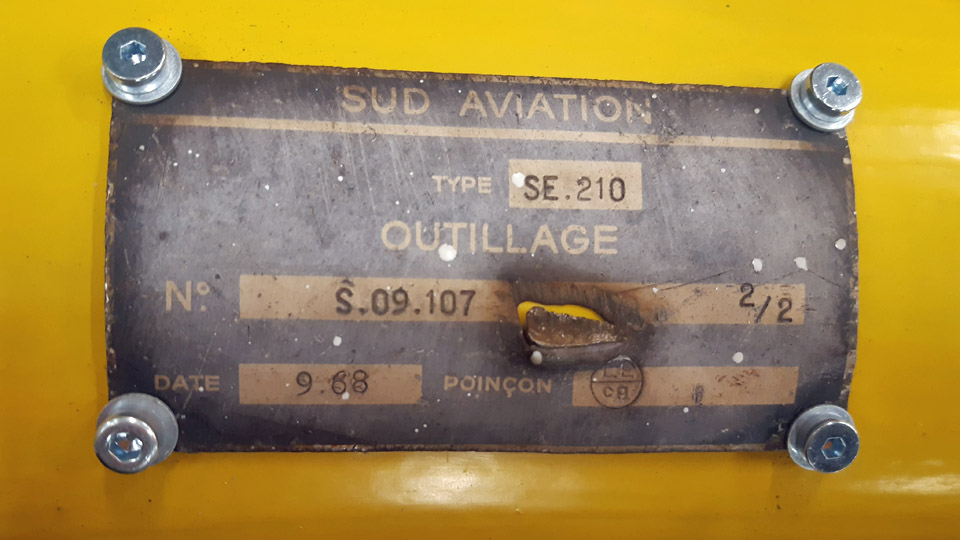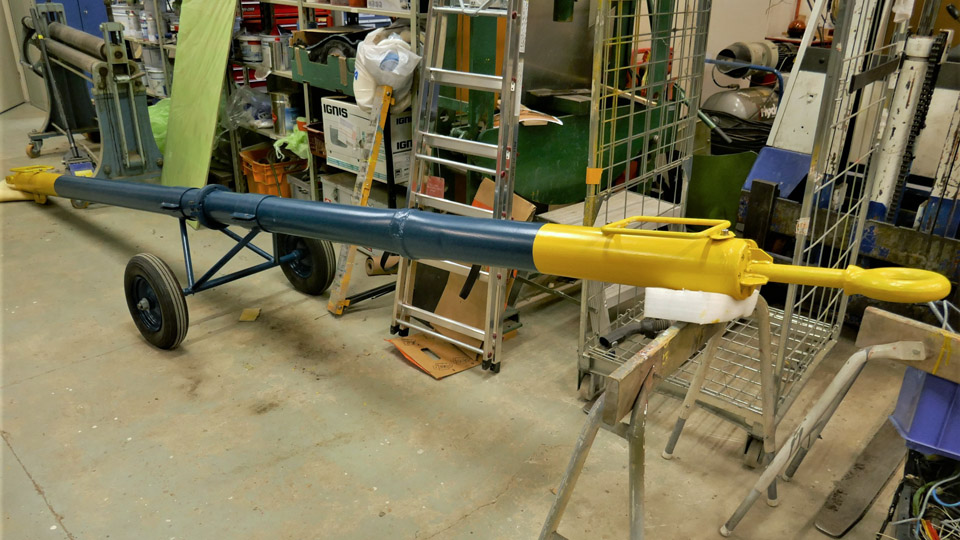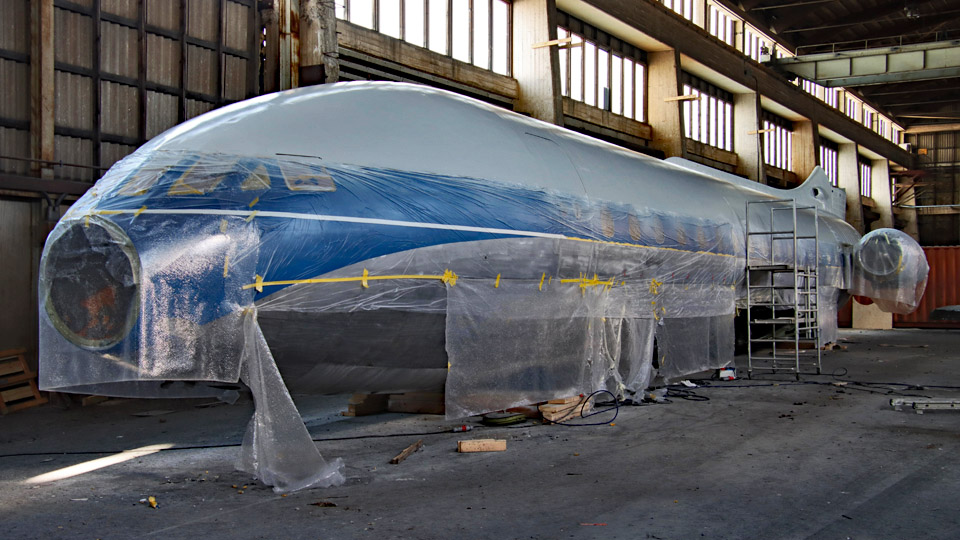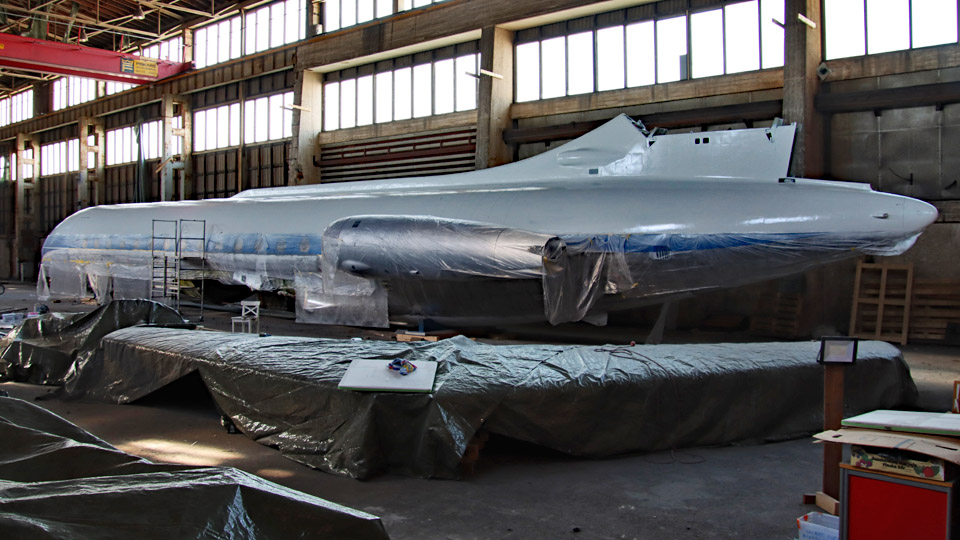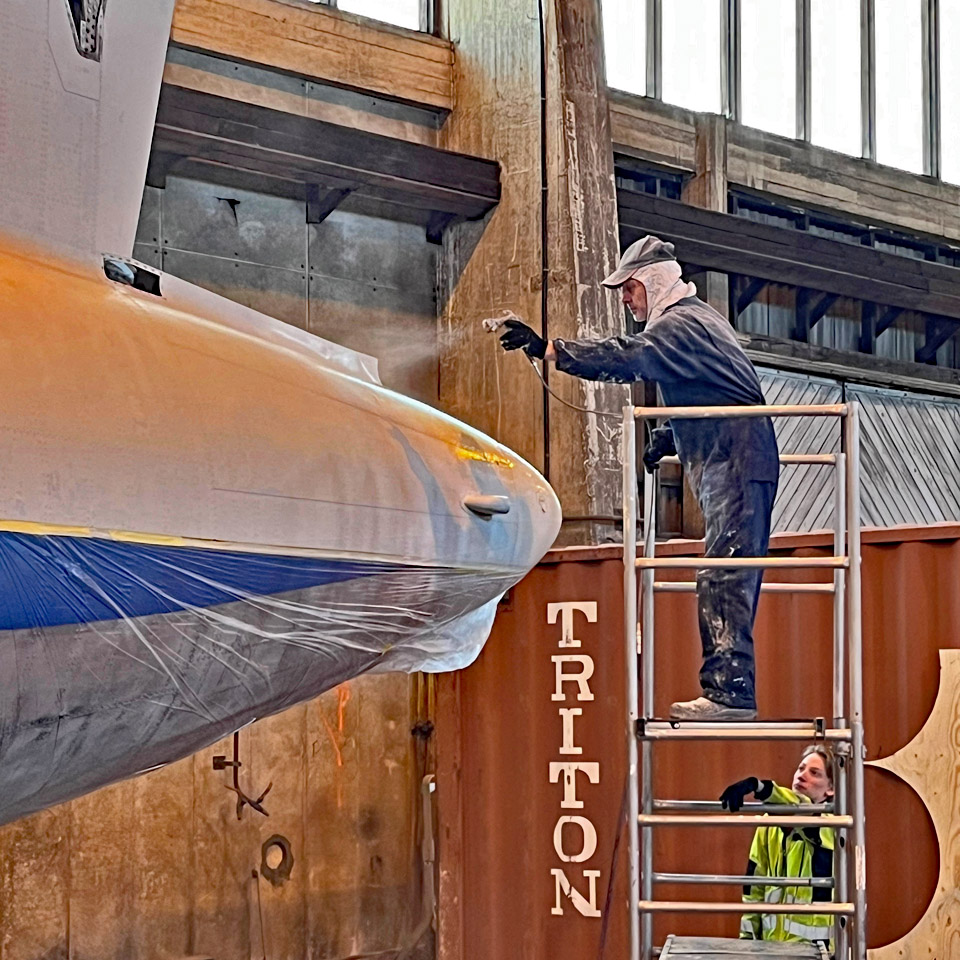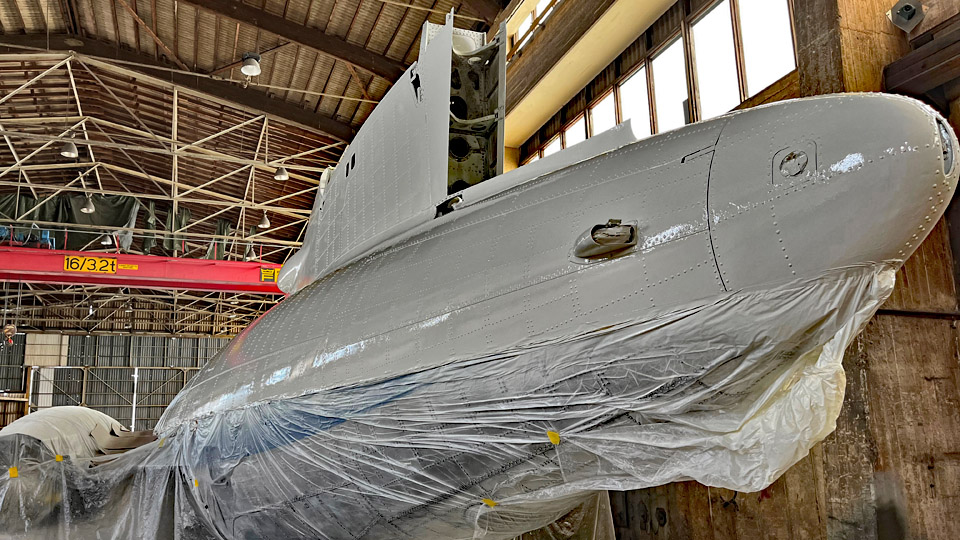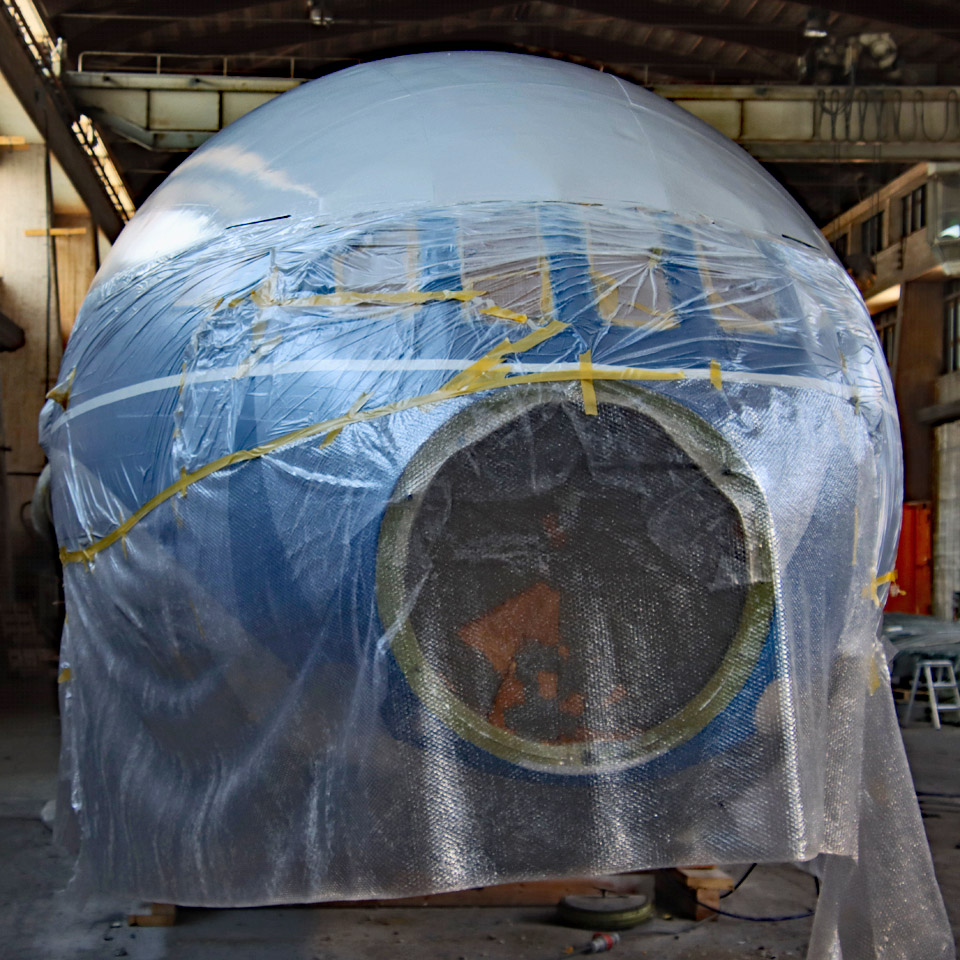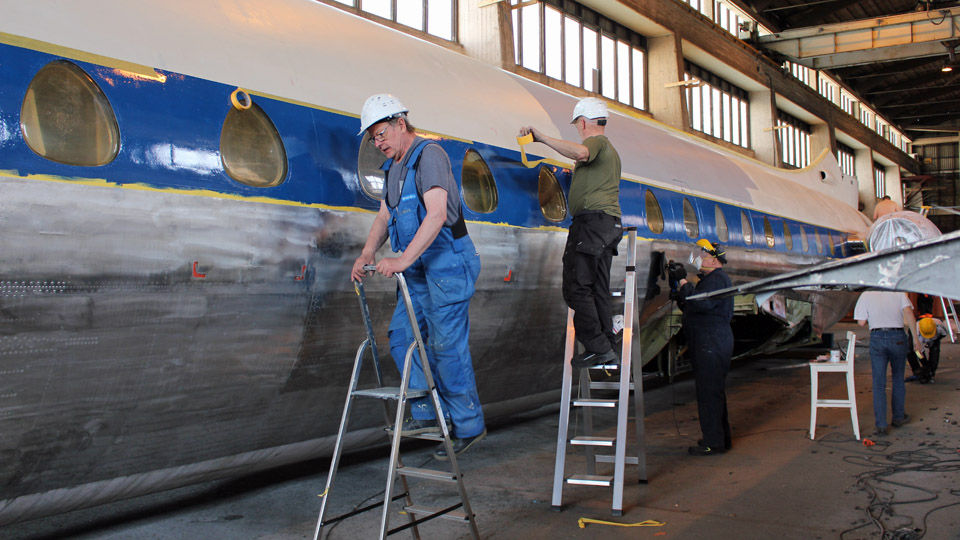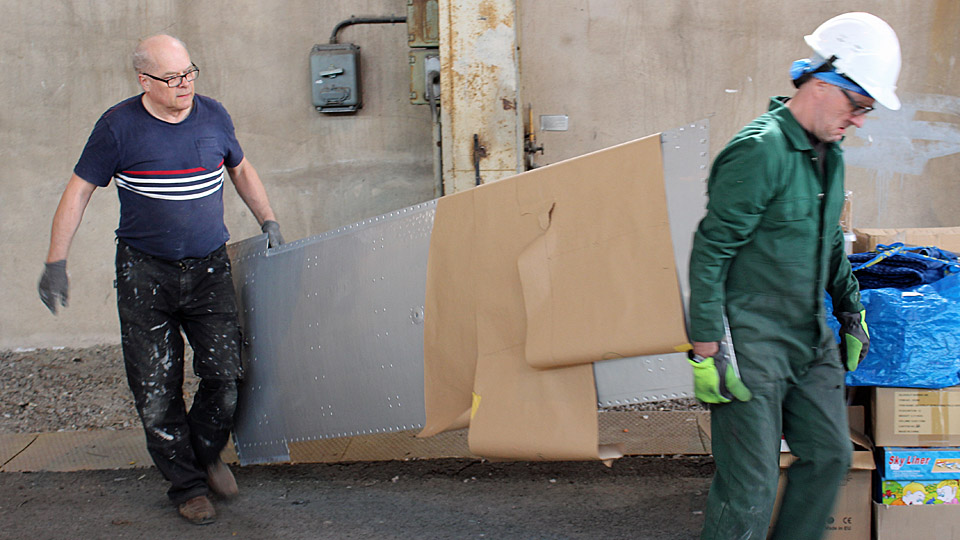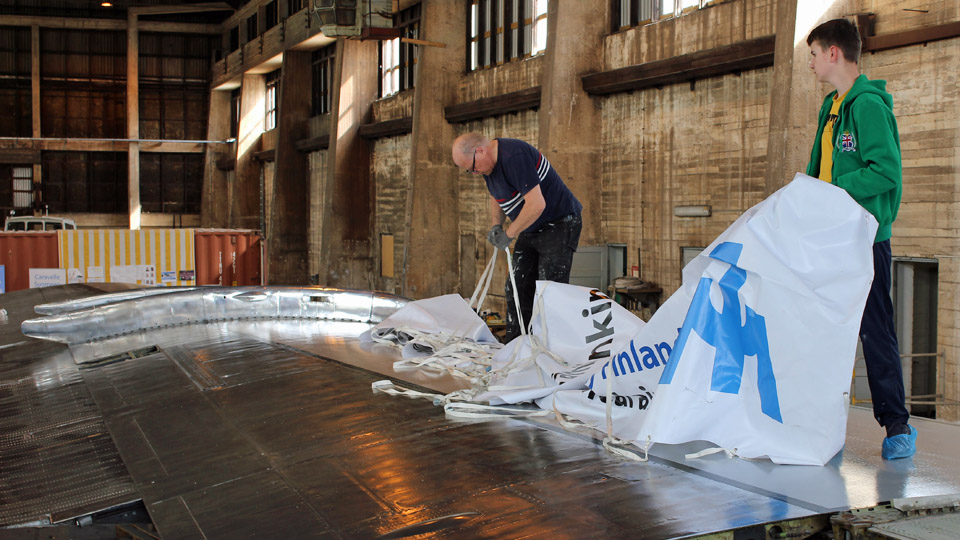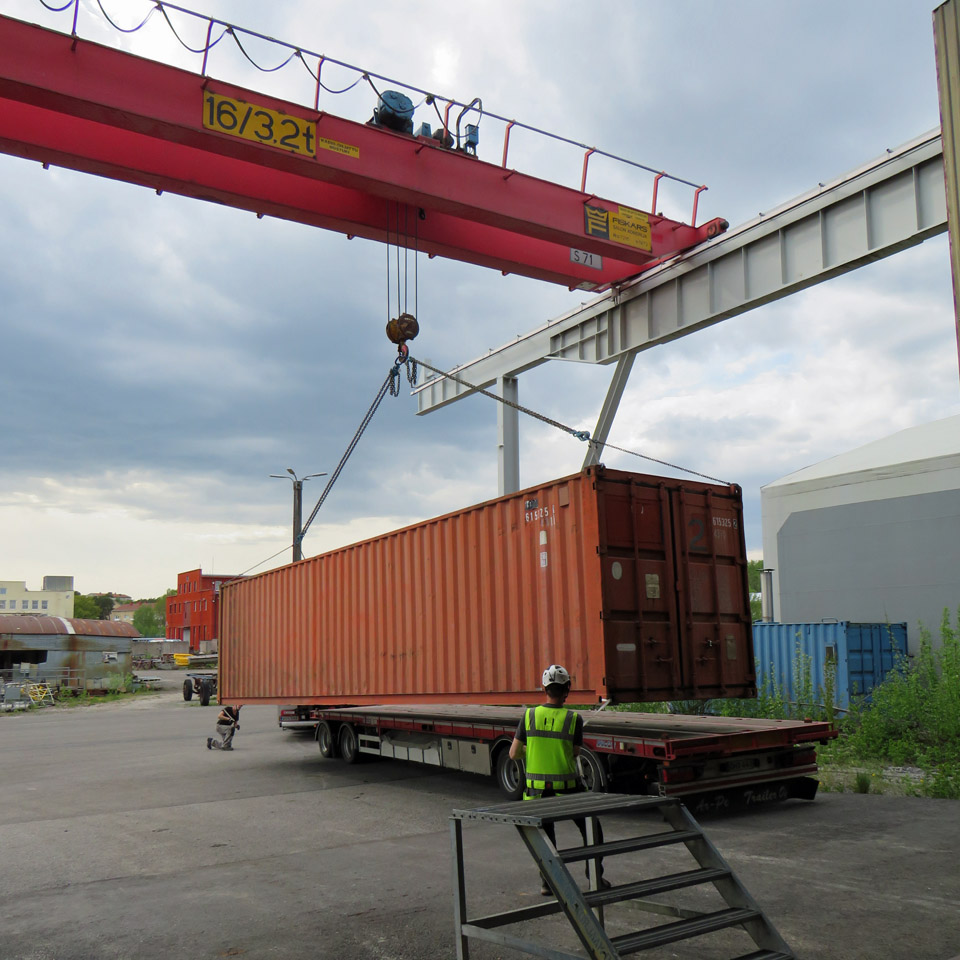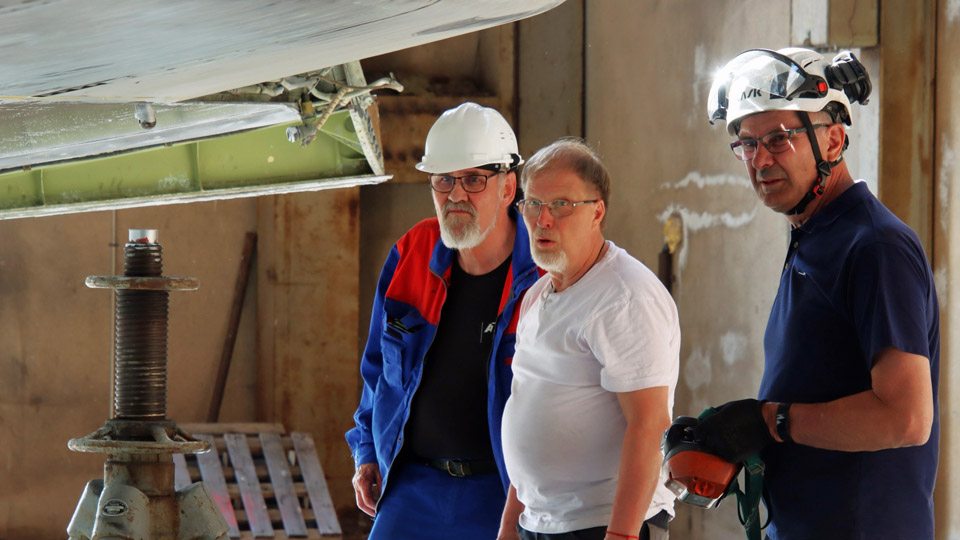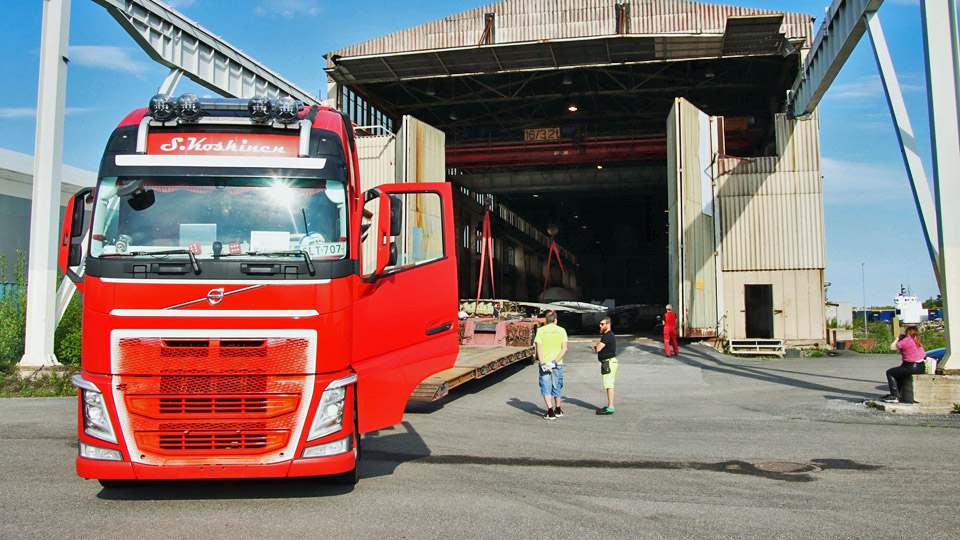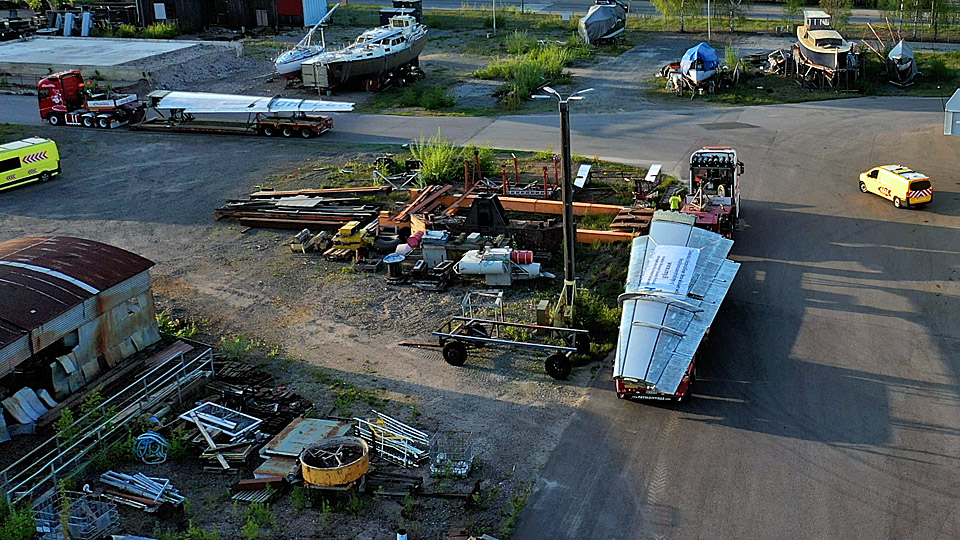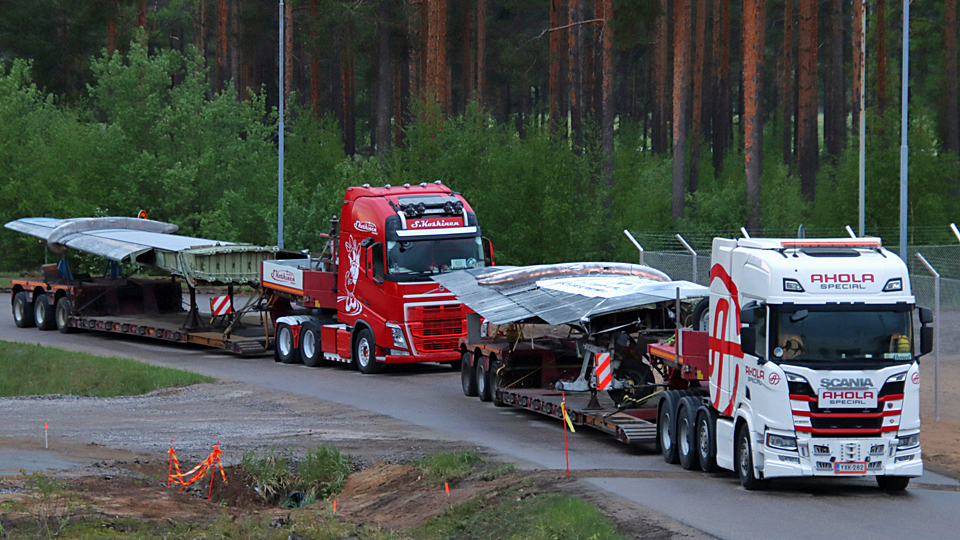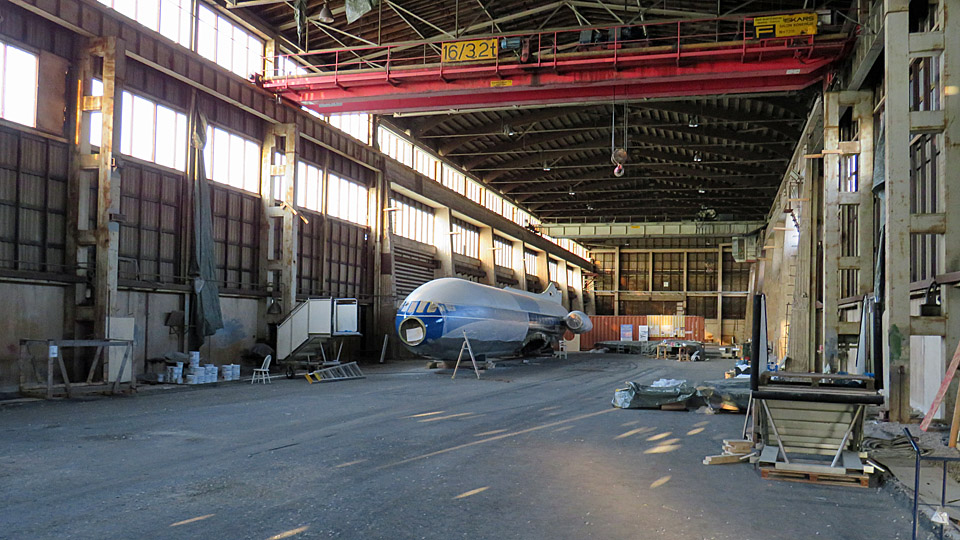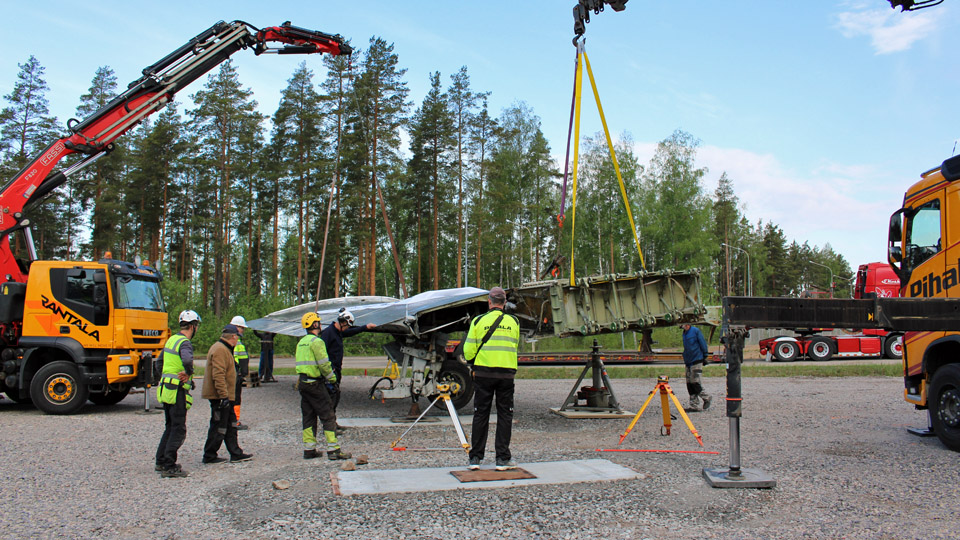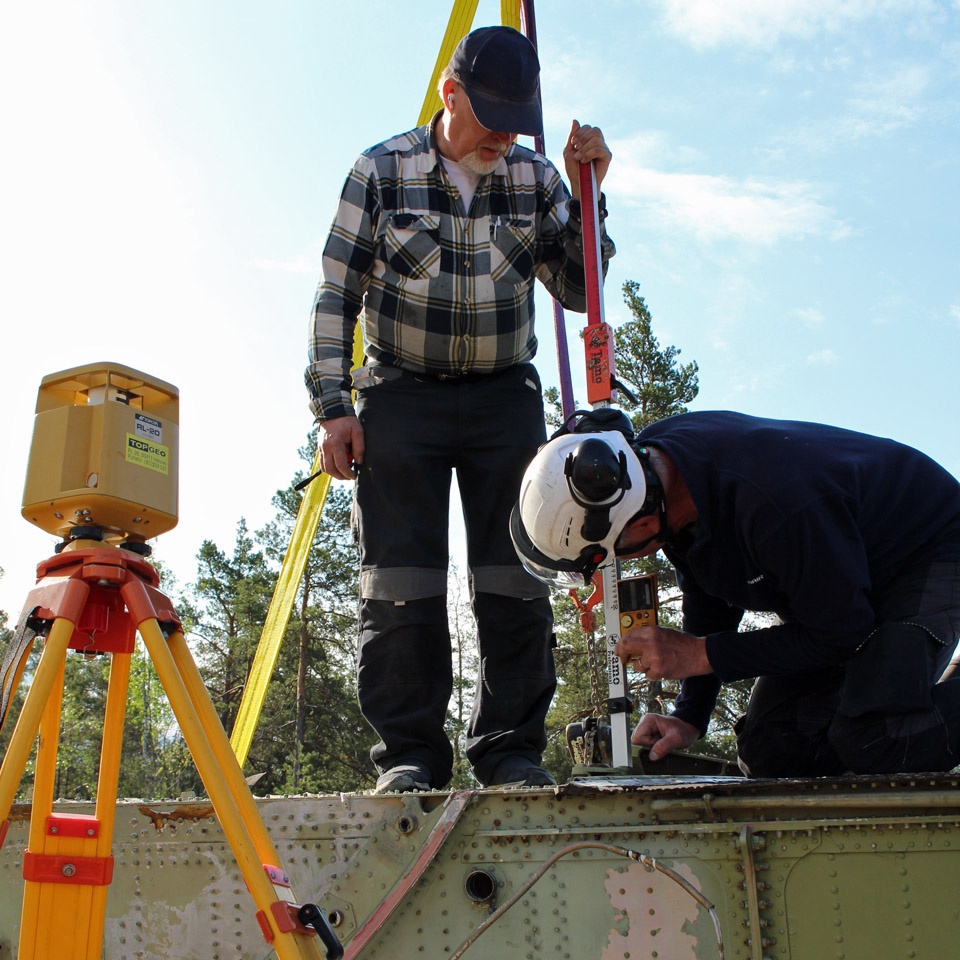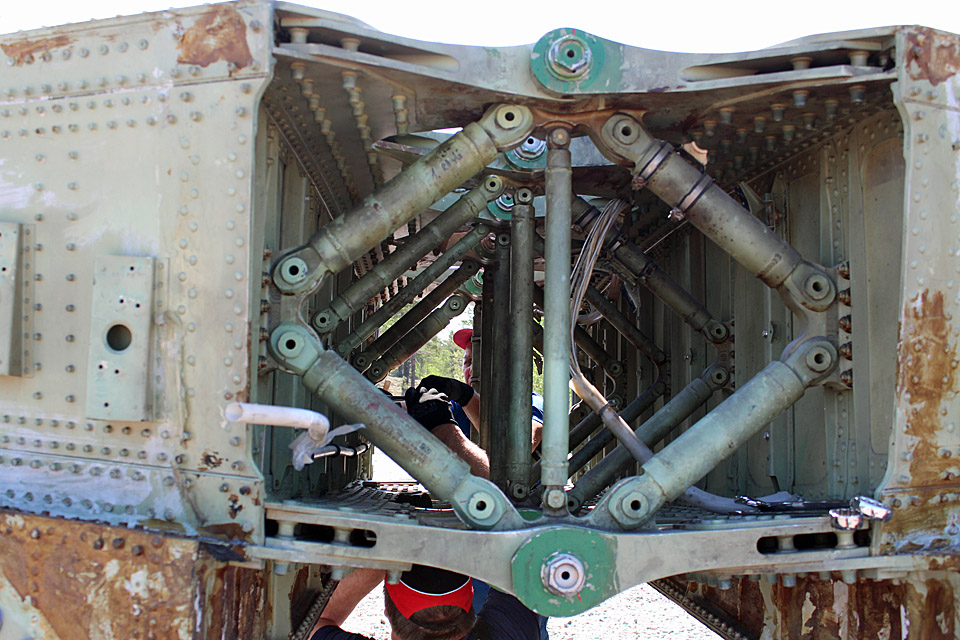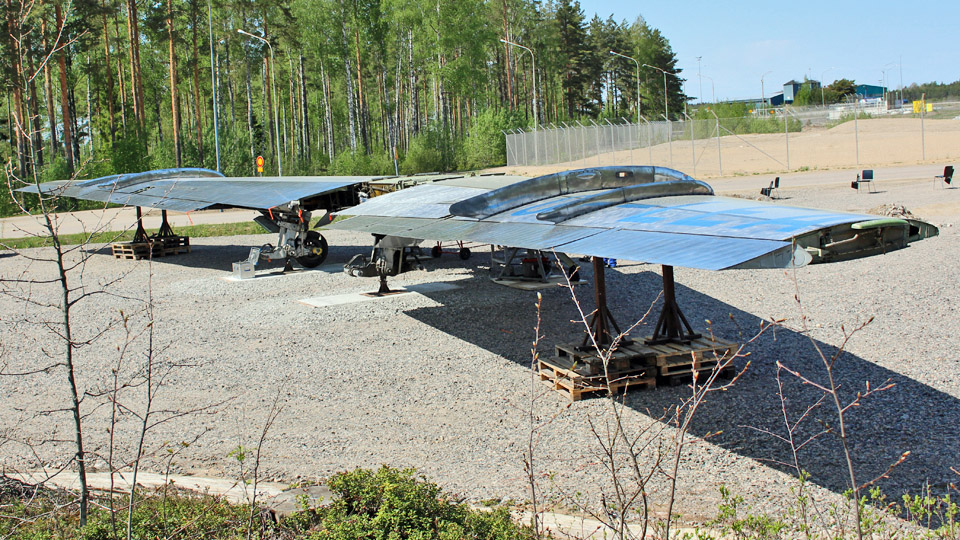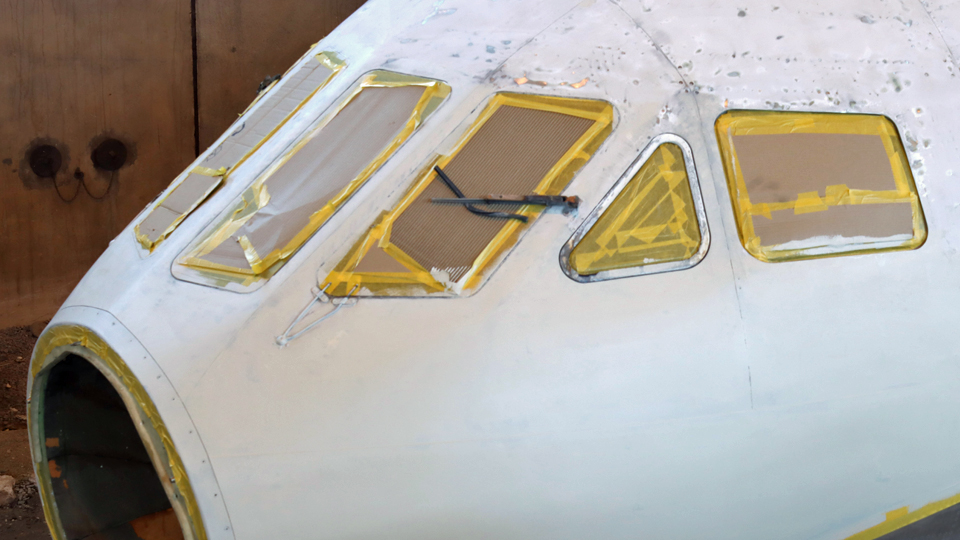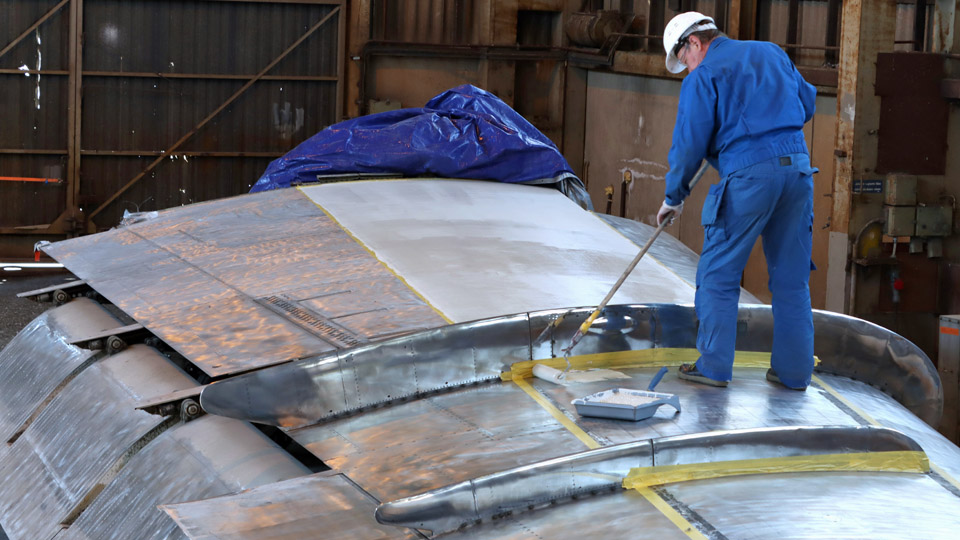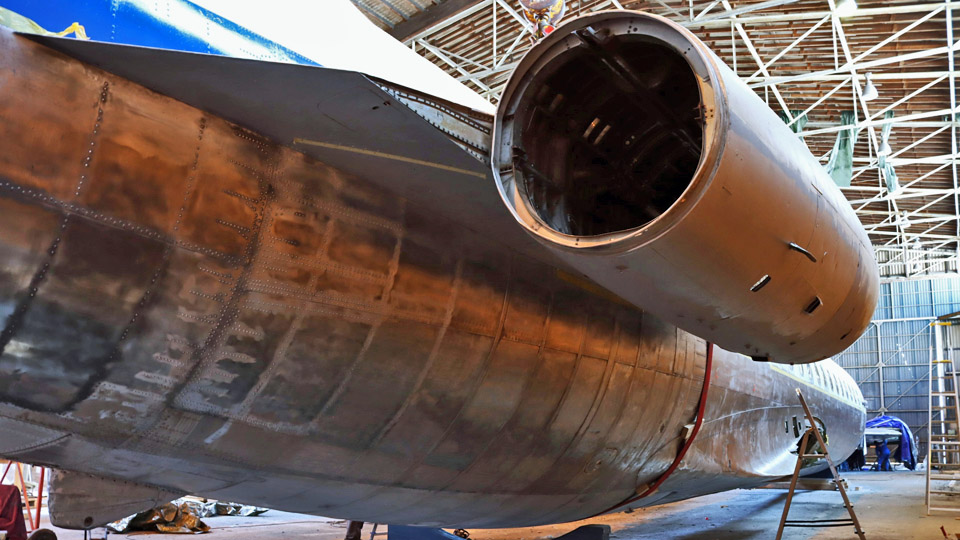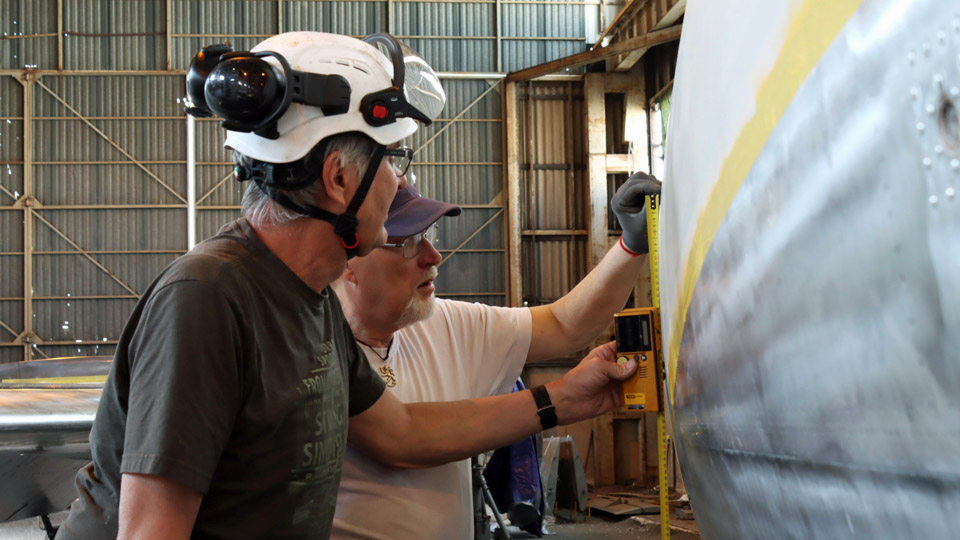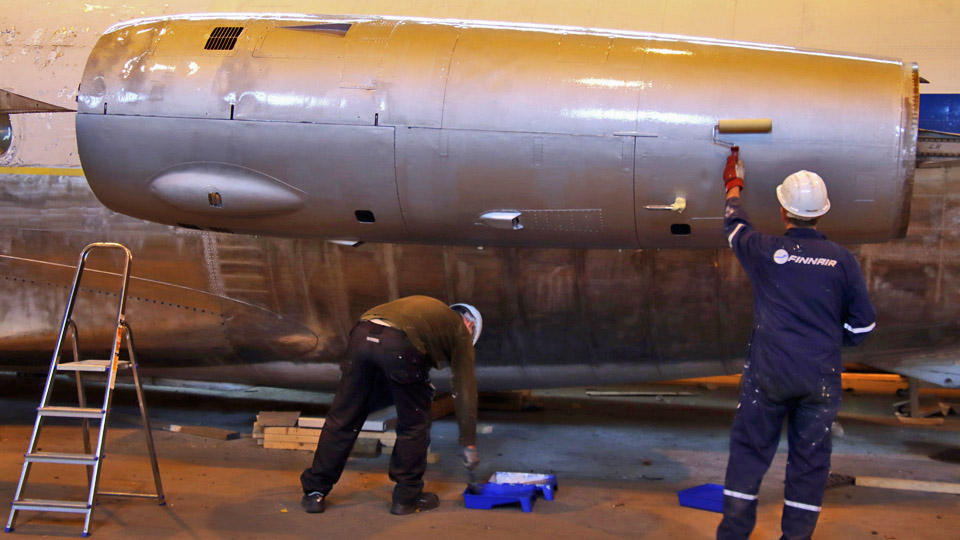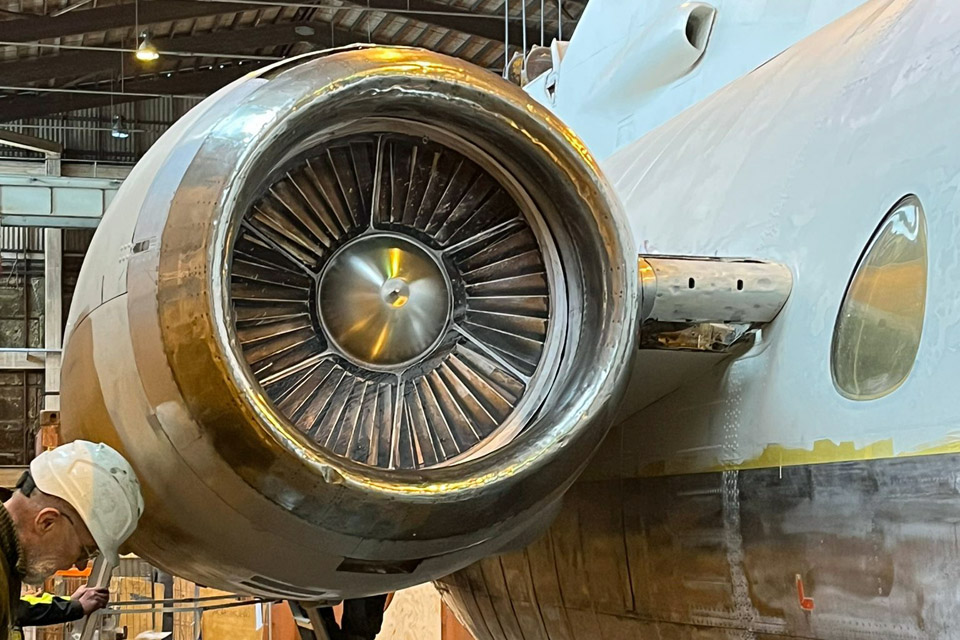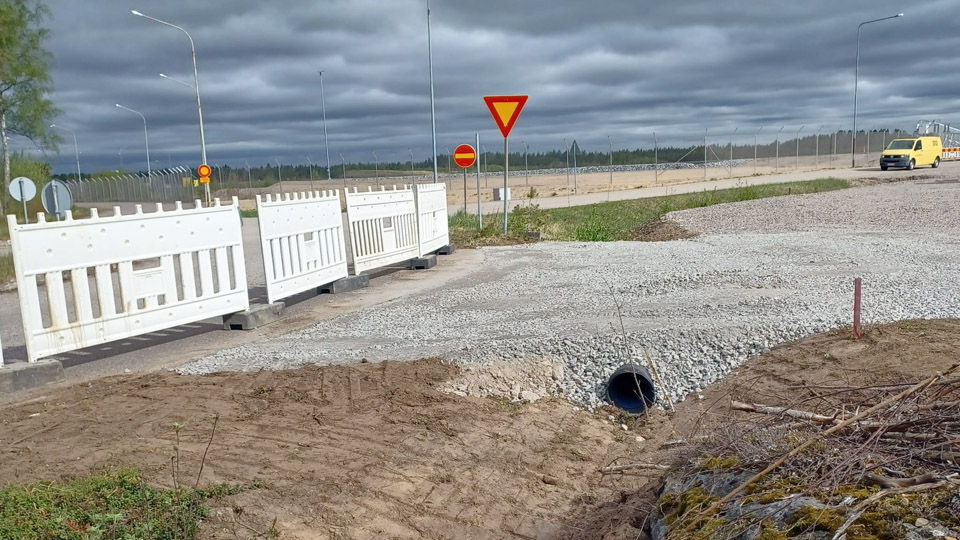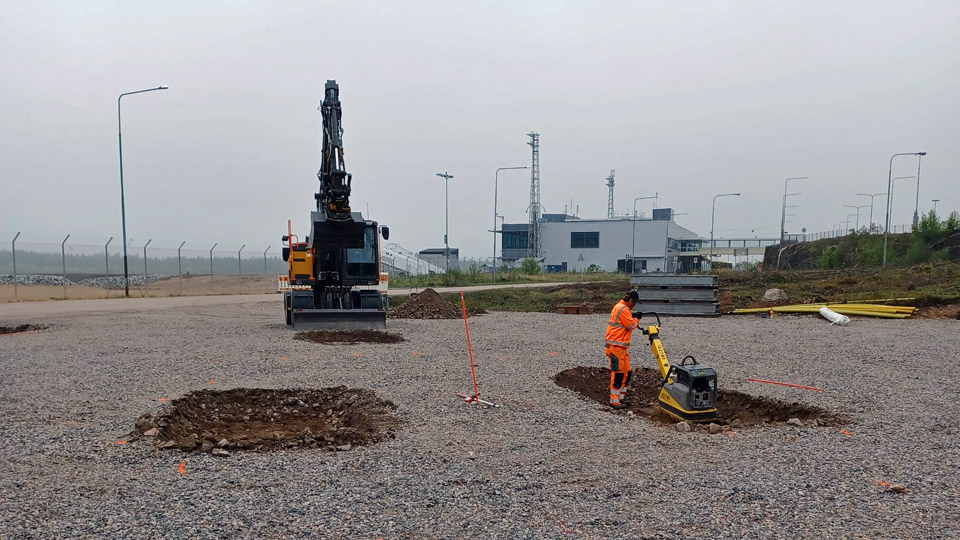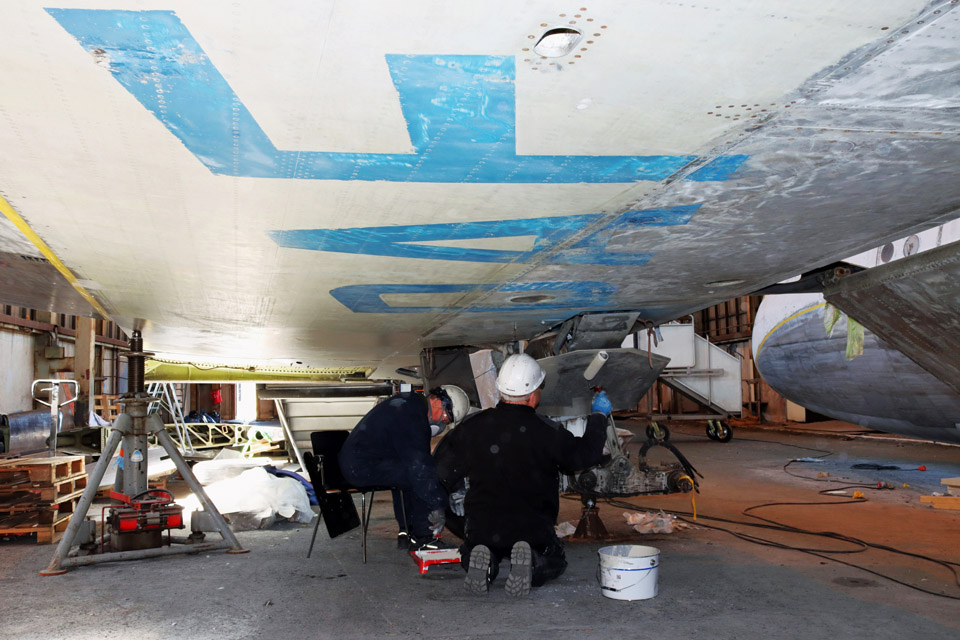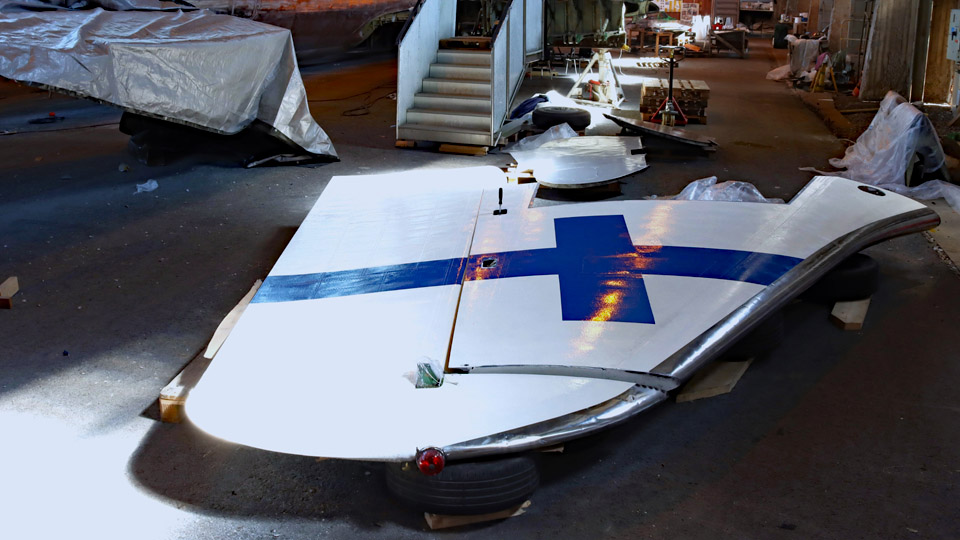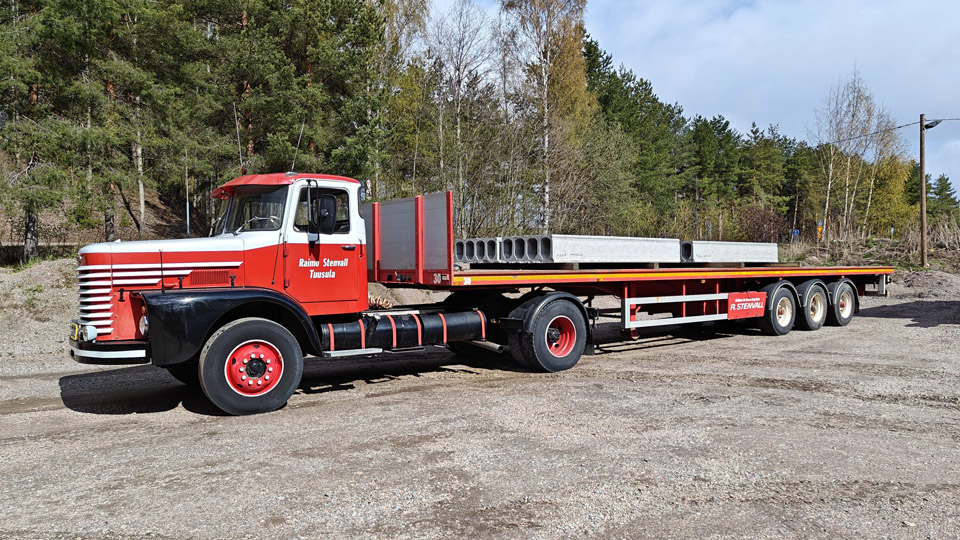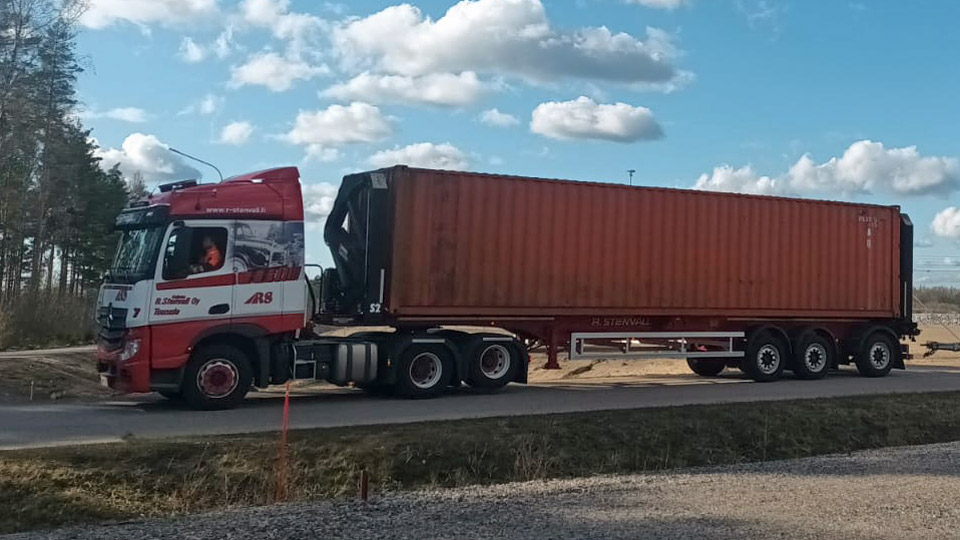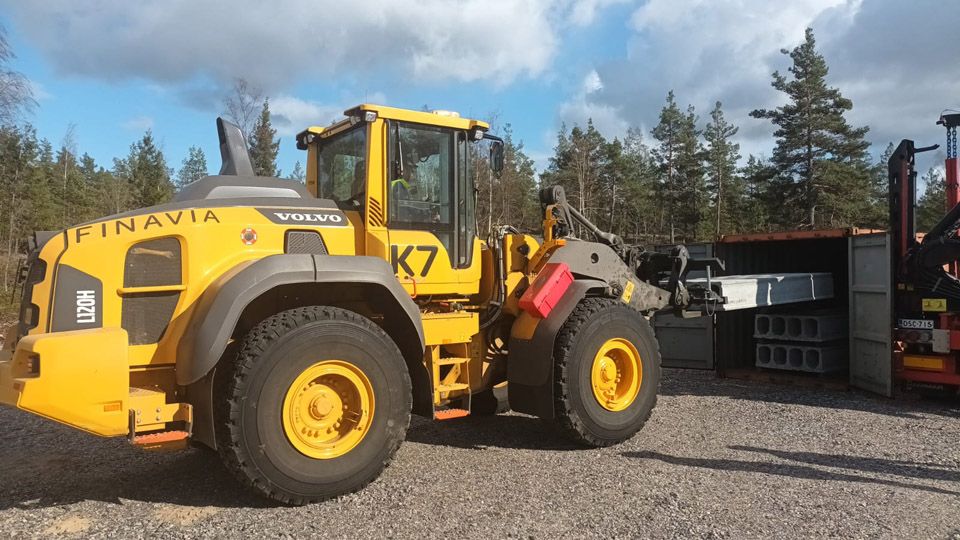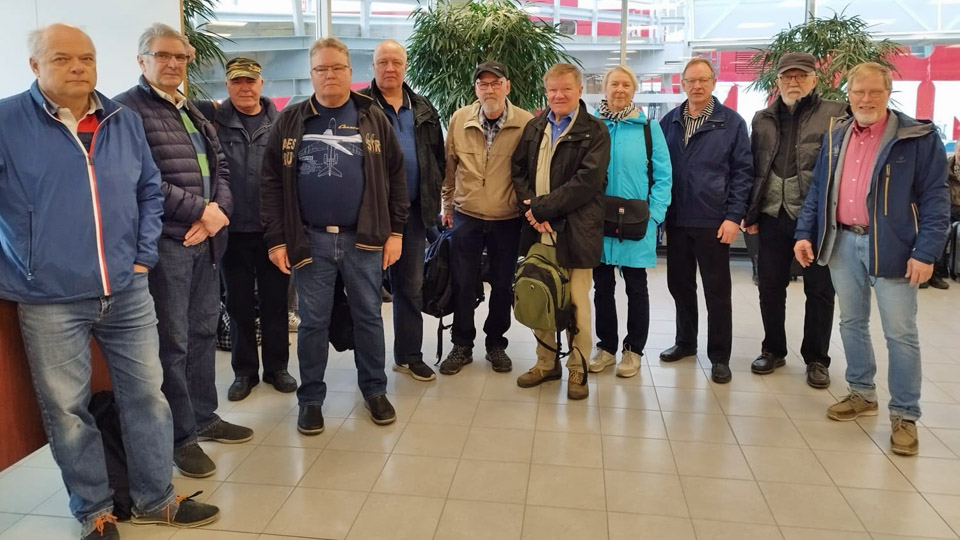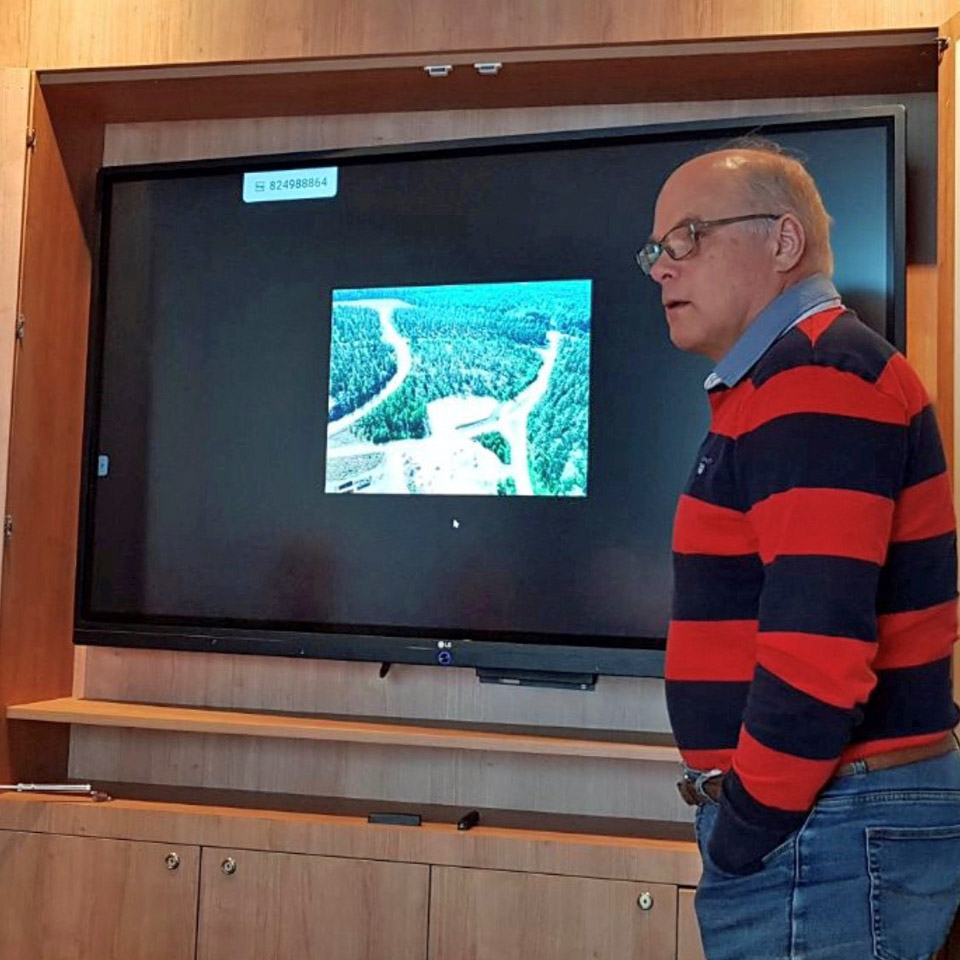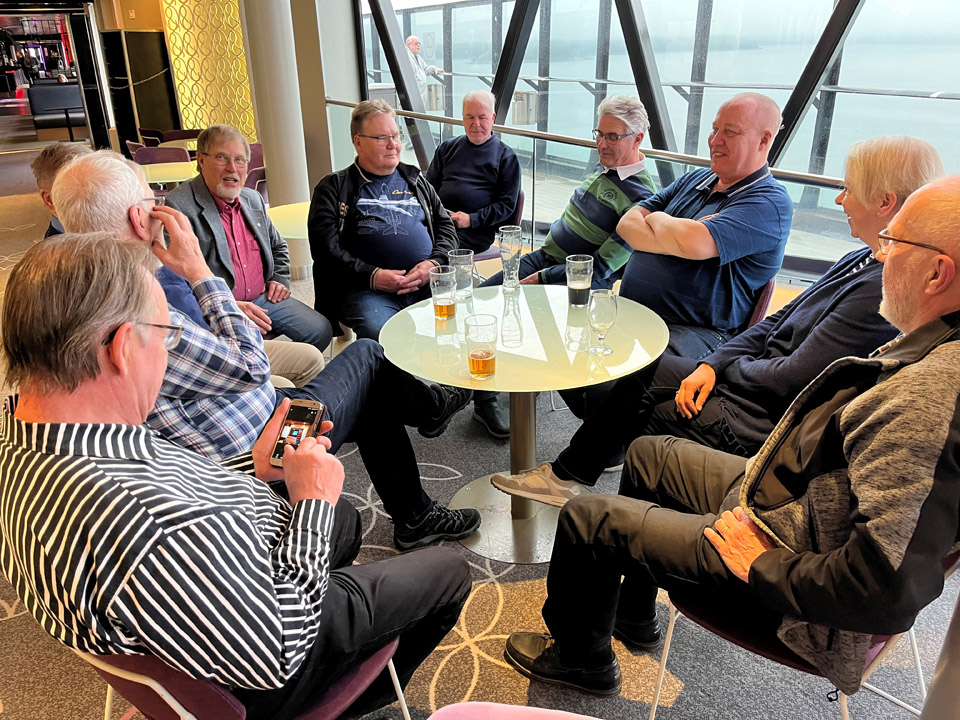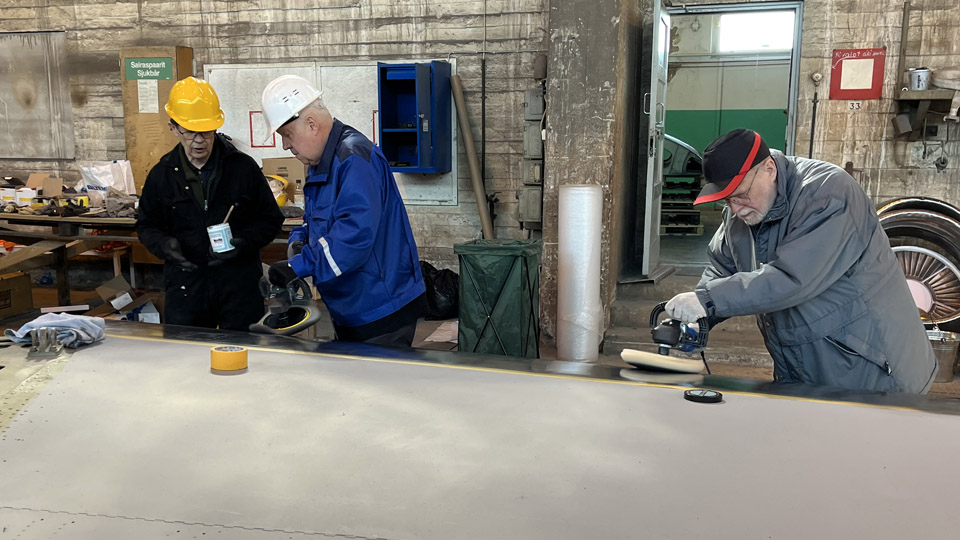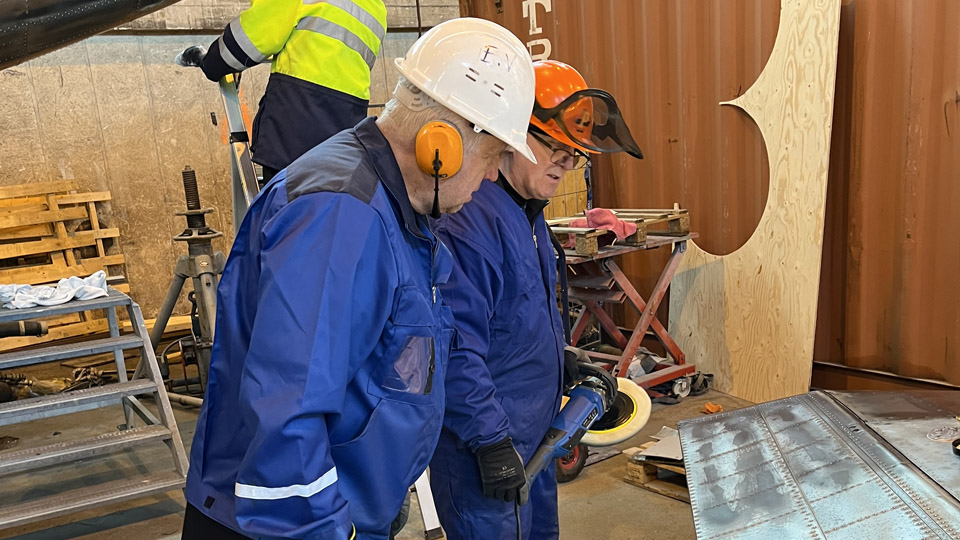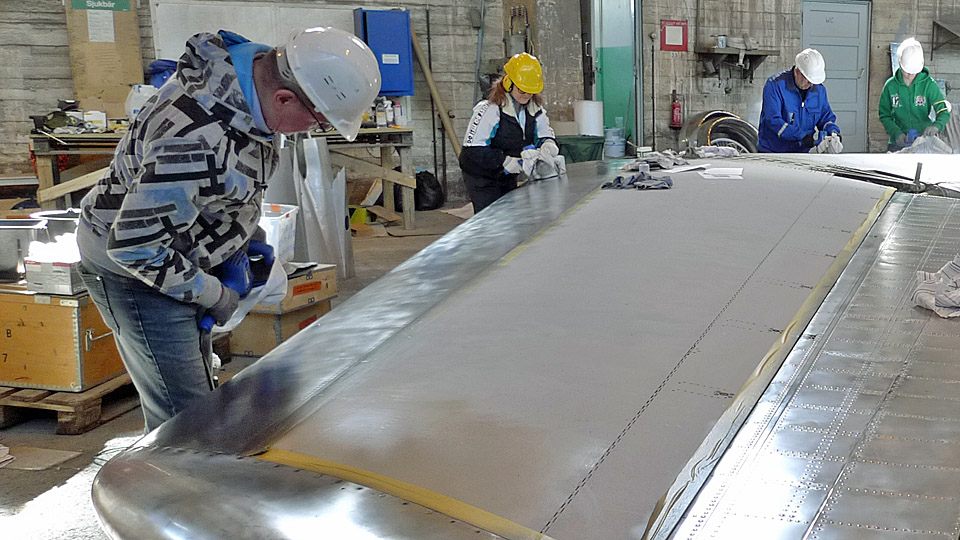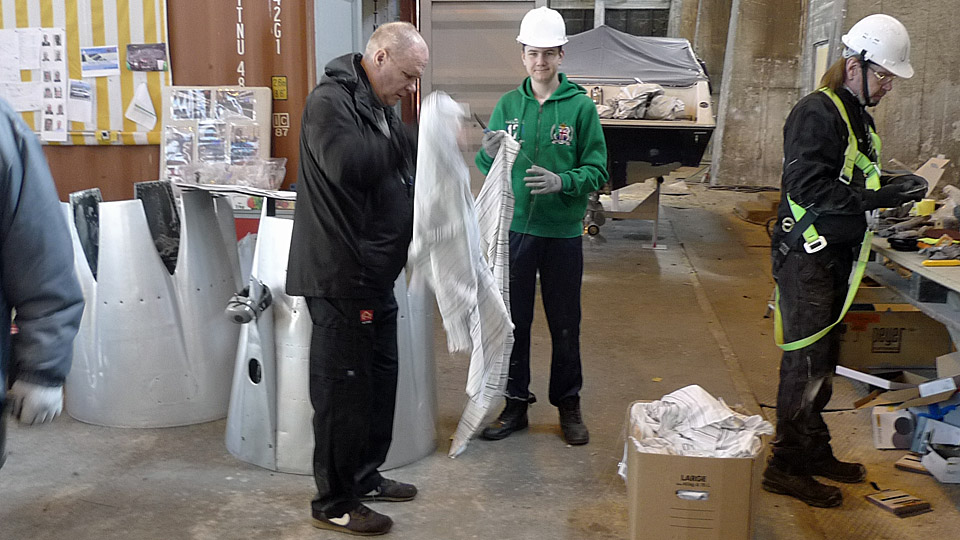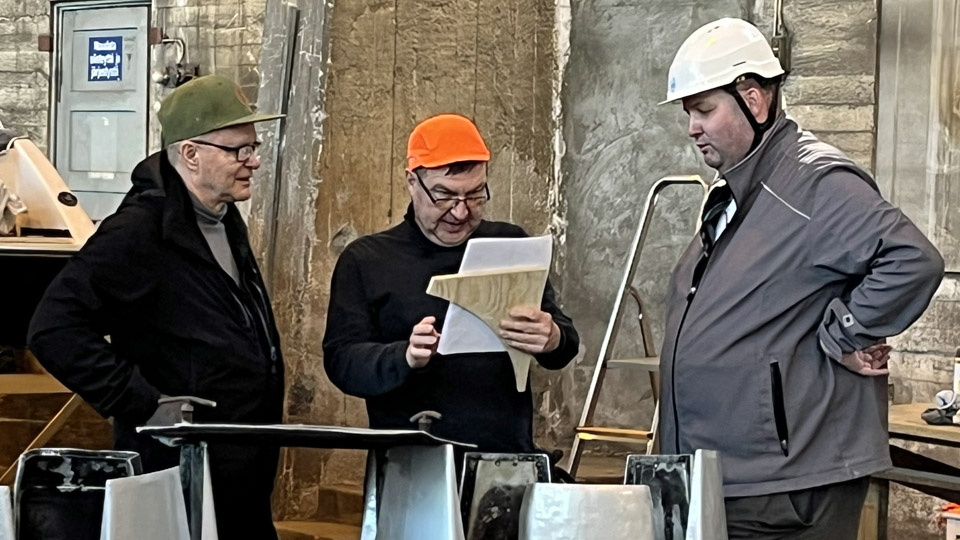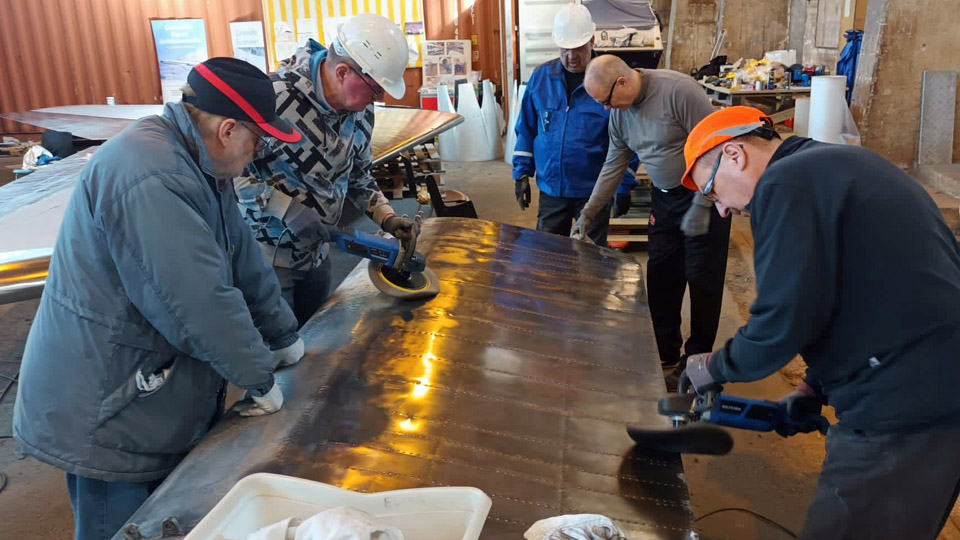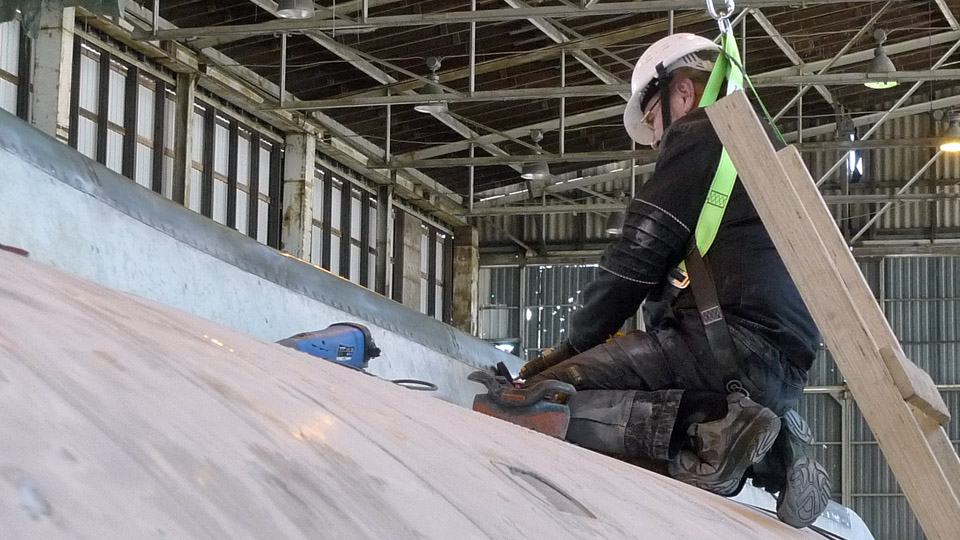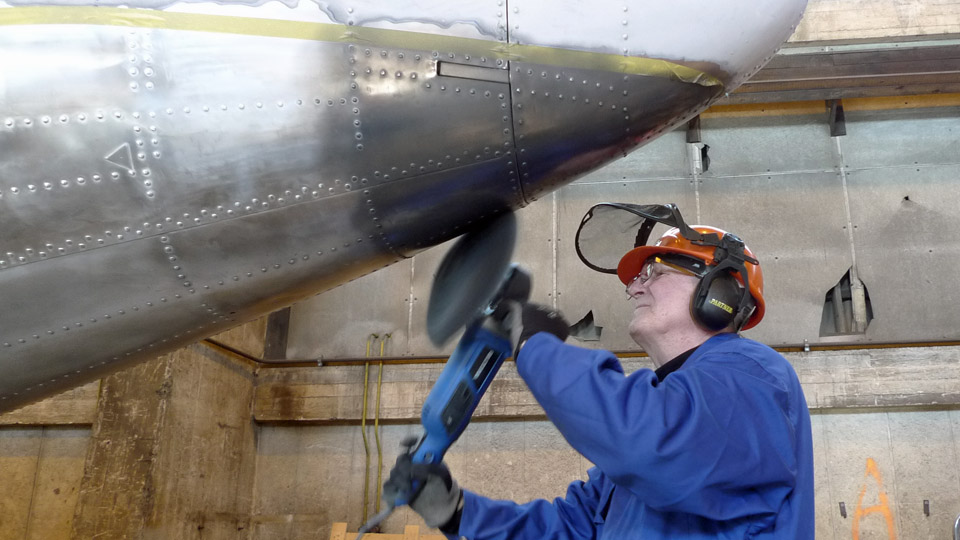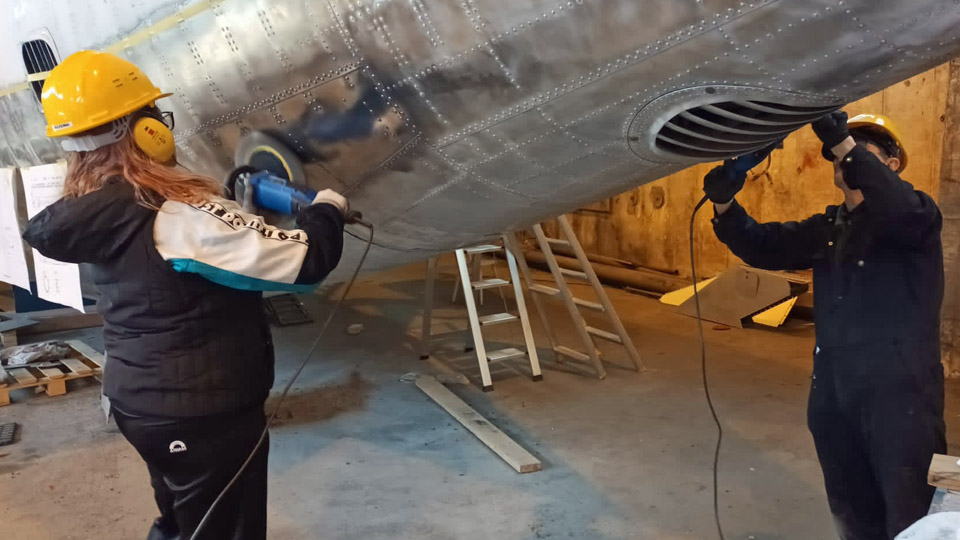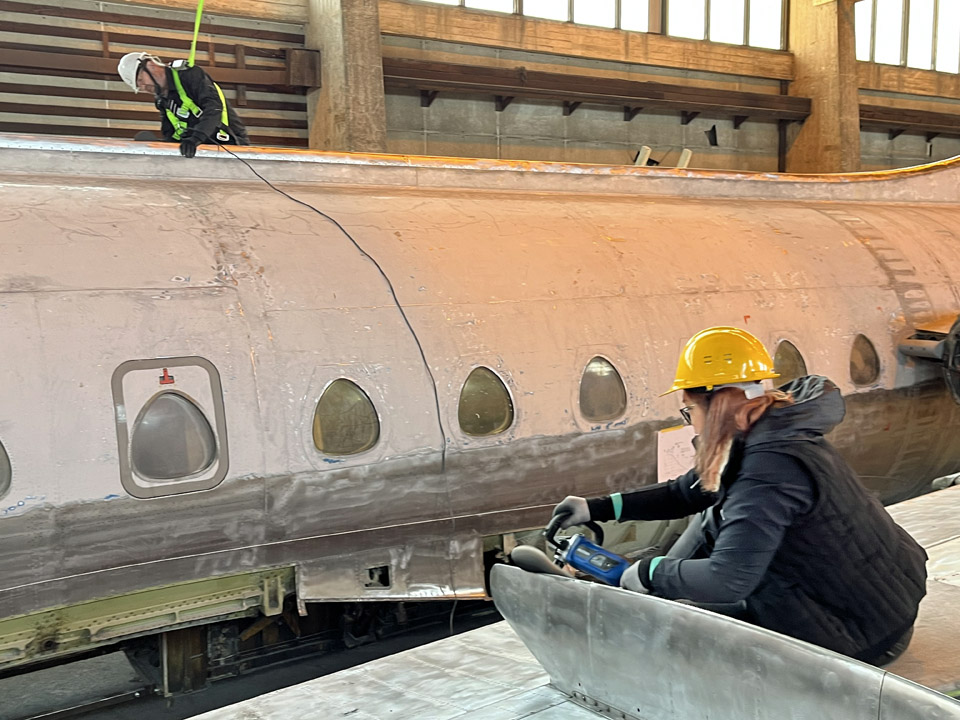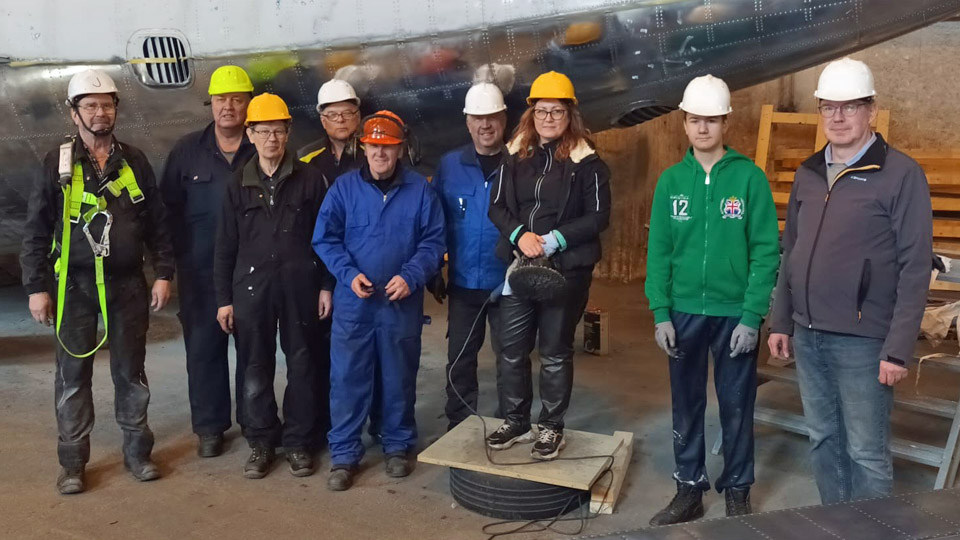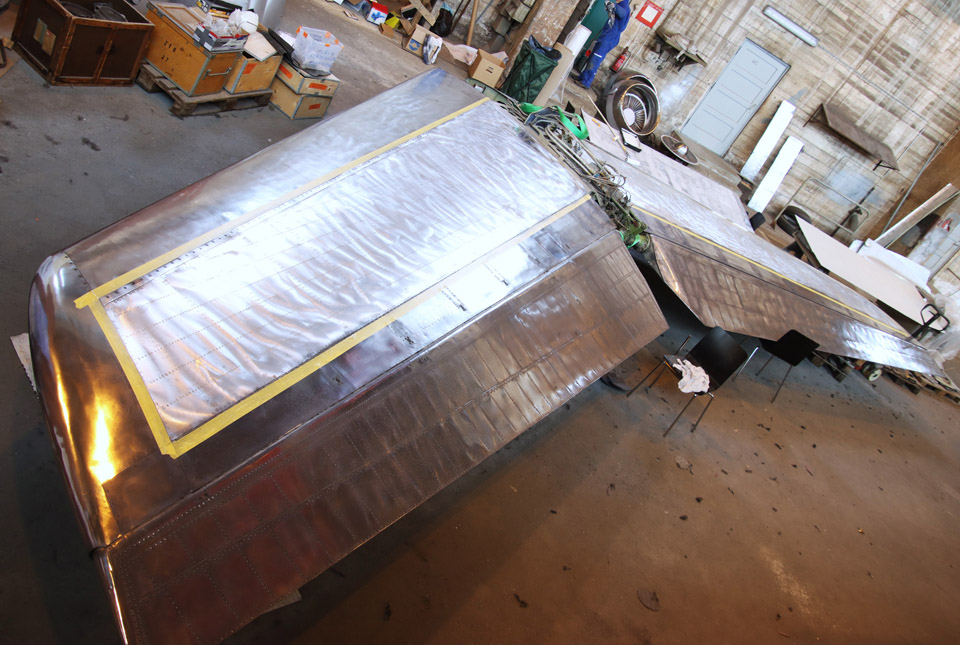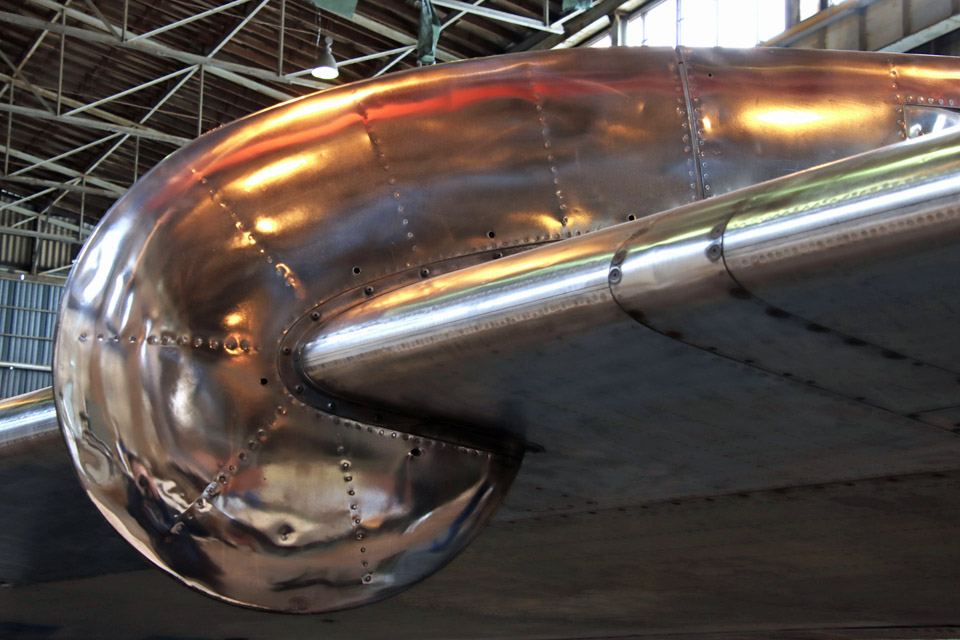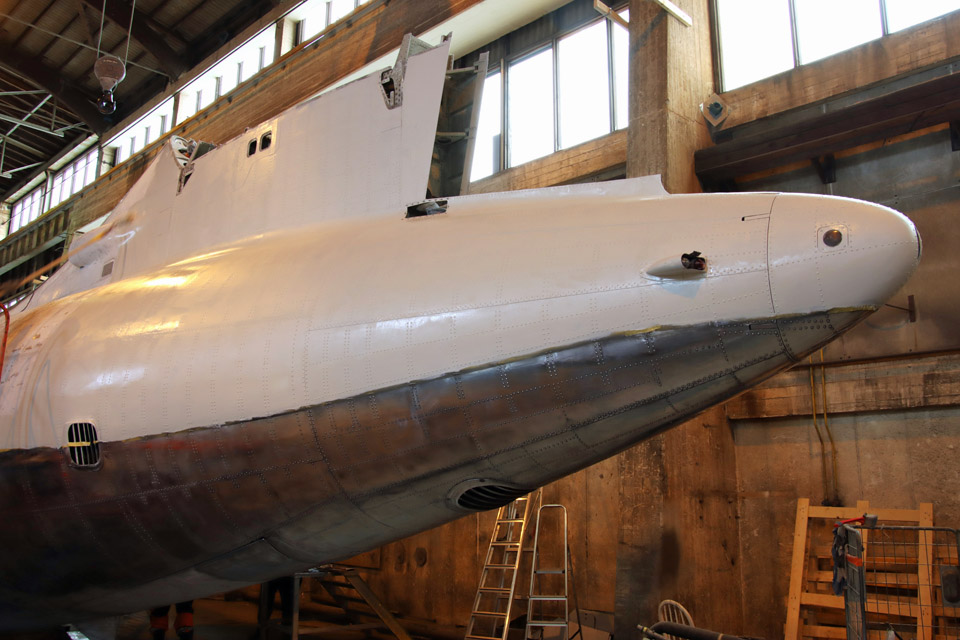Caravelle's autumn season started in the beginning of SeptemberKeskiviikko 6.9.2023 - Ismo Matinlauri The restoration work of the Caravelle OH-LEA at Turku airport started efficiently on Monday, September 4th, when there were nine volunteers at work. In the Turku area it rained a lot in August, and it wasn’t possible to do any of the remaining restoration work outside the aircraft. During the summer weekends the Caravelle was open to visitors, and this led to some restrictions to starting the work inside the aircraft.
On the last weekend we had the summer season’s last open doors event and after this it was possible to continue the restoration work from where we had left it in June. The half cloudy weather was ideal for sanding, polishing, and painting the last identification markings.
On the underside of the fuselage there is a small area which needs to be sanded and painted with aluminium colour paint. The last identification markings will be painted on the wings and fuselage. The largest of these is the registration OH-LEA missing on the underside of the wing.
Photos by Lassi Karivalo. A lot of polishing work is still needed, this is the main item to be completed on the outer surface. Polishing will be continued as long as the weather allows. However, there is so much to be polished that the work will continue next spring.
The work inside the aircraft has also started. The repairs and painting of the flight deck and the toilet area will be the first work items. The floor and the ceiling area in the cabin will follow in the coming weeks.
It was a pleasure to have visitors from the Tuesday Club at Vantaa. Three club members came to Turku to measure the openings on the tail of the DO-5, which is temporarily parked next to the Caravelle. Protecting covers will be made at the Tuesday Club to cover the holes before the autumn storms arrive.
The busy afternoon was spent at work, but there was a moment for lively discussion when the Turku team and the Tuesday Club members had a coffee break together inside the aircraft at “Café Caravelle”. The Tuesday Club is a valuable support and aid for the Turku team when the details of the restoration work are pondered. We are looking forward to making good progress during the autumn. Photos by Jouko Tarponen except if otherwise mentioned. Translation by Erja Reinikainen. |
|
Avainsanat: aviation history, restoration, Caravelle, OH-LEA, Sinilintu, Bluebird, Tuesday Club |
Caravelle visitors are welcomeTiistai 4.7.2023 - Ismo Matinlauri The Caravelle restoration team went on a well-earned summer holiday after the Turku Airshow. The restoration work is not finished outside or inside, and the team will continue its work in August. However, the unfinished appearance isn’t an obstacle for presenting the aircraft to the interested audience. The nearly 1300 visitors during the Airshow days proved this to be true.
Last week I had the pleasure of presenting the Caravelle to a group of motor bikers consisting of Hornet-men mainly from the Defence Forces, Insta, Finnair and Patria. This was a group of experts and the first hour or so was spent outside the aircraft discussing the wing construction and engines. The Caravelle’s history and similarities to the Comet, especially in the flight deck, were discussed, too.
The visit to the cabin and flight deck was brief, mainly due to the temperature resembling a sauna. There the visitors concentrated on the differences in the passenger cabins of modern and 1960s aircraft. The seat frames in the rear cabin caught the visitors’ attention as they are not from a Caravelle III.
I thank the visitors for their interest in our project – and take the opportunity to welcome more visitors to come and see the Caravelle. English-speaking vistors are welcome, too! At the moment we don’t have regular visiting times, but we try to be flexible in arranging someone to come and give a tour. Feel free to contact me about a visit, preferably well in advance, so that we can arrange a tour for you. Contact berfore visiting: Ismo Matinlauri, +358405013495, matinlaurii(at)gmail.com Photos by Ismo Matinlauri. Translation by Erja Reinikainen. |
|
Avainsanat: aviation history, restoration, Caravelle, OH-LEA, Sinilintu, Bluebird |
Thank you to the supporters of the Caravelle projectKeskiviikko 21.6.2023 - Erja Reinikainen We managed to restore the SAS Caravelle III Sven Viking, abandoned on the edge of the airfield for decades, to the Finnair OH-LEA Bluebird in the schedule we had defined. It was open to the public during the Turku Airshow at Turku airport, on June 17th and 18th. On both days there was a queue at the Bluebird’s gate and the volunteer guides, who have been involved in the restoration work, had an interested audience. After a successful effort – the restoration and the airshow weekend – the team of volunteers can relax and enjoy a well-earned summer holiday.
Photos by Jouko Tarponen We think that this is a good moment to thank all those who have supported the Caravelle project. Without you the Bluebird wouldn’t be ready to be presented to the public. In this period of about a year and a half we have received financial support for the procurement of many important items. In a society operating on membership fees we appreciate your support very much. Many of you have lent us special tools which are needed in the disassembly and reassembly work. Without your help we wouldn’t have been able to get these tools. Furthermore, we have been given access to Caravelle archive data, we have been given lots of valuable advice and all kinds of help in the problems we have encountered during the project. We thank the companies and societies which have supported us. They are mentioned at the end of this blog. We thank all the private persons who have helped us in various ways during the project. And last but not least, we thank the family members and other close ones of our volunteers for patience and understanding for the OH-LEA Bluebird. Caravelle-project supporters: Statens Maritima on Transporthistoriska Museer (Sweden)
Arlanda Flygsamlingar (Sweden) / Jan Forsgren
Le Caravelle Club (Sweden) / Ulf Nyström
Swedavia (Sweden) / Andreas Persson
Danmarks Tekniske Museet, Helsingør (Denmark) / Susanne Krogh Jensen
Ahola Special
Finnlines
Rantala-yhtiöt
P. Tyllilä Linja Oy / Juhani Tyllilä, Katri Tyllilä, Kimmo Koskinen
Select Service Partner Finland Oy
Kuljetus R. Stenvall Oy / Jussi Mäkelä
Nostot & kuljetukset R. M. Laine Oy / Mikko Laine
Toolpoint
Hyvinkään Ilmailukerho ry
Finnair Tekniikka
Granlund
Finavia / Juha Aaltonen, Veli-Matti Paasikivi, EFTU kunnossapito
Canon
Port of Turku
RMR Merirakenne
Companies in the Pansio shipyard area
Teknos / Markku Uusitalo
Anzo / Oy C.E. Lindgren Ab
Jalmeri
Arctic Decals / Mika Jernfors
Peter Lampinen
Ronema
Consolis Parma
NCC
Ossi Harjula
Finnish Aviation Museum
The Media
|
|
Avainsanat: aviation history, restoration, Caravelle, OH-LEA, Sinilintu, Bluebird |
Turku Airshow - Caravelle flight to Las PalmasMaanantai 19.6.2023 - Erja Reinikainen During the weekend, June 17th and 18th, Turku airport was the venue for the Turku Airshow 2023, which was the main airshow of the year in Finland. Early this year this date was written in large numbers on the coffee room wall in the hall in Pansio, where the Caravelle was under restoration. The aim was to present the Caravelle to the public, outside and inside, and tell its story until this day. 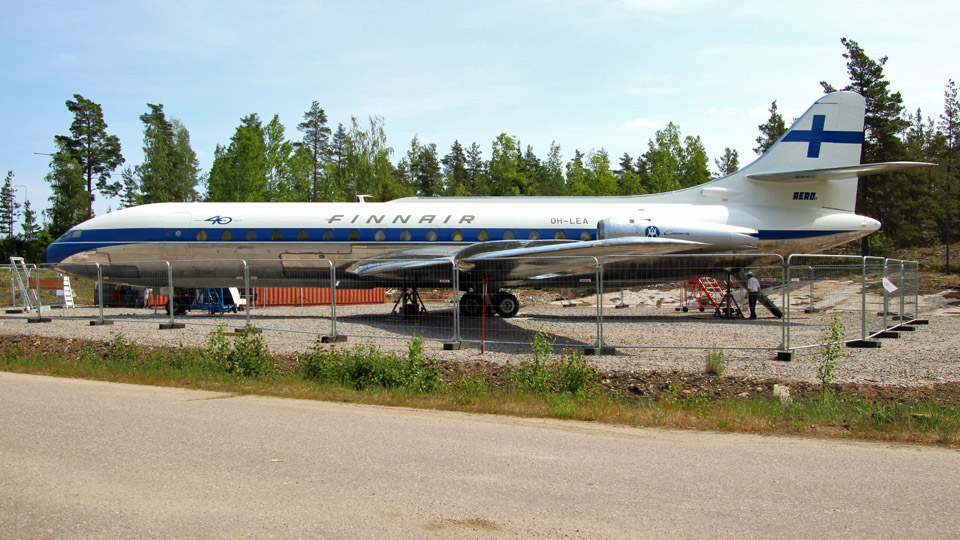 The Caravelle was outside the actual display area and because of this only those who came to the airshow by bus from Turku could visit the aircraft. On the other hand, the location by the pedestrian route allowed quick and easy access to the aircraft.
There were more visitors than we expected. On Saturday there were 865 and on Sunday 430 visitors, in total 1 295. At times the passenger stairs were crowded but some queuing didn’t seem to bother the good-humoured visitors. They told the Caravelle guides many stories about the aircraft. Sometimes it even seemed that the roles were interchanged. The visitor number 1000 was rewarded with a Caravelle key fob. Danial was the lucky winner who was congratulated by Jari Myrsky and received the key fob.
Photos by Ismo Matinlauri Another visitor must be mentioned. The WWII fighter veteran and Caravelle pilot Mauri Maunula stopped by to have a look at the replica of his previous aircraft. During his brief chat with the Aviation Museum Society Finland’s chairman Janne Salonen several colourful incidents from Mr Maunula’s Caravelle times were told.
There was a small but busy Aviation Museum Society Finland sales stall by the Caravelle. Caravelle caps, T-shirts and mugs were sold there. On the second day of the airshow old aviation magazines were handed out for free to those coming to see the Caravelle. The magazines were popular especially among the younger visitors. Photos by Jouko Tarponen except if otherwise mentioned. |
|
Avainsanat: aviation history, restoration, Caravelle, OH-LEA, Sinilintu, Bluebird |
Busy day at Turku AirportTorstai 8.6.2023 - Erja Reinikainen On Wednesday, June 7th, there were about a dozen volunteers at work to prepare “the Bluebird” for public display. The work started at about 10 am and was continued until 6 pm. Now the weather was nicer than last week, the sun was shining, and it was almost warm.
Photo by Ismo Matinlauri
Photos by Jouko Tarponen The aim is to take down the scaffolding before the end of this week, so the work in the tail has been prioritized. The stencil stickers for painting the “AERO” text on the fuselage below the horizontal stabilizer were fastened into place and the text was painted in blue. In the tail fin there are several fillets and panels and the last of them were fastened into place. When the others were leaving, two men remained on the scaffolding finishing the panel sealings.
Photos by Jouko Tarponen
Photo by Erja Reinikainen There was activity on ground level as well. The right-hand side main landing gear was being cleaned. The result was surprisingly good although there was no water available. Under the aircraft the panels under the wing to fuselage joint were installed into place. Polishing was under way, too, on the wings and in the nose section. Furthermore, the blue paint on the window line had been slightly damaged by the crane slings when the fuselage was lifted. The damaged areas were sanded and re-painted.
Photo by Erja Reinikainen
Photo by Jouko Tarponen
Photo by Erja Reinikainen The cleaning of the cabin, started the day before, was continued. Now the cabin, flight deck, toilets, and aft upper cargo department have been vacuumed and cleared. The wall panels and overhead shelves have also been wiped with a damp cloth. This was a quick tidying of the appearance so that the inside of the aircraft can be presented to the public on the Turku airshow days. The restoration of the interior will be a project for the future.
Photo by Curt Oksa There were several visitors during the day. Maybe the Caravelle article on Helsingin Sanomat website today and the beautiful weather encouraged people to come and see “the Bluebird”. There were also visitors from Turku customs office, four officials and a dog. No traces of old smuggled goods were detected. |
|
Avainsanat: aviation history, restoration, Caravelle, OH-LEA, Sinilintu, Bluebird |
The "Bluebird" assembly teamLauantai 3.6.2023 - Erja Reinikainen The blogs written this week mention several times the Caravelle assembly team. So it is more than appropriate to introduce this group which was working on the Caravelle at Turku airport on two occasions in the past weeks. The first work phase took place on May 22nd-23rd, when the wings were transported from Pansio and joined at the airport. The second work phase was longer, May 29th-June 2nd, when first the fuselage was assembled on the wing and then the horizontal stabilizer and the vertical stabilizer were assembled on the tail. When written like this the task may sound simple, but it was far from that. During the winter the Caravelle technical team, consisting of Markku Ahokoski, Kari Nyman, Martti Saarinen and Ismo Matinlauri, was coordinating the Caravelle restoration work which was going on in Pansio. Last year Markku, Kari and Martti planned how the Caravelle can be disassembled and now they planned and scheduled how it can be put back together. Lifting the parts of the aircraft from a trailer and getting them accurately into place in the strong wind was a challenging task. Fastening the fuselage-wing joint bolts in the cramped keel tunnel wasn’t easy as it was almost dark there. Getting the vertical stabilizer and rudder into place on the scaffolding, in the torrents of rain, was quite an achievement, too. Assembling all the wing root fairings required a lot of patience from the team, as there were dozens of panels and hundreds of rivets. In addition to the demanding assembly work there were plenty of other activities during the week: jacks, plywood boards, pallets and car tires were moved where needed, items were taken out from the sea container and put back, slings and cargo straps were used for multiple purposes, there were several visits to the hardware store, etc. The assembly team was led by Markku Ahokoski and in addition to Kari Nyman and Martti Saarinen, there were Reima Lindroth, Hannu Penttilä and Jouko Rinne, who had also been in Arlanda during the disassembly. Martti Saarinen wasn’t in Turku, but he participated in discussions on the phone during the assembly week. Yrjö Honkavaara and Elias Viitanen from the Pansio group were assisting in the assembly work and Erja Reinikainen worked as an overall helper. This team of eight volunteers assembled the Caravelle “Bluebird” in five days, not including the days when the parts were lifted on trailers. Now the Pansio team can continue and assemble the remaining fairings and panels and go on with the sanding, painting, and polishing work.
Photo by Jouko Tarponen on May 29th, 2023. This photo of the assembly team was taken in the Pansio hall on May 29th when the Caravelle fuselage had been lifted on the Ahola Special Transport trailer and the Society’s banner had been straightened. From the left: Hannu Penttilä, Yrjö Honkavaara, Reima Lindroth, Markku Ahokoski, Ismo Matinlauri, Elias Viitanen, Erja Reinikainen and Jouko Rinne, on far right ”Curre” who came to see what is going on in the hall. |
|
Avainsanat: aviation history, restoration, Caravelle, OH-LEA, Sinilintu, Bluebird |
The "Bluebird" has been assembledPerjantai 2.6.2023 - Erja Reinikainen On Friday, June 2nd, the Caravelle assembly team and the assistants who came to help from Pansio were facing the dreariest conditions of the week at the Turku airport: it was +6°C in the morning, there was a strong wind from the north and there were heavy showers of rain during the day.
Photo ny Janne Pauni
Photo by Erja Reinikainen In the morning the scaffolding builders extended the scaffolding around the tail. The rudder was unloaded from the sea container and pieces of metal net were fastened on the holes in the leading edge of the rudder to prevent birds from getting inside the rudder. A new cable was installed for the anti-collision light – it will wait for the new electrical system to be installed later. The rudder and the elevators were locked into a fixed position by preventing the movement of their servos.
Photos by Erja Reinikainen The assembly team prepared to assemble the vertical stabilizer and the rudder in the usual way: the tools and accessories, bolts, safety harnesses, cargo straps, etc. were arranged for use. First the vertical stabilizer was lifted from the ground, a rather challenging operation in the strong wind. High on the scaffolding around the tail the tall stabilizer was inched into place although a shower of rain disturbed the assembly team. The main bolts could be installed quite easily. The rudder is a difficult item to lift, tall and narrow, and it had to be fitted accurately into place in the strong wind. The cargo straps held by the assistants prevented the rudder from swinging during the lifting and assembly. This time it took more effort to install the fasteners – and another heavy shower disturbed the team on the scaffolding. By lunchtime the rudder was in place and the Finnish flag was up on the Caravelle’s tail – a fine sight. It was time to call the aircraft by its Finnish name, “Sinilintu”, i.e. “Bluebird”.
Photo by Erja Reinikainen
Photo by Janne Salonen
Photo by Erja Reinikainen The Friday afternoon was spent on miscellaneous tasks. The installation of the stabilizers was finalized on the scaffolding, the floor in the cabin was temporarily fixed with plywood boards, the car tires, and pieces of cardboard on which the stabilizer and rudder had been on the ground were collected, the cargo straps were picked up, the contents of the containers was arranged, etc. The repaired and painted radome was installed on the Caravelle’s nose, and this changed its appearance remarkably.
Photo by Janne Salonen During the day an electric cable was pulled from the Finavia area to the right-hand side of the nose wheel. Hopefully the installation will be ready next week, and power will be available on the site. This would make it possible to start sanding, polishing and installation work.
Photo by Jouko Tarponen The assembly team (Markku, Kari, Hannu, Jouko, Reima and Erja) were relieved, they had completed this phase in the Caravelle’s restoration successfully and in the planned schedule. Now the Turku (former Pansio) team can continue and finalize the outside of the aircraft and prepare the cabin for display during the following weeks before the Turku Airshow. The daily reporting of the assembly work ends to this blog. |
|
Avainsanat: aviation history, restoration, Caravelle, OH-LEA, Sinilintu, Bluebird |
Assembly of the horizontal stabilizer and farewell to the hall in PansioTorstai 1.6.2023 - Erja Reinikainen On Thursday, June 1st, the Caravelle’s horizontal stabilizer and vertical stabilizer were lifted on the Ahola Special Transport trailer, and these were the last items to be transported as special transport. This load was not tall and not very wide either, so it could be taken to the airport during the day. The last items were packed into the sea container and the Pansio hall was ready to be vacated.
Photos by Jouko Tarponen
Photo by Janne Salonen At the airport the assembly work was continued in windy weather. In the morning preparations were made for assembling the horizontal stabilizer and the assembly team checked that all needed special bolts, tools, safety harnesses, etc. were at hand. The “hiab” loader crane arrived soon after noon. When everything was ready for the lift, the wind got stronger, there was a brief hailstorm and sand dust was flying in the air.
Photo by Jouko Tarponen First the vertical stabilizer was lifted from the trailer and lowered to the ground on car tires to wait for assembly on the following day. The rudder was brought to the airport from Pansio in the afternoon, in the sea container which had been loaded there in the morning.
Photo by Erja Reinikainen The Caravelle’s horizontal stabilizer is large and lifting it in the gusty wind on the fin root on top of the fuselage was quite an achievement. Fortunately the wind was blowing against the nose of the aircraft and towards the tail, so the stabilizer didn’t swing too much from side to side during the lift and assembly. Cargo straps had been fastened to the tips of the stabilizer and the assembly team members holding the straps were prepared to prevent the swinging. Once again there were professionals at work – assembling the stabilizer on the scaffolding and operating the crane – and the stabilizer was soon in place without too much effort. The main bolts could be fastened without major difficulties and the assembly team could sigh with relief. Then it was time for a coffee: the aggregate was started, coffee was brewed, and the team sat beside the sea container, in shelter from the wind.
Photos by Jouko Tarponen
Photo by Janne Pauni There were other activities during the day too: more wing to fuselage fillets were assembled and fastened using rivets and screws. The pop rivet guns were causing some trouble again, the battery driven one didn’t function well and the manual one broke the day before. The large rivets are so thick that the tools are strained to the limit. There was also activity in the cabin, after a long silence, when the wall upholstery was tidied, and the toilets were fixed. The plywood floorboards will have to be repaired before the public can be allowed to come and see the cockpit and cabin. |
|
Avainsanat: aviation history, restoration, Caravelle, OH-LEA, Sinilintu, Bluebird |
Work on the nosewheel and wing filletsKeskiviikko 31.5.2023 - Erja Reinikainen On Wednesday, May 31st, the Caravelle assembly team worked at Turku airport in windy weather, concentrating on smaller and less impressive, but nevertheless important details.
Photos by Erja Reinikainen The assembly of the wing to fuselage fillets was continued. In the wing root there are several fillets, of different shapes and sizes, fastened with rivets and screws. The assembly team spent all day fitting these fillets into place, on top of the wing and below it. Fasteners, which had been drilled out in Arlanda had to be removed, holes were opened, and countersunk edges drilled. New fasteners were installed, screws with cup washers and pop rivets. Probably hundreds of pop rivets were used during the day. Unfortunately the bottleneck in the assembly work was that there was only one battery-driven pop rivet gun in use.
Photo by Erja Reinikainen The nose landing gear has been retracted since Arlanda as the fuselage has been on supporters on the floor. Now an external hydraulic pump was connected to the actuating cylinder of the nose landing gear and using the emergency manual unlock mechanism the landing gear was extended. The nose was lifted a little with the jacks under the front fuselage and now the aircraft looks as if it is positioned on the nose wheels, although its weight is still on the jacks. In the future a support will be made for the nose landing gear to take the weight off the wheels.
Photo by Erja Reinikainen During the day scaffolding was built around the tail for the assembly of the stabilizers. On Thursday, June 1st, the horizontal and vertical stabilizers will be transported from Pansio to the airport. The aim is to lift the horizontal stabilizer from the trailer on the Caravelle’s tail. It remains to be seen whether this is possible or not if the wind is as strong as it was today.
Photos by Jouko Tarponen While the riveting of the wing fillets was going on at the airport, the Pansio hall was cleared. The hall contract ends on June 1st and all the parts, tools and accessories which are still there will be brought to the airport in a sea container. In the coming weeks the Pansio team will go on with the remaining painting and polishing work at the airport. |
|
Avainsanat: aviation history, restoration, Caravelle, SE-DAF, Sven Viking;OH-LEA, Sinilintu, Bluebird |
The fuselage is installed on the wingTiistai 30.5.2023 - Erja Reinikainen The Caravelle’s fuselage was transported from Pansio to Turku airport during the night, May 29th-30th. The load on the trailer was so tall that the Ahola truck had to do quite a detour to get to the airport. On Tuesday morning the Caravelle trailer was waiting for the assembly team to arrive.
Photos by Jouko Tarponen
Photo by Janne Salonen In the morning there was a mobile crane with two hooks and a “hiab” loader crane, on which the free-turning cable pulley system was fastened. This made it possible to lift the fuselage and to turn it around all its axes. First the fuselage was lifted from the trailer and supported by the cranes. The assembly team placed groups of three jacks on plywood boards under the fuselage, one group in front and another in the rear. Then the fuselage was lowered slowly into its position on the wing.
Photos by Erja Reinikainen The fuselage was carefully manoeuvred downwards, inch by inch, guiding it to meet the assembly points on the wing and the front and rear edges of the wing joint. The final inches required accuracy from the crane operators when the fuselage had to be turned towards the road or towards the forest, the nose or the tail had to be lowered or the whole fuselage rolled slightly. Fortunately there were calm professionals on the crane controls as well as in the assembly team and eventually the fuselage settled into place. This phase took about one hour.
Photos by Erja Reinikainen Getting the bolts connecting the wing and the fuselage into place took more time. The fuselage was still supported by the crane slings when the position of the fuselage was manoeuvred so that the bolts could be fastened. The first fasteners were easy to get into place but the attachment bolts in the fuselage keel tunnel area and especially the front lower fittings were the most difficult to install. To get the bolts into place the position of the aircraft was inched by using the tripod jacks, changing the position of the wings, and trying to get weight into the tail. A couple of times all members of the assembly team climbed into the tail section as weight load. By lunchtime all bolts had been installed.
Photos by Erja Reinikainen In the afternoon a large tripod jack was brought under the tail to support it, assembly work in the keel tunnel was continued, and the assembly of the wing leading edges and the wing to fuselage fillets was started. During the disassembly in Arlanda the leading edge, flaps and wing root fillets of the left-hand wing had been removed – and now they will be installed back into place. A lot of fasteners will be needed, and there will be demand for the fasteners which were cleaned in the ultrasonic washer in Pansio. A leak was observed in the hydraulic system of the integral stairway, now it was repaired, and the stairway is operating again.
Photo by Erja Reinikainen Members of the Pansio team and of the airport staff came to see the Caravelle and to take pictures. There were also curious visitors who had read about the aircraft in the local paper, Turun Sanomat. There will be more to see on Thursday when the vertical stabilizer is lifted into place. |
|
Avainsanat: aviation history, restoration, Caravelle, SE-DAF, Sven Viking;OH-LEA, Sinilintu, Bluebird |
The Caravelle left PansioMaanantai 29.5.2023 klo 22.20 - Erja Reinikainen On Monday, May 29th, the Pansio team was finishing the last tasks on the Caravelle’s fuselage as the loading on the Ahola Special Transport trailer had been scheduled for the afternoon. And naturally there was the final rush: the last layer of lacquer was spread on the blue strip on the window line around noon. A padlock was installed on the service door. The stencil sticker for painting OH-LEA registration on the right-hand side of the fuselage was fitted into place.
Photo by Jouko Tarponen
Photos by Janne Salonen The assembly team had arrived, and they were helping to install nets into the openings in the rear fuselage and vertical stabilizer so that birds wouldn’t nest inside the aircraft’s structures. In Arlanda there had been a whole colony of bird’s nests in the openings. Two large Aviation Museum Society Finland banners were fastened on the fuselage for the duration of the transport. This was a task easier said than done!
Photos by Jouko Tarponen The fuselage was lifted from its supports using the bridge cranes in the hall. Then the Ahola trailer was reversed under the fuselage and the fuselage was lowered on its supports. Everything went well – and no wonder, this had already been done in Arlanda in August last year. Many thanks to the Ahola professionals for good work and co-operation!
Photos by Jouko Tarponen An unpredictable setback occurred when the pallet with the free-turning cable pulley system was loaded on the trailer. The cable pulley system is needed when the fuselage is lifted from the trailer and on the wing at the airport and it will be necessary to turn the fuselage around its longitudinal axis. The pallet had already been lifted from the floor, using the bridge crane, when the crane suddenly stopped and wouldn’t move. Fortunately a fork-lift from the shipyard happened to drive by at that moment and the driver kindly helped in lifting the pallet with the pulley system on the Ahola trailer. The Caravelle was ready to be pulled out from the hall.
Photos by Jouko Tarponen
Photo by Janne Salonen Now the Pansio port hall is almost empty. Only the stabilizers, two passenger stairs and the storage container remained there. The fuselage will be transported to the Turku airport during the night and on Tuesday morning, May 30th, it will be lifted on the wing. The remaining parts and the sea container will be transported to the airport on June 1st. |
|
Avainsanat: ilmailuhistoria, entisöinti, Caravelle, SE-DAF, Sven Viking, OH-LEA, Sinilintu |
Last-minute rush in PansioMaanantai 29.5.2023 klo 22.00 - Erja Reinikainen The transportation of the Caravelle’s fuselage is approaching and the Pansio team members have been busy all weekend, completing the last tasks on the fuselage. The fuselage will be lifted on a trailer on Monday evening, May 29th, and transported to the airport during the night.
Photo by Erja Reinikainen The last tasks included the stencil stickers, which were fastened on the fuselage for painting the texts and logos according to the Finnair paint scheme. The stencils came from the print cut into individual text sheets and the largest Finnair texts divided into several parts. The letters and logos which will be painted were picked away from the sheets – i.e. there are holes in the areas which are painted. When this had been done, an adhesive foil was placed on the stickers to hold the letters in shape when the stickers are fastened on the aircraft. The stickers used as stencils are placed carefully on the fuselage and the texts, logos and registration are painted with a roller, following the holes in the stencils. When the paint has dried, the stencils are removed.
Photos by Ismo Matinlauri The stencil stickers for painting Finnair and OH-LEA, which are the largest and most difficult stickers to handle, were fastened on both sides of the fuselage on Friday, May 26th. The stencils stayed well in place when the adhesive foil was removed, and the texts have been painted. Some of the stencils have already been removed, some of the texts are still drying.
Photo by Jouko Tarponen During the weekend the blue stripe on the window line was painted once more. The blue paint is drying and the preparations for transporting the fuselage are on the way. |
|
Avainsanat: aviation history, restoration, Caravelle, SE-DAF, Sven Viking, OH-LEA, Sinilintu, Bluebird |
Caravelle towbar restoredLauantai 27.5.2023 - Tuesday Club member The original towbar for Caravelle III (SE-DAF), acquired from Sweden by Aviation Museum Society, was brought along. It was used by SAS. The towbar was abandoned by SAS along with the termination of the Caravelle fleet’s career. The towbar had lain decades at Arlanda Airport along SE-DAF.
The towbar was taken under restoration at the Tuesday Club in the autumn of 2022, in a similar fashion as the derelict Super Caravelle towbar was restored, used by Finnair. The SAS towbar is of the first version made by the Sud Aviation industries. For its part the Super Caravelle towbar used by Finnair is of the third and last version. The differences between these towbars are minimal and concern mainly the wheel rack of the towbar.
Along with the spring all the parts of the towbar were refurbished and painted. The last job before assembling the towbar was to repair the wheel rack to working order. When the towbar wheel rack was dismantled in the autumn season, it was noticed that the rim of the other wheel was so far gone that it was unusable. The other wheel’s rim was sound enough to be usable with a bit of welding. A new tyre and inner tube were bought for it and one of the bearings, which had broken when the wheel was dislocated from the axle of the wheel rack. When the rim had received its blue colour, the inner tube and the tyre were fitted in place.
To replace the unusable wheel, we managed, after a spot of searching, to find a wheel with an inner tube looking like the original wheel, and fitting the towbar’s 25 mm axle. A majority of the “wheelbarrow” wheels on sale were made for a 20 mm axle. When the rim of the new wheel had also been painted blue you could hardly tell them apart. The wheels were attached on to the wheel rack’s axles, after which the test assembling of the towbar could be commenced.
The test assembling will be necessary, because the towbar will be transported in parts to the Turku Airport area, where it will be assembled on show next to the ex SAS Caravelle SE-DAF, now being restored as the Finnair “Bluebird”. By test assembling it will be ensured that the assembling in Turku will take place without surprises.
The towbar test assembly was started by setting against each other the flanges of the halves of the towbar. We had to do some thinking, because the guiding pins for the flanges of the towbar halves didn’t line up with their holes so that the lifting handles are in the same line. We established that the towbar halves must have been 180 degrees out of line of each other already when they came to Finland.
This we hadn’t noticed when dismantling the towbar, because the towbar lacked the lifting handles, which would have indicated the position. If they had been there, we would have noticed that one handle was beneath the towbar, the other one above. So our conclusion is that the towbar was wrongly assembled at Arlanda. An indication of this is that in the photos we took before the dismantling of the towbar, the metal support of the towbar which should touch the ground is sticking to the skies.
To solve the problem of test assembling we sawed off the guiding pins and pressed the flanges of both the bar halves against each other so that the lifting handles were above the towbar and lined up properly with each other. After this the flanges were locked to each other with two locking collars around them. The collars were tightened fast by their brackets with bolts. This way the towbar halves had been connected.
Now it was time to attach the wheel rack to the towbar. The wheel rack was attached to the towbar by its attachment collars. The rack wasn’t attached in the middle of the towbar, but some way on the pull loop end side of the centre of gravity. Thus the aircraft towhead end, which connects with the nose gear, weighs down and leans on the ground by its support. Finally we attached the manufacturer’s plaque on the side of the towbar. The towbar is still lacking the Caravelle logo, which will be painted on its side before it will be ready to be delivered to Turku.
The derelict towbar underwent a complete transformation at the hands of the Tuesday Club. It changed from the rusty and partly damaged towbar into a renewed one, resembling the towbars used by the Finnair Caravelle fleet. It received the same appearance as the Finnair Super Caravelle towbar we restored a year ago. Photos by Lassi Karivalo Translation by Matti Liuskallio |
|
Avainsanat: aviation history, restoration, Caravelle, SE-DAF, Sven Viking;OH-LEA, Sinilintu, Bluebird;Tuesday Club |
Caravelle's fuselage is paintedTorstai 25.5.2023 - Erja Reinikainen While the assembly team was working at the airport with the wing junction, the upper part of the Caravelle’s fuselage was being painted white in the port hall in Pansio. The spray-painting was done by a contractor (Maalausliike T. Nikander). A layer of white paint was sprayed on the fuselage surface on two consecutive days, so two layers. Finally a protective layer of lacquer was sprayed on the painted surface.
The Pansio team found spray-painting to be a challenging task for amateurs and decided to hire a professional to do the work. The project schedule doesn’t allow any practise rounds at this point. The spray-painted area looks good, thanks to the professional.
Photo by Ismo Matinlauri. Actually we ran short of time with the painting work because the spring was very cold, the temperature in the unheated hall remained low for so long that the painting couldn’t be started in the planned schedule.
Photo by Ismo Matinlauri
When the paint and lacquer on the fuselage have dried, the protecting plastic can be removed from the window line and the stencil stickers can be fastened on the fuselage for painting the airline and aircraft type texts. Photos by Jouko Tarponen except if otherwise mentioned. |
|
Avainsanat: aviation history, restoration, Caravelle, SE-DAF, Sven Viking, OH-LEA, Sinilintu, Bluebird |
Caravelle's wings are transported and assembledTiistai 23.5.2023 - Erja Reinikainen At the end of May the lease of the port hall in Pansio will terminate, and during the winter all Caravelle’s restoration, painting and assembly work has been scheduled to keep this deadline. The assembly phase started on Monday, May 22nd, when the assembly team (6 people) and an experienced aircraft polisher came to help the hard-working painters and polishers in Pansio.
Photos by Erja Reinikainen A lot happened in the hall in just half a day, when preparations were made for the transportation, painting, and assembly, which were at hand. The list of completed work is long: The lower part of the aircraft’s fuselage on the left side was polished, mainly below the wing area. A large area of shiny polished surface was completed. The ready painted and polished surfaces of the fuselage were covered with thin plastic to protect them from the spray painting of the upper fuselage, which will begin on the following day. The remaining fasteners of the wing junction were cleaned. The stabilizers, which have been painted and polished, were covered with tarpaulins. Aviation Museum Society Finland banner was fastened on one wing for the transportation as a commercial. The sea container, which has been used as a storage in the hall, was emptied. All essential aircraft parts, tools, fasteners, assembly accessories, etc. which are needed in the assembly work, were loaded into another sea container, parked outside the hall. Only the tools, paint, and stencil stickers, which are needed in the painting and polishing work during the next ten days were left in Pansio.
Photo by Erja Reinikainen The assembly team spent part of the afternoon on the aircraft’s future location at Turku airport, measuring and planning how to make sure the wings are in the correct position and can be joined.
Photo by Janne Salonen In the afternoon the sea container was packed and ready to be taken to the Caravelle’s future location at the airport. Moving the container on the trailer was not an easy task, but eventually the chains were in the correct position and the container was on the trailer. The truck carried also a couple of passenger stairs and two large jacks.
Photos by Jouko Tarponen
Photo by Juha Paju
Photo by Jouko Tarponen Loading the wings on the Ahola Special Transport trailers went well, the same procedure had been done in August 2022 when the aircraft was brought from Arlanda. The bridge cranes in the hall were used to lift up the wings, one at a time, then the trailer was reversed under the wing. When the position of the wing had been checked the wing was lowered on its supports on the trailer. The two trailers were taken to Turku airport before midnight.
In Pansio the hall was almost empty now and it is really strange that the hectic final push is almost over. The top part of the fuselage will be painted during this week and the stabilizers are waiting to be transported at the end of May.
Photos by Erja Reinikainen. On Tuesday, May 23rd, the wing assembly work began at Turku airport. In the morning two mobile cranes were on site bright and early. Before the wings were moved, the aircraft’s future position was measured carefully and marked on the concrete slabs, which had been dug into the ground. The left wing was lifted from the trailer. Finding the correct position required some work and patience from the crane crew and the assembly team members who were measuring and operating the jack. Finally the wing was lowered on the ground, its weight resting on the support under the landing gear, on a wing jack and on two wing supports. The right wing was aligned into place, inch by inch, using the two cranes. The wing junction brackets met each other, and they were secured using the assembly pins which had been made to assist in the aligning. When some final adjustments had been made on the wing position, the wing junction expansion pins could be installed, and the wing lowered on its supports. By mid-day all expansion pins were in place and the assembly team could sigh with relief: everything had gone far better than expected.
Photo by Erja Reinikainen The wing junction’s canted brace struts were installed into place, then all tools and assembly accessories were collected into the sea container and the aircraft was surrounded with warning tape. The assembly will be continued next week when the fuselage has been painted and it will be transported from Pansio and lifted on the wing. |
|
Avainsanat: aviation history, restoration, Caravelle, SE-DAF, Sven Viking, OH-LEA, Sinilintu, Bluebird |
The work in Pansio is taking the final sprintTorstai 18.5.2023 - Erja Reinikainen During the last weeks of May the Caravelle team in Pansio is facing the final push when the finishing touch is put on the restored parts of the aircraft before they are transported to Turku airport. The transportation of the wings is planned to take place on May 22nd, the fuselage is transported during the night on May 29th-30th, and the stabilizers at the end of that week.
The painting of the wings has been completed and the surfaces have been covered with a layer of lacquer which increases the lifetime of the painted surface and makes its maintenance easier. The registration markings (OH-LEA) will hopefully be painted on the upper surface of the wing before the wings leave the Pansio hall. The polishing work on one wing is lagging behind and only its flaps have been polished. This means that some polishing remains to be done at the airport. The wing junction expansion pins were cleaned this week and the work will be continued. The wing junction’s canted brace struts and their bolts are still waiting to be cleaned.
When the wings are taken to the airport, they will have to be placed in the correct position, so that it will be possible to lower the fuselage on the wing. This manoeuvre was planned this week when the fuselage was lifted from its trestles and into a horizontal position, using a levelling instrument. Then the position of the wing-to-fuselage fittings were measured.
The lower side of the fuselage has been sanded, excluding the lowest area. We aim to polish the tail section and the wing junction area before the fuselage is moved from the hall. Then about half of the fuselage polishing would be ready and the rest will be done at the airport.
The painting of the Finnair blue stripe on the window line has been started in the tail section. The painting line has been marked all the way along the side of the aircraft. This was easier said than done in the nose section, where the surface curves in two directions. The blue stripe and the narrow white line below will be completed this week. Then the only remaining painting task is to paint the upper fuselage white. When the wings have left the hall, a company specialized in spray painting will apply the two layers of white and the finishing lacquer.
The engine nacelles were painted and covering plates were installed in the air intake and exhaust nozzle. The plate in the air intake looks very much like a real Avon engine with its spinner. The covering plate in the exhaust nozzle is grey with the logo of Aviation Museum Society Finland.
Photo by Ismo Matinlauri. Work has been started also at the future Caravelle site at Turku airport. The three hollow-core slabs, donated to the project, have been dug into the ground under the landing gear positions. The second driveway has been built and the sheathing for the power cable has been installed into its trench. However, the power supply won’t be available when the assembly work will be started on the site.
Photos by Ossi Harjula Next week the Caravelle work is picking up speed when the Pansio team is busy with the final painting work and the Vantaa team begins the assembly work at the airport. The work can be followed in these blogs, there will be several updates in the coming weeks. Photos by Jouko Tarponen except if otherwise mentioned. |
|
Avainsanat: aviation history, restoration, Caravelle, SE-DAF, Sven Viking, OH-LEA, Sinilintu |
Caravelle is getting its appearanceTiistai 9.5.2023 - Erja Reinikainen Today the teams in Pansio and in Vantaa were working on the most significant elements of Caravelle’s outward appearance, which define its identity and its Finnish look.
In Pansio Caravelle’s former registration SE-DAF was covered when the lower side of the wing was painted with primer. It will be replaced with the Bluebird’s registration OH-LEA. Furthermore, the blue cross of the Finnish flag was painted on the horizontal stabilizer and rudder. The painting team was worrying about how to get the cross level and straight as there is a gap between the stabilizer and the rudder. It looks great! It was almost like a topping-out ceremony, although the stabilizer is still on the floor and “the flag was not hoisted”.
In Vantaa a team of volunteers worked on the stencil stickers which will be used when painting the registration, airline name and logos on the aircraft’s fuselage. The stencils came from the print pre-cut but intact, and the volunteers picked out the letters and logos which will be painted – that is to say: made holes to the areas which will be painted. When this had been done, an adhesive foil was placed on the stickers to hold the letters in shape when the stickers are fastened on the aircraft. The stickers used as stencils will be placed carefully on the fuselage according to the paint-scheme. The texts, logos and registration will be painted with a roller, following the holes in the stencils. When the paint has dried, the stencils will be removed.
Photo by Erja Reinikainen. Working on the decals proved to require good eyesight and a surgeon’s scalpel. The large Finnair and OH-LEA texts were easy enough to pick out from the sticker, but the more complicated Caravelle and Bluebird texts required more work. Placing the adhesive foil on the sticker sheets was also rather challenging, but a best practice was soon learned, and major wrinkles were avoided. Another work session is needed for picking the dozens of “No step” stencils. Photos by Jouko Tarponen except if otherwise mentioned. |
|
Avainsanat: aviation history, restoration, Caravelle, SE-DAF, Sven Viking, OH-LEA, Sinilintu |
Hollow-core slabs for Caravelle's display siteTorstai 4.5.2023 - Reino Myllymäki The Caravelle III, which is owned by Aviation Museum Society Finland, will be placed on display at Turku airport. The display site is a fenced area, which now has gravel surface. The aircraft will be displayed with its landing gear down, but a trestle will be placed between its tyres and the ground. The ground plate of the trestle is 300 x 300 mm. An aircraft made of duraluminium is light but with the snow, wind and visitor loads considered, the Caravelle weighs so much that the surface pressure which is created under the ground plate will require some sort of concrete slab under it. After some calculations it was decided that three 1 x 2 m concrete slabs are sufficient. Consolis Parma hollow-core slab factory in Tuusula checked their surplus storage and found three hollow-core slabs, three metres long, and donated them to the Caravelle-project. We appreciate this kind of recycling!
Photo by Jussi Mäkelä. You may wonder whether hollow core slabs could not have been found closer to Turku, where the aircraft is. Yes, they probably would have, but this solution has an extra twist: during the winter Aviation Museum Society acquired a 40-foot sea container from an auction and it has been waiting on the transporting company R. Stenvall’s yard in Tuusula to be moved to Turku. To kill the famous two flies with one blow, Jussi Mäkelä from R. Stenvall fetched the hollow-core slabs and loaded them into the sea container, and the journey to Turku could begin. The cherry on the cake was that Mäkelä borrowed a 1968 Vanaja truck from Raimo Stenvall’s private car museum to fetch the slabs!
The hollow-core slabs were delivered to Turku airport and the sea container was taken to the hall in Pansio, where the Caravelle restoration work is going on. At the end of May the aircraft will be assembled on the three slabs at the airport.
Finavia (the airport operator in Finland) lent a helping hand and unloaded the three hollow-core slabs, each weighing about 1,5 tons, from the sea container with a wheel loader fitted with forks. The slabs were placed on the ground to wait for assembly. The aim is to dig the slabs into the ground so that only the top part is visible. The slabs will be placed under the main landing gear and the nose wheel so that the area can later be surfaced with asphalt. This, however, has proved to be so expensive that a sponsor will be needed. Take part in the Caravelle’s fund-raising campaign! Photos by Janne Salonen except if otherwise mentioned. |
|
Avainsanat: aviation history, restoration, Caravelle, SE-DAF, Sven Viking |
Caravelle team on a picnicKeskiviikko 26.4.2023 - Erja Reinikainen In the past weeks the volunteer team in Pansio has been working so efficiently sanding, painting and polishing the Caravelle that it was time to take a breath and spend some free time together. On Tuesday April 25th a group of Pansio volunteers and members from the Caravelle technical team went on a Picnic cruise on Viking Line ferry from Turku to Maarianhamina (on Åland islands) and back. There were 11 participants on the cruise: Elias, Hannu, Ismo, Jari, Kari, Markku, Mikko, Risto H, Risto P, Ykä and Erja.
M/S Viking Glory left Turku in the morning (heading to Stockholm) and in Maarianhamina we changed to M/S Viking Grace (coming from Stockholm) which arrived in Turku in the evening. Unfortunately, the weather was very foggy and there was not much to see of the beautiful archipelago between the mainland and Åland islands, just a glimpse of the Ruissalo area outside Turku in the morning.
On the way to Maarianhamina we had a conference room reserved for us and we spent the morning talking about the Caravelle restoration and assembly work which is ahead. The weeks between the First of May (a spring carnival in Finland) and the Turku Airshow (on June 17th and 18th) will be very busy when the aircraft is being painted, polished, and assembled. Ismo Matinlauri and Markku Ahokoski had made a daily schedule of what is happening in Pansio and at the airport after the first parts of the aircraft are transported there on May 23rd and this was discussed thoroughly with the group. We also looked at the photos which were taken in Arlanda when the aircraft was dismantled for transport. This was very useful when discussing the details of the assembly work.
On the way back to Turku we enjoyed a lunch from the ferry buffet and concentrated on informal conversation. This group will not easily run out of aviation stories! Or fishing, car, travel, and other stories either… Photos via Ismo Matinlauri. |
|
Avainsanat: aviation history, restoration, Caravelle, SE-DAF, Sven Viking, OH-LEA, Sinilintu |
Caravelle polishing work partyMaanantai 24.4.2023 - Reino Myllymäki It was necessary to arrange a work party to get the Caravelle polishing work under way. The work party took place on the weekend April 22nd – 23rd, 2023.
On Saturday the work was started on the leading edge of the horizontal stabilizer and elevators. All the surfaces don’t need polishing because some of them will be painted. The first round of polishing was done using Nushine 9 polishing agent and the second round with Nushine 7.
In some areas on the aluminium surfaces there was still some black dirt left after two rounds of polishing. First we tried to remove it using paint thinner – without results. Finally the solution was the cleaning spray for brakes, with which the black dirt could be removed. After this the surface was polished once more, using Nushine 2 and working with a cloth. The polishing agent contains wax which protects the aluminium surface.
Photo by Reino Myllymäki. On Saturday morning we had a positive problem: there were more volunteers than we had polishing machines. A couple of new machines were bought during the day and in the afternoon more people were able to participate in the actual polishing.
Photo by Reino Myllymäki. Until then part of the volunteers were involved in other tasks: tearing old sheets into polishing rags, painting and repairing a hole in the cabin floor with a piece of plywood. There were probably also other jobs, which the writer doesn’t remember, sorry about that!
A challenging task: the writer trying to decide what to have for lunch. In some mysterious way some of the black dirt on the aluminium surface ended up on the polisher’s face…
Photo by Reino Myllymäki In the afternoon one side of the horizontal stabilizer had been polished and it should have been turned around for more polishing, so the work party moved to the inner flaps. One of the flaps was completed on the upper surface and the other one was otherwise ready on Saturday, but the Nushine 2 was missing. The polishing of the other flap was finished on Sunday.
Photo by Reino Myllymäki. Polishing was done also on top of the Caravelle’s fuselage because there is a narrow, polished surface on the dorsal fin. The fin polisher was secured on the crane hook by his harness.
On Saturday the polishing of the lower part of the Caravelle’s fuselage was started. This turned out to be very heavy work because the polishing machine must be supported upwards and pressed on the surface which is being polished.
Photo by Janne Salonen. On Sunday the polishing work on the lower fuselage was continued.
On Sunday the polishing of the wings was also started, concentrating mainly on the wing fences.
Photo by Janne Salonen. On Saturday there were 15 volunteers at work, on Sunday 11. The total amount of working hours during the weekend was 150. If you feel badly about not participating, don’t worry! There will be another work party on the first weekend in May (May 6th – 7th).
Photos by Jouko Tarponen. Above there are some pictures which were taken on Monday, after the work party. The results look good, and you can look at your reflection on the aluminium surface! The Caravelle restoration work continues in the Pansio port hall until the end of May, when the aircraft parts and the assembly and restoration work move to Turku airport. Photos by Ismo Matinlauri unless mentioned otherwise. |
|
Avainsanat: aviation history, restoration, Caravelle, SE-DAF, Sven Viking, OH-LEA, Sinilintu |


